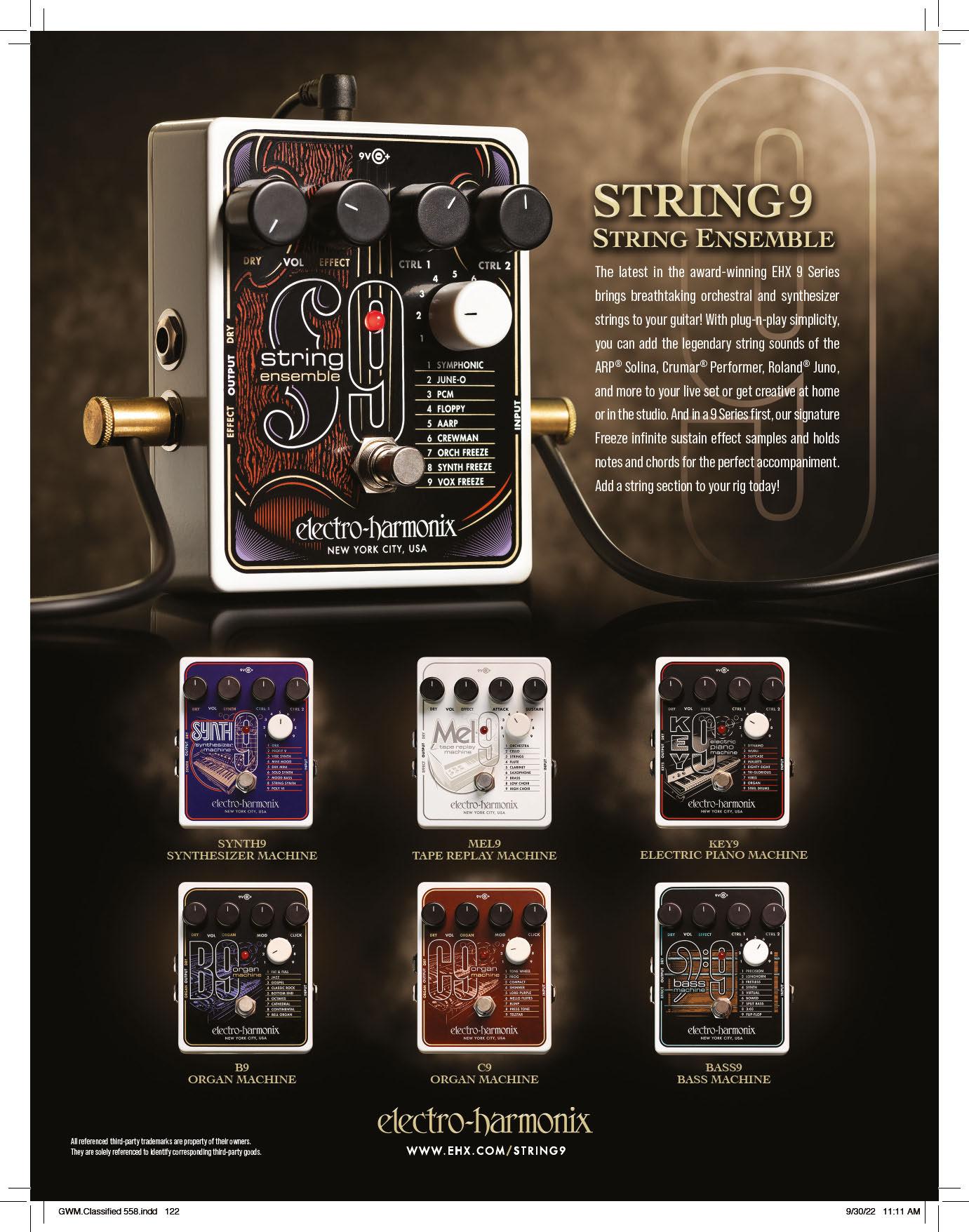“How do I view my influence on Metallica? It’s pretty deep!”
John Fogerty’s Creedence-era gear & glory
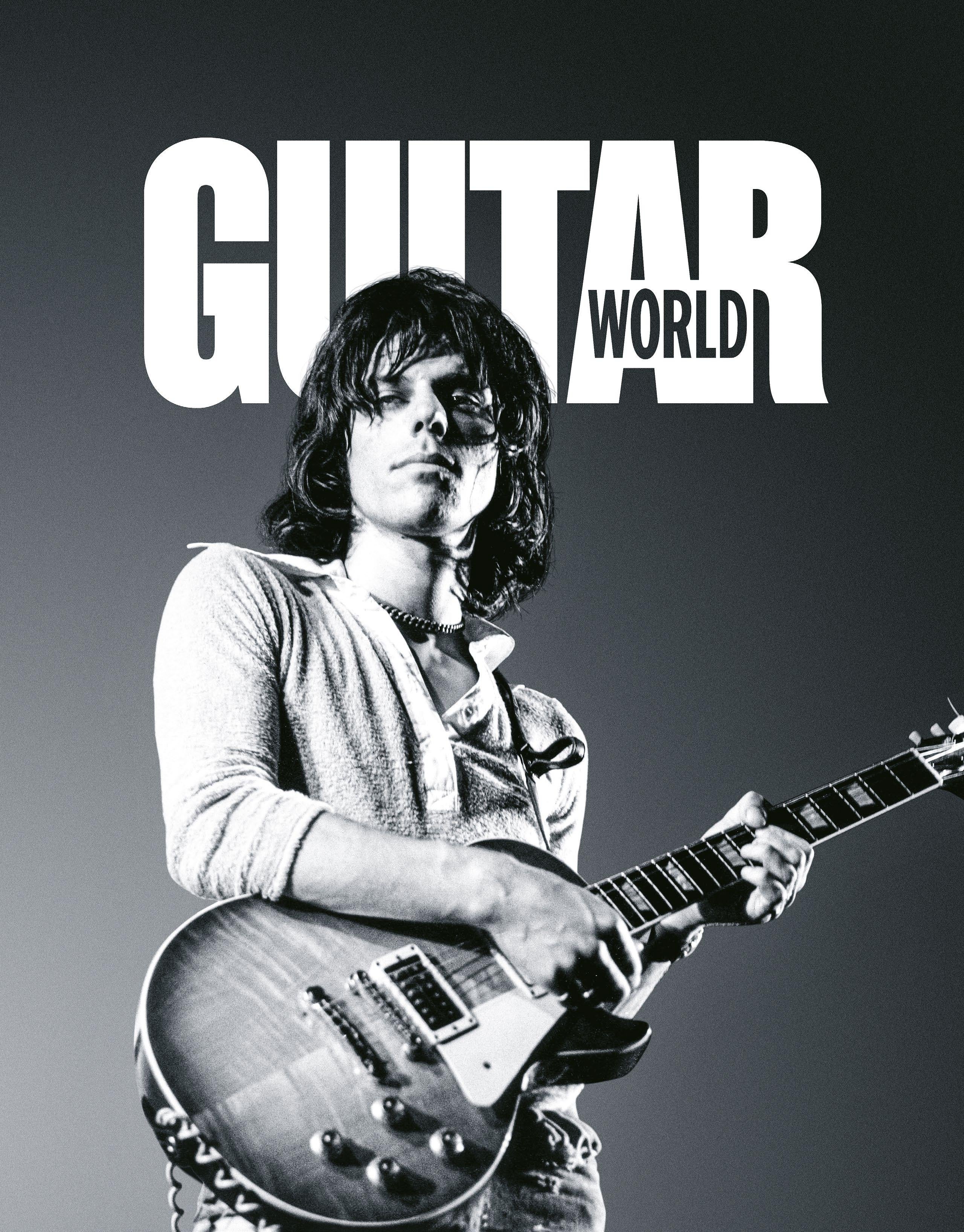
HALESTORM LOVE BITES (SO DO I)
BREAKING BENJAMIN BREATH
JANIS JOPLIN PIECE OF MY HEART

“How do I view my influence on Metallica? It’s pretty deep!”

HALESTORM LOVE BITES (SO DO I)
BREAKING BENJAMIN BREATH
JANIS JOPLIN PIECE OF MY HEART
1944-2023








The original flannel-clad rocker reflects on his CCR-era gear and the band’s famed 1970 Royal Albert Hall show
Megadeth’s main man discusses his influence over Metallica, the legacy of 1992’s Countdown to Extinction — and who gets his nod as Megadeth’s greatest-ever guitarist
One of the world’s greatest guitar heroes passed away midway through this issue’s production cycle, so we quickly changed gears and were able to bring you the following...
38: Farewell to the Guv’nor, Jeff Beck (1944-2023):

Longtime GW contributor Alan di Perna reminds us why Beck was truly one of a kind
44: Emotion & Commotion: Guitar greats pay tribute to Beck; featuring Zakk Wylde, Steve Vai, Joe Perry, Dave Mustaine, Eric Gales, Jennifer Batten, Brian May and more
54: Heart Full of Soul: In this candid, truthful and previously unpublished interview, Beck reveals the blues behind his 1999 comeback album, Who Else! — by Chris Gill
60: Guitar Shop: A closer look at 10 of Beck’s most historically important and personal favorite guitars
66: Deep Impact: A look at the often-overlooked recordings that reveal Beck’s genius and vision
72: Shapes of Things: Four guitar tricks you can learn from Beck’s Les Paul-fueled late-Sixties style — by Richard Barrett
14 DEFENDERS/READER ART
Imagine Dragons’ Wayne Sermon, Eddie 9V, John Primer, Built to Spill’s Doug Martsch (and his pedalboard), Kamelot’s Thomas Youngblood, Hannah Murphy and Narrow Head, plus Playlist, Introducing, the latest Guitar World flashback, photo of the month and more.
75. Hologram Microcosm
77. Victory Amps V1 Series: V1 Copper, V1 Duchess and V1 Sheriff
78. Kernom Ridge Overdrive
79. EarthQuaker Devices Sunn O))) Life Pedal V3
80. In Deep by Andy Aledort
81. Tales from Nerdville by Joe Bonamassa
82. Melodic Muse by Andy Timmons
83. Live from Flat V by Josh Smith
The Roland JC-120 is the most successful solid-state guitar amp, which is no mean feat considering the often unjust bias many musicians have had against solid-state amps. Its chorus effect was revolutionary; the world’s first chorus pedal — the Boss CE-1 — is essentially the JC-120’s chorus/ vibrato section housed in a pedal format.

BESIDES SRV, MY favorite guitarists when I was a whippersnapper in the Eighties were gents from the Sixties. Sometimes I’d be embarrassed by that because, when I’d extol the virtues of Clapton, Page, Hendrix, Mick Taylor and Clarence White, and spend days learning the Bluesbreakers’ “Hideaway,” “Steppin’ Out” and “Snowy Wood” note for note, I was often made to feel that I was living in the past. But I never felt that way when I told people that I loved Jeff Beck, because Beck — even though he was just as much “a Sixties guy” as, say, Dave Davies, Eddie Phillips or Hilton Valentine — always seemed as though he was from the distant future. Besides, his style and tone had evolved and changed so drastically during the years since the Sixties had ended — to the point that absolutely none of the popular Eighties guitarists that my friends worshiped had anything at all on Beck. He was timeless, a guitarist without “a decade” tied to his ankle like a ball and chain.
And then there are my own timeless Beck memories...
> November 11, 1989, Madison Square Garden, NYC: This was the first time I saw Beck live — and the last time I saw SRV, who died around nine months later. I’ll always remember this show because some idiot in the row behind me puked his guts out just inches away from my head. My brother didn’t tell me till later, which was probably a good idea. Beck, who was doing his Guitar Shop set, was on fire.
> June 9, 2010, Iridium/Ellen’s Stardust Diner, NYC: Yes, I was at Beck’s famous Rock ’n’ Roll Party (Honoring Les Paul) show — sort of. I had won tickets to watch the show on CCTV in the Fifties-themed diner directly upstairs from the Iridium jazz club. I later found out that Brad Tolinski, my future boss at Guitar World (who I didn’t know yet), was just a few tables away from me the entire night. I probably bumped into him on my way to the can!
> April 7, 2016, Electric Lady Studios, NYC: I was one of 30-ish lucky bums who got to attend a Loud Hailer listening session at the famous recording studio built by Jimi Hendrix, complete with a visit from Beck, who conducted a brief Q&A. During which, he implied that he didn’t want Loud Hailer to be a “guitar magazine album”; he wanted it to be for everyone. It took me a few days to “get it,” but I understood.
> January 19, 2017, the Observatory, Santa Ana, California: I was told there’d be a surprise guest at a special, invite-only show hosted by Gretsch — and, sure enough, it was Beck, blazing his way through his favorite Cliff Gallup guitar solos. There I was, covering the NAMM Show for the guitar magazine I read when I was a whippersnapper in the Eighties — and there was that timeless guitarist up on the stage.
SPEAKING OF TIME, it takes a while to get official approval for our song transcriptions, which is why there are no Jeff Beck songs in this issue. But please stay tuned!
— Damian FanelliWe are committed to only using magazine paper that is derived from responsibly managed, certified forestry and chlorine-free manufacture. The paper in this magazine was sourced and produced from sustainable managed forests, conforming to strict environmental and socioeconomic standards.
All contents ©2023 Future Publishing Limited or published under license. All rights reserved. No part of this magazine may be used, stored, transmitted or reproduced in any way without the prior written permission of the publisher. Future Publishing Limited (company number 2008885) is registered in England and Wales. Registered office: Quay House, The Ambury, Bath BA1 1UA. All information contained in this publication is for information only and is, as far as we are aware, correct at the time of going to press. Future cannot accept any responsibility for errors or inaccuracies in such information. You are advised to contact manufacturers and retailers directly with regard to the price of products/services referred to in this publication. Apps and websites mentioned in this publication are not under our control. We are not responsible for their contents or any other changes or updates to them. This magazine is fully independent and not affiliated in any way with the companies mentioned herein.
If you submit material to us, you warrant that you own the material and/or have the necessary rights/permissions to supply the material and you automatically grant Future and its licensees a license to publish your submission in whole or in part in any/all issues and/or editions of publications, in any format published worldwide and on associated websites, social media channels and associated products. Any material you submit is sent at your own risk and, although every care is taken, neither Future nor its employees, agents, subcontractors or licensees shall be liable for loss or damage. We assume all unsolicited material is for publication unless otherwise stated, and reserve the right to edit, amend, adapt all submissions.
GUITAR WORLD (ISSN 1045-6295) is published 13 times a year, monthly plus Holiday issue following December issue, by Future US, INC., 135 West 41st Street, 7th Floor, New York, NY 10036. Phone: 212.378.0400. Fax: 917.281.4704. Web Site: www.futureplc.com. Periodicals postage paid at New York, NY, and additional mailing offices. Newsstand distribution is handled by CMG. Subscriptions: One-year basic rate (12 issues) US: $17.95. Canada: US$42.95. Foreign: US$42.95. Canadian and foreign orders must be prepaid. Canadian price includes postage and GST #R128220688. PMA #40612608. Subscriptions do not include newsstand specials. POSTMASTER: Send change of address to Guitar World, P.O. Box 2024, Langhorne, PA 19047-9957. Ride-along enclosure in the following edition(s): None, Standard enclosure: None. Returns: Pitney Bowes, P.O. Box 25542, London, ON N6C 6B2, Canada. Entire contents copyright 2023, Future PLC. All rights reserved. Reproduction in whole or in part is prohibited. Future PLC is not affiliated with the companies or products covered in Guitar World. Reproduction on the Internet of the articles and pictures in this magazine is illegal without the prior written consent of Guitar World. Products named in the pages of Guitar World are trademarks of their respective companies. PRODUCED IN THE UNITED STATES OF AMERICA. SUBSCRIBER CUSTOMER SERVICE: Guitar World Magazine Customer Care, P.O. Box 2024, Langhorne, PA 19047-9957. Email help@magazinesdirect.com. BACK ISSUES: www.magazinesdirect.com REPRINTS: Future PLC, 135 West 41st Street, 7th Floor, New York, NY 10036.
EDITORIAL
EDITOR-IN-CHIEF Damian Fanelli (damian.fanelli@futurenet.com)
SENIOR MUSIC EDITOR Jimmy Brown
TECH EDITOR Paul Riario
ASSOCIATE EDITORS Andy Aledort, Chris Gill
PRODUCTION EDITOR Jem Roberts
MUSIC TRANSCRIPTIONIST AND ENGRAVER Jeff Perrin
CONTRIBUTING WRITERS Gregory Adams, Richard Barrett, Jim Beaugez, Joe Bonamassa, Joe Bosso, Nick Bowcott, Andrew Daly, Bill DeMain, Alan di Perna, Mike Huguenor, Mark McStea, Joshua M. Miller, Alison Richter, Sam Roche, Jenna Scaramanga, Josh Smith, Andy Timmons
ART
SENIOR DESIGN DIRECTOR Mixie von Bormann
ADDITIONAL PAGE DESIGN/LAYOUT Damian Fanelli
IMAGE MANIPULATION MANAGER Gary Stuckey
PHOTOGRAPHY CONTRIBUTORS Future, Getty Images and other individually credited photographers, public relations firms and agencies. All copyrights and trademarks are recognized and respected.
ONLINE
DIGITAL EDITOR-IN-CHIEF Michael Astley-Brown
DIGITAL ASSOCIATE EDITOR Jackson Maxwell
DIGITAL STAFF WRITERS Sam Roche, Matt Owen
VIDEO
VIDEO EDITOR Alan Chaput
CIRCULATION
HEAD OF NEWSTRADE Tim Mathers
PRODUCTION
HEAD OF PRODUCTION Mark Constance
SENIOR AD PRODUCTION MANAGER Jo Crosby
DIGITAL EDITIONS CONTROLLER Jason Hudson
PRODUCTION MANAGER Vivienne Turner
ADVERTISING
HEAD OF INDUSTRY: MUSIC Brian Preston brian.preston@futurenet.com
ACCOUNT EXECUTIVE Robert Dye 732-241-7437, robert.dye@futurenet.com
ACCOUNT EXECUTIVE Jeff Donnenwerth 678-427-1535, jeff.donnenwerth@futurenet.com
CONSUMER MARKETING
ASSOCIATE DIRECTOR OF AUDIENCE DEVELOPMENT Sheri Taubes MANAGEMENT
MANAGING DIRECTOR, MUSIC Stuart Williams
GROUP EDITOR-IN-CHIEF Scott Rowley
HEAD OF DESIGN (MUSIC) Brad Merrett
SUBSCRIBER CUSTOMER SERVICE
Guitar World Magazine Customer Care, P.O. Box 2029, Langhorne, PA 19047-9957, 1-800-456-6441

EMAIL: help@magazinesdirect.com, help@mymagazine.co.uk (renewals)
SUBSCRIPTION DELAYS: We rely on various delivery companies to get your magazine to you, many of whom continue to be impacted by Covid. We kindly ask that you allow up to seven days before contacting us — at help@magazinesdirect.com — about a late delivery.
SINGLE-ISSUE SALES: www.magazinesdirect.com/guitarworld
PRINTER Fry Communications
LICENSING Guitar World is available for licensing and syndication. To find out more, contact us at licensing@futurenet.com or view our available content at www.futurecontenthub.com.
HEAD OF PRINT LICENSING Rachel Shaw
GUITAR WORLD EDITORIAL/ADVERTISING OFFICES 347 W. 36th St., 17th Floor/Penthouse, New York, NY 10018
FUTURE US, INC. 135 W. 41st St., 7th Floor, New York, NY 10036, www.futureplc.com
©2023 Future PLC. All rights reserved. No part of this magazine may be used or reproduced without the written permission of Future PLC.

Holiday 2022 issue. Then I read the issue and counted up your choices. I must say I am stunned that Ty Tabor of King’s X was not among those listed. Known for his fiery fretboard mastery, guitar tone, songwriting and singing skills for over two decades — and not even an honorable mention? And he was beat out by the likes of St. Vincent? WTF? You guys owe him and all King’s X and Texas fans a major apology. Thanks for reminding [me] again why I don’t have a subscription to your mag.
— Stratamund
[Regarding “The 30 Greatest Texas Guitarists of All Time” in our Holiday 2022 issue] No Ty Tabor? Come on!

— David Franklin
As a Texas resident and guitar player, I was pleased to see the
Bring it on!
[Regarding the “Something Pantera-esque this way comes” news item in our January 2023 issue] I have heard the Zakk/ Pantera (Zakktera) rumors for years. I couldn’t think of anybody more capable or fitting to play
Dime’s riffs (and solos). It always made sense. But not just because they were so close personally. It’s the guitar playing, man! That vibrato and the harmonics. Stylistically, this is meant to be. I hope they hit smaller venues. Maybe off nights during the Metallica tour…
— Ron WhitemyerThanks for your feature on guitar tuners and apps in the December 2022 issue. I started seriously learning guitar about three years ago at age 36, so I closely follow recommendations when it comes to essential guitar gear. The nature lover in me especially liked that you highlighted a [Snark] rechargeable tuner, thus eliminating the need for batteries. Good job!
— Quintin Bynoe-OgleI’m 24 years old and love older hard rock and metal. If you could do a story on Dave Meniketti of Y&T or Agnus Young of AC/DC, I’d really appreciate it. I’ve been a subscriber for seven years and I never see much on my guitar-slinging heroes. If you could transcribe some Y&T songs, preferably anything from Earthshaker, Black Tiger, Mean Streak, In Rock We Trust or Down for the Count, that’d be great. Y&T was/is by far my favorite band, and most people only know them for “Summertime Girls,” which is a shame. It’s a good song and all, but their music from before that album [1985’s Open Fire] was really mind blowing. Dave Meniketti deserves some credit in your magazine. He is so underrated. Keep up the great work — the magazine is still wonderful.
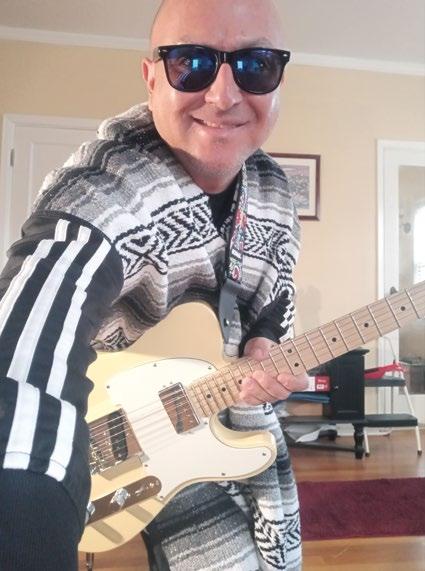 — Blades Harris (the Y&T fanatic)
— Blades Harris (the Y&T fanatic)
AGE: 57
HOMETOWN: Council Bluffs, IA (51501 Zip code!)
GUITARS: Ibanez Artcore hollowbody, Mexican Strat
SONGS I’VE BEEN PLAYING: Originals
GEAR I WANT MOST: Headrush, Rivera, Flying V, ES-335’s — natural, see-through butterscotch blonde, yellow, both sunbursts and wine red

AGE: 48
HOMETOWN: Riverland, South Australia, Australia
GUITARS: Squire, Schecter, Washburn and other pawn-shop specials

SONGS I’VE BEEN PLAYING: Jimi Hendrix
“Castles Made of Sand,” Metallica “Seek & Destroy” and my own tunes
GEAR I WANT MOST: Ibanez JS and Hendrix Voodoo Chile Strat
AGE: 52
HOMETOWN: El Paso, TX
GUITARS: American Performer Telecaster and Fender Player Stratocaster
SONGS I’VE BEEN PLAYING: James Brown “The Payback,” Led Zeppelin “Ten Years Gone,” Brothers Johnson “Strawberry Letter 23”
GEAR I WANT MOST: Vox AC15


NEWS, INSIDER UPDATES, STAFF REPORTS AND MORE!



If you’ve created a drawing, painting or sketch of your favorite guitarist and would like to see it in an upcoming issue of Guitar World, email GWSoundingBoard@ futurenet.com with a JPG or PDF of the image!



AGE: 27
HOMETOWN: Calgary, Alberta, Canada
SONGS I’VE BEEN PLAYING: Hellraiser, Cold Sweat and Judas Priest, plus recording original guitar and vocals with Nova 1, the band I co-founded
GEAR I WANT MOST: Dean Cadillac DCR6 Blackburst with a Floyd Rose
AGE: 37
HOMETOWN: Puebla, México
GUITARS: Epiphone Black Beauty, Jackson Adrian Smith SDX

SONGS I’VE BEEN PLAYING: Toto “Africa,” Metallica “The Four Horsemen” and “Slam” by my band, La Tatuza
GEAR I WANT MOST: Jackson RRX24 (black with yellow bevels), Boss CE-2W
AGE: 67
HOMETOWN: Atco, NJ
GUITARS: Taylor 314, Martin D15, Caramel CB103 (uke)
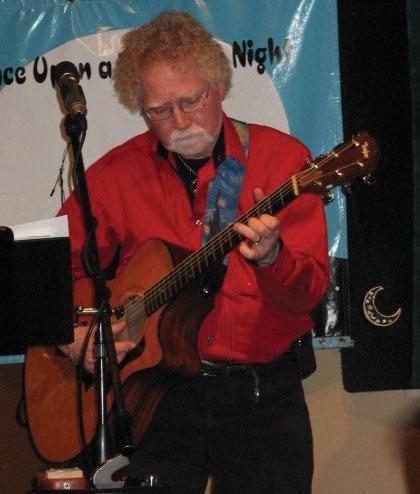
SONGS I’VE BEEN PLAYING: Oleta Adams “Calling You,” Nick Drake “Northern Sky,” Pat Benatar “Heartbreaker,” Once Upon a Full Moon Night “Straitjacket of Love”
GEAR I WANT MOST: Ibanez RG-550, Boss RV-6, Boss OC-5
Are you a Defender of the Faith? Send a photo, along with your answers to the questions above, to GWSoundingBoard@futurenet.com . And pray!

18
INTRODUCING
EDDIE 9V
PLAYLIST: AHAB 22
KAMELOT
IMAGINE DRAGONS GUITARIST WAYNE SERMON ADDRESSES

THE RICK RUBIN-PRODUCED MERCURY – ACTS 1 AND 2, AND HOW HE STILL GETS HIS GUITAR-SLINGER KICKS WITHIN A TIGHT POP/ROCK SETTING
By Mark McSteaBOASTING MONTHLY LISTENING figures of more than 53 million on Spotify alone, Imagine Dragons’ unique pop/rock blend has helped turn them into a global phenomenon. When they released Mercury – Act 1 in 2021, it had been their first album in three years, following up 2018’s Origins Mercury – Act 2, the second part of the project, came out last summer. The band’s extended absence didn’t seem to have impacted their success, although, according to guitarist Wayne Sermon, they never planned to be away for so long.
“We’d been planning to take a break in 2019, but then the world went crazy, and it became a much longer period off the road than we’d ever imagined,” he says. “We’d been recording almost non-stop, though, so we had tons and tons of music — over 200 demos. We recorded both albums at the same time, but it seemed to make sense to release the records in two parts.”
Is there still a lot in the can that hasn’t been released?
Oh lord, yes. [Laughs] We’ve been doing this band for about 12 years, and we do the same for every album where we write and record way more songs than we ever release. We’ve probably got about a thousand songs that have never seen the light of day.

Rick Rubin produced both albums. What did you learn from working with him? Every producer you work with brings something distinctive. When you think of the artists Rick has worked with — that discography — it’s just amazing. It was almost a little intimidating at first. We didn’t know what to expect, but even from our first phone call with him, his energy was just so much in tune with us as a band. He was really warm and kind, and we just gelled immediately.
Keyboards are a big part of the Imagine Dragons sound, and there are a number of songs where the guitar parts are very minimal. Do you ever feel frustrated — or feel the need to break out the shred?
[Laughs] Yeah, being in a band is really interesting. I studied guitar at Berklee, but it was mostly jazz, although I’d really been into rock before I went. I think the discipline of being part of an overall ensemble, playing jazz, really informed the way I approached being in Imagine Dragons. The most important thing is the song, and knowing what I can bring to the song — what will work best and what wouldn’t add anything to it. I started to think of the
guitar as being part of a greater whole.
What guitars did you use to record the album?
Recently I went on a bit of a splurge as far as buying guitars goes. I’ve always wanted to buy some really great guitars, so I went ahead and got some things that I’d always wanted. I got a red ’65 Strat, a ’56 goldtop Les Paul with P-90s and a ’61 ES-335. I also have a ’41 Recording King acoustic. I made the whole album with those vintage guitars.
“Take It Easy” has an anthemic feel. I can imagine it’ll be a great crowdpleaser at your shows.
It’s so funny you should say that, as I was actually just talking to Dan about this album yesterday and trying to figure out which songs we should play live, because when you have a big catalog of songs, you know people will be disappointed if you miss some things out, but you also want to play some new things. The one we both agreed on that we absolutely had to play live was ‘Take It Easy.’ I like the message of the song. Dan and I were raised in very strict religious households, where you never have any doubt. You know who god is, what’s going to happen when you die — all that kind of thing. But then over the years Dan and I have started to have questions about any kind of certainty in life, you know?
So what’s next? With so much music recorded, is there going to be a Mercury – Act 3?
“Blur” has some unusual tones, particularly on the solo. Was that a slide guitar? No. What that is — and it’s actually something we do quite a bit — is [vocalist] Dan [Reynolds] will sing something and put distortion on it and I’ll duplicate it with guitar, so the end result is a kind of unique blend. It all works well together in a strange kind of way.
No, there won’t be a final part. I think going forward we’ll always be releasing music periodically, at shorter intervals, keeping a steady stream of music going. I think we had the assumption that we could take a few years off and our fans would still want to listen to what we came up with when we came back, but I think it would be a very risky thing to do again. We really appreciate their support and can assure them that we definitely won’t keep them waiting as long in the future for new music.
Electric Mob
2 Make U Cry and Dance (Frontiers)
SOUND These old-school Brazilian rockers remind us of a golden era of metal when GN’R, Badlands and Mötley Crüe ruled the airwaves. Each cut on the album explodes from the speakers in a flurry of riffing guitars and epic solos. Ben Hur Auwarter knows every trick in the guitar-hero playbook — and he isn’t afraid to use them!
KEY TRACK “By the Name”
Dangereens
Tough Luck (Golden Robot Records)
SOUND Montreal’s Dangereens combine the swagger of Mott the Hoople and Aerosmith with the decadent edge of Johnny Thunders. Felix Brisson’s low-slung Les Paul sprays hook-filled solos, channeling the essence of street-cool rock ’n’ roll with a nod to Joe Perry and Mick Ronson — perfect for an album that plays out like a stack of old singles.

KEY TRACK “Streets of Doom”
Naut
Hunt (Seasons of Mist)
SOUND These U.K. rockers mix Eighties goth with dance beats and a dark, brooding metal sensibility. At times redolent of Killing Joke and the Banshees, they fuse hard, riffing guitars with synths and a drum machine. The result is a unique sound that updates their influences for the 21st century.

KEY TRACK “Unity of Opposites”
— Mark McStea“I think the discipline of being part of an overall ensemble, playing jazz, really informed the way I approached being in Imagine Dragons”
Eddie 9V with his Esquire. “All my friends were coming to school listening to rap, so they’re looking at me funny”

1
“Descent”
Esoteric
These guys from Birmingham are such a unique band! We’ve been fans from the very beginning. Their almost excessive use of vocal and guitar effects creates otherworldly atmospheres. It’s an honor to have Greg’s vocals on our new record.
2
TAKE ON A CLASSIC SOUTHERN SOUND
By Bill DeMainIN 2013, WHEN Eddie 9V was a high school senior, he’d pull into the school parking lot each morning in his secondhand Ford Explorer, blaring “Killin’ Floor” by Howlin’ Wolf.
“It was like my theme song,” he says with a laugh. “Meanwhile, all my friends were coming to school listening to rap, so they’re looking at me funny.”
For the 26-year- old guitarist born Brooks Mason Kelly (his stage moniker is a mash-up inspired by “mobster names and guitar pedals”), the feeling of being out of sync with the times started when he was 14. “I saw a YouTube clip of Howlin’ Wolf at Newport in 1966. He had that big old Firebird with the slide and was doing ‘Meet Me in the Bottom.’ Man, seeing that made me want to just dive into the blues!”

And he did, studying licks by legends like Michael Bloomfield and Freddie King (“I went for the spirit more than exact notes”), while cutting his teeth in clubs around his native Atlanta. His 2019 debut, Left My Soul in Memphis, and follow-up Black Flies, both D.I.Y. recordings, had plenty of raw grit and searing licks. But when it came time for his new album, Capricorn, Eddie wanted a bigger sound. So he booked an 11-piece band into Macon’s legendary Capricorn studio.
“It felt like we stepped into 1969,” he says. “It was this time warp same board, echo chambers, mics, the same carpet
where the Marshall Tucker Band stood everything down to the ashtray that Duane Allman put out a cigarette in. We cut the album live in two days, the same way they would’ve back then. It was magical.”
And standout tracks like “Yella Alligator” and “Tryin’ to Get By” radiate the honeyed warmth and immediacy of vintage records, while expanding Eddie’s songwriting palette from straight blues into more sophisticated Southern soul. He says, “Blending the elements blues, soul, country, church. That’s the mentality of it.”
“Sugar for the Pill”
Slowdive
This song demonstrates our love for large reverbs and other time-based effects. At Rama Studios in Mannheim we used a real vintage plate hall during the recordings of “The Coral Tombs.” The plate was around 2-by-2 meters. Great and special sound!
3
“Der alte Feind (Jeder Tag reißt Wunden)”
Ultha
Highly atmospheric and meditative black metal from Germany with interesting guitar work, great use of pedals, sax and very interesting production. By the way — the singer, Chris Noir, opens our album with his haunting screams.
4
“Tokyo Dream”
Allan Holdsworth
Holdsworth is known for his stretchy chords, which inspired — to some extent — the clean guitar part in “Mobilis in Mobili” from our new album. We also found some new love for chorus pedals, thanks to Allan. On our recordings we used a Roland Jazz Chorus combo, though.
5
“Into Death”
Carrion Mother
In keeping with the retro vibe, he’s been paring down his gear. “I play a Fender Custom Shop Esquire. I used to have all the pedals and stuff, but these days, with the music I play, I run my Esquire directly into a 1980s Music Man amp. It’s 50 watts, super loud, with great mid-range distortion. That’s my whole setup. One thing I learned from the great blues players it’s more about what’s in your heart and soul.”
These guys once told us they founded their band after attending one of our shows. What bigger compliment can you get? Especially as this is well-composed, heavy stuff — and the sound of the recording is amazing!
AHAB’S NEW ALBUM, THE CORAL TOMBS, WAS RELEASED JANUARY 13 ON NAPLAM RECORDS.

“One thing I learned from the great blues players — it’s more about what’s in your heart and soul”
THIS SOUTH SIDE CHICAGO VETERAN — WHO HOLDS THE DISTINCTION OF BEING MUDDY WATERS’ LAST LEAD GUITARIST — STEPS OUT ON HARD TIMES
By Jim BeaugezCHICAGO BLUESMAN JOHN Primer earned his musical education the hard way, playing long sets at blues clubs on the city’s South Side up to seven nights a week. But that training helped him earn plum gigs with legends Willie Dixon and Muddy Waters.


Not long after joining Dixon’s band in 1979, Primer traveled with them to Mexico City, where Waters took a shine to his playing. “He asked Willie, ‘Who’s that young man playing your guitar? Where’d you get him?’ ‘Oh, he works at Theresa’s Lounge.’ He said, ‘That man sure knows my music.’”
Waters was right on the money — Primer had learned his early acoustic music, and later his electric blues style from the 1971 album Live (At Mr. Kelly’s). Like Waters, he had moved up from Mississippi, where he had lived on a sharecropping farm until age 18. When Waters’ band quit in 1981, the “Hoochie Coochie Man” tracked down Primer at Theresa’s and offered him the lead guitar spot.
Primer accepted in time to participate in the famed gig where the Rolling Stones backed Waters, immortalized on Live at
the Checkerboard Lounge, Chicago 1981 “Everybody was tore up that night — even Muddy was feeling good,” Primer says. “Keith Richards passed me a cigarette. I don’t even smoke. I should have kept that cigarette.” [Laughs] Richards and Ron Wood watched Primer and followed his lead, which gave Primer a thrill. He played with Waters until his untimely death in 1983 and started his own solo career in 1991
with Poor Man’s Blues
Hard Times, Primer’s 13th solo studio album, is informed by decades spent woodshedding his guitar licks with the masters and leading his own band. Echoing the playing traditions of Elmore James, B.B. King and Luther Allison, Primer rips through roadhouse blues on “Don’t Wait Too Long” and “Chicago,” swings on “Tough Times” and “All Alone,” and leans into the country blues of his early years on the title track. Ever the purist, he does it all without the aid of effects.
“I learned how to play blues on my own, and I didn’t have no foot pedals,” he says. “I tried the Cry Baby wah-wah pedal [and a] phase shift, [but] the blues guys said, ‘Hey, you throw that thing in the garbage and go somewhere and jam and get your sound.’ [Now], a lot of [players] use it for playing blues — I guess to make it sound different — but when they go to their wah-wah pedals, it’s all rock ’n’ roll.”
“Everybody was tore up that night — even Muddy was feeling good. Keith Richards passed me a cigarette. I don’t even smoke. I should have kept that cigarette”
WHAT THE BUILT TO SPILL MASTERMIND SEES WHEN HE LOOKS DOWN
 Interview by Mike Huguenor
Interview by Mike Huguenor
“I GO TO a wah first [Vox V847], then to my [TC Electronic PolyTune 3] tuner. Then I go to three Xotic EP Booster pedals — and that’s it for my overdrive, fuzz or distortion. They have a softness that I like. It sounds more like rock than metal, even when I have all three of them on.
“I turn one on set kind of low. That one is just sort of a nice, fuller, tiny bit of grit guitar. The second one is turned up a little bit more. With the two together it becomes like a rhythm distortion. The third EP Booster is cranked all the way up. When I step on that with the other two, I have my fuzz for soloing.
“The next thing is a phaser [EarthQuaker Devices Grand Orbiter]. I have it turned pretty mild. I was listening to some old live Clash song and the whole mix was out of phase, and it just sounded so great. I thought it would be nice to have a little bit of that every once in a while.
“The last thing is the tremolo [Suhr Jack Rabbit]. There’s maybe one song where I use it all the time, then I hit it every once in a while to change things up.
“And then I go to the echoplex. It’s not on my pedalboard; I have it on a stand next to me. That’s kind of my go-to for basic delay and also the crazy stuff and wild effects. I have mixed feelings about this piece of
equipment.” [Note: While it seems Martsch is using “echoplex” as a generic term for tape echo, recent videos and photos — including the one above — show him playing through a Fulltone Custom Shop Tube Tape Echo.]
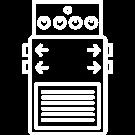

■ IF I HAD TO CHOOSE ONLY ONE PEDAL FOR A FULL SHOW: “[An] Xotic EP Booster because I can’t play without some kind of overdrive.”
Wanna see someone’s pedalboard? Let us know! Write to GWsoundingBoard@futurenet.com.

THOMAS YOUNGBLOOD ON THE MAKING OF THE AWAKENING — AND THE JOY OF HAVING SOME EXTRA FRETS TO BITE INTO
By Gregory AdamsACROSS 35 YEARS of music-making with Kamelot, founder Thomas Youngblood has learned that guitar style comes from your hands, not your hardware. Even so, when the power metal veteran is reached by Guitar World to talk up The Awakening — Kamelot’s first studio full-length in five years — he’s excited to report that by the time the act head out on their U.S. summer tour, he should be ripping out the record’s choicest riffs on a brand-new ax, courtesy of ESP.

“I’m using ESP Eclipses for the most part, [but] they’re making me another
AXOLOGY
• GUITARS Custom ESP Eclipse, Custom ESP Horizon
• AMPS/EFFECTS Kemper (modeled after an EVH 5150)
custom, a Horizon. I’m going to be able to have a few more frets for the live show than I’ve had with the Eclipses,” he says, noting how the bespoke neck-through will additionally be scalloped from the 12th fret up, and sport a flatter neck profile than a stock Horizon. “I just figure that if I’m going to have those extra frets, I’ll be able to bite down a little harder on those higher notes [due to the scalloping]. It’ll be easier to play.”
That’s not to say Kamelot’s path to The Awakening was similarly streamlined. The logistical challenges of recording through the pandemic, for instance, pushed the album’s planned 2020 due date well into 2023. But the delay likewise pushed Youngblood to reconsider the way he integrated with the lush and symphonic backdrop of Kamelot. He notes that he structured solos differently, bringing an Eastern new age flair to the wide vibrato of first single “One More Flag in the
Ground”; he cedes shred duties to guest cellist Tina Guo on “Opus of the Night (Ghost Requiem)”; and he explores a percussively progressive heaviness via the compound judding of the album’s intense “My Pantheon (Forevermore).”
“We always want to put a song on there that challenges the listener to enjoy something a little bit heavier, with some dark vocals,” Youngblood says of the latter growl-imbued track, adding, “It’s super heavy, and it’s even got some black metal elements, but the solo is pretty melodic — it’s not shredding.”
While Youngblood’s certainly got chops, he’s happier to serve the song alongside his bandmates, making Kamelot a true round-table endeavor. “I really never go into any of these things trying to be a guitar hero,” he says, adding with a smidge of guitar-based glory, “but I think there’s definitely some cool stuff [on the album].”
“I really never go into any of these things trying to be a guitar hero”
— THOMAS YOUNGBLOOD
THE HOUSTON-BASED ALT-METAL/SHOEGAZING PEDAL PUSHERS PUT ON AN IMMERSIVE TONE CLINIC ON THEIR LATEST RELEASE, MOMENTS OF CLARITY
 By Gregory Adams
By Gregory Adams
THE FACT THAT Houston’s Narrow Head have a song called “Gearhead” on their latest album, Moments of Clarity, is no surprise. Throughout its 12 songs, vocalist-guitarist Jacob Duarte and guitarists Kora Puckett and William Menjivar put on an immersive tone clinic, obliterating a mix of alt-metal grooves and shoegazing melodies with amber washes of fuzz, flanger and more. Duarte’s tastes, in particular, lay with the workhorses, the guitarist generally linking together a series of Boss pedals instead of something boutique — the kind of stuff you’re not worried about scuffing up, whether playing D.I.Y. dives or festival stages.
“I think the first pedal I ever got was a Boss Digital Delay, super non-expensive,” Duarte says. “I tried to get into the vintage, boutique stuff when I was 19 or 20, but
it’s kind of dumb to do. It’s expensive! It sounds good, but I’m not playing at church, you know what I mean?”
“Sometimes it’s fun to chase vintage pedals,” Puckett concedes. “Like, I have the same op amp Big Muff that Billy Corgan used, but the majority of the fuzzy tones [on Moments of Clarity] are not from that.”
Moments of Clarity fittingly revels in the feel of Nineties-era Smashing Pumpkins (“Break Up”) and Hum (“The Real”), while retaining the scrappy edge Narrow Head’s members honed in various hardcore bands. On their latest album, Puckett says Narrow Head pushed those poles to the extreme by writing “poppier pop and heavier heavies.” They manage both feats, whether spooning stacked fifth sweetness into “Caroline” or compressing spines with “Trepanation,” a pummeler that plunged the group’s general
• GUITARS Gibson SG Standard (Duarte); Les Paul Studio (Menjivar); Gibson SG Standard, Jackson Soloist (Puckett)
• AMPS Music Man HD-150 with Mesa cab (Duarte); Vox AC30 (Menjivar); ’73 Marshall JMP Super Bass, Fender Bassman 50, Sovtek MIG 50 (Puckett)
• EFFECTS Boss BD-2 Blues Driver, Electro-Harmonix Big Muff, Boss equalizer, Hardwire CR-7 Stereo Chorus, Boss BF-3 Flanger, Boss DD-3 Digital Delay (Duarte); Fulltone OCD, modded Boss fuzz, Johnson SC-2 Stereo Chorus, MXR Carbon Copy, Boss BF-3 Flanger (Menjivar); Way Huge Green Rhino, ’91 ProCo Rat (big box), ’79 Electro-Harmonix Big Muff Pi
drop C# tuning down to a sub-sonic drop Bb (“We just kept going down until the melody fit,” Duarte says).
While Duarte tracked all the guitars on 2020’s 12th House Rock, Menjivar and Puckett harmoniously integrated themselves into the mix for Moments of Clarity The trio are prone to rotating rhythm and lead duties, sometimes pushing Duarte’s tone-bent scale work to the forefront, other times Puckett’s octave-driven soaring. Of their newly amorphous roles, Duarte concludes: “I wouldn’t say it’s a free-for-all, but we [each] do our own thing.”
“I tried to get into the vintage, boutique stuff when I was 19 or 20, but it’s kind of dumb to do. It’s expensive!”
— JACOB DUARTE
GREEN DAY, WEEZER AND BLINK-182 ARE GREAT AND ALL, BUT THERE’S JUST SOMETHING ABOUT JOHANN KASPAR MERTZ, FREDERICO MORENO TORROBO AND MANUEL PONCE
By Joe BossoIN HIGH SCHOOL, Hannah Murphy wasn’t much different from other teenagers. She played electric guitar while listening to CDs of pop-punk bands — Green Day, Weezer and Blink-182 were her favorites. But there was another side to her, one that involved playing nylon-string guitar to classical pieces by composers such as Johann Sebastian Bach and Béla Bartók. Before long, it became her true passion.
“I liked playing electric, but I felt more of a bond with the nylon-string guitar,” Murphy says. “And I truly connected to
classical music. Maybe it’s because I’m kind of introverted. There’s such intimacy in playing classical music by yourself. I could lose myself in it.”
At first, Murphy wasn’t sure about pursuing a career as a classical guitarist, but she changed her mind after seeing clips of Croatian-born classical guitar star Ana Vidović. “That was a revelation for me,” Murphy says. “Here was this young and beautiful woman playing the music I loved. And I thought, ‘Okay, maybe I can do it, too.”
After earning bachelor’s and master’s degrees in classical music performance (from Rowan University and Mannes School of Music, respectively), Murphy settled in Brooklyn, where she began teaching privately. In recent years, she’s emerged as something of an internet star — her exquisite solo guitar videos of “Recuerdos de la Alhambra” (Francisco

Tárrega) and “El Testament d’Amelia” (Miguel Llobet) have racked up tens of thousands of views. “It’s pretty astonishing, the way the videos have taken off,” Murphy says. “I just pick compositions I like, and I put them out there. People have responded so well, so I’ll keep at it.”
On her debut album, A Dream in the Forest, Murphy’s breathtaking talents are spread across selections by Johann Kaspar Mertz, Frederico Moreno Torrobo and Manuel Ponce, among others. The entire set — self-produced and recorded in her living room — was made possible via a crowdfunding campaign. “Anyone who sent in money would automatically receive a copy of the album,” Murphy says. “It was a lot of work putting the record together, but it was a great experience. And now I want to make more records. Everything I do is trial and error, but I learn as I go.”
“There’s such intimacy in playing classical music by yourself. I could lose myself in it”
“It’s my understanding that Jim [Irsay, Indianapolis Colts owner] and his team have done very little, if anything, to change the guitar from how it was when David Gilmour owned it.
“We all know that guitar setups are player-specific, so that means the black Strat was not necessarily set up the way I would set up my guitars, but in this situation, it’s not for me to make any changes to the instrument. It’s my job to adapt to the guitar and make the very best of it that I can. Thankfully, the way David likes his guitar set up doesn't seem to be too far off from how I have mine, so it was not so much of a struggle, and that enabled me to be more in the moment with the music.”
— Andrew Daly“[The] line is getting progressively blurred during the internet age, when you suddenly have a ton more musicians competing for the same eyeballs. The problem is we have a situation where, algorithmically, we’re having to catch and maintain people’s attention in the shortest possible window. The net result is music that doesn’t really sound like a journey, doesn't really sound like an experience, but it sounds like a slap in the face because it has to, in order to grab people’s attention. This is where I see electric and acoustic guitar right now: heavily edited, very engineered to engage, snippets of sound. Now, because I’m a live guy and I’ve always enjoyed being on the road, you can’t get away with that and hold people’s attention for more than that initial ‘wow,’ so my material has to, by definition, be engineered for a longform journey. It has to bring people up, it has to bring people down, it has to make people laugh, it has to make people cry.” — Alison Richter
From GuitarWorld.com
INour February 1990 issue, Zakk Wylde [left] listed his five favorite albums of the Eighties — and his five favorite Ozzy Osbourne [right] “guitarist critiques.” It went a little something like this...

1. GUNS N’ ROSES APPETITE FOR DESTRUCTION
2. ERIC JOHNSON TONES
3. JOE SATRIANI SURFING WITH THE ALIEN
4. YNGWIE MALMSTEEN ANYTHING!
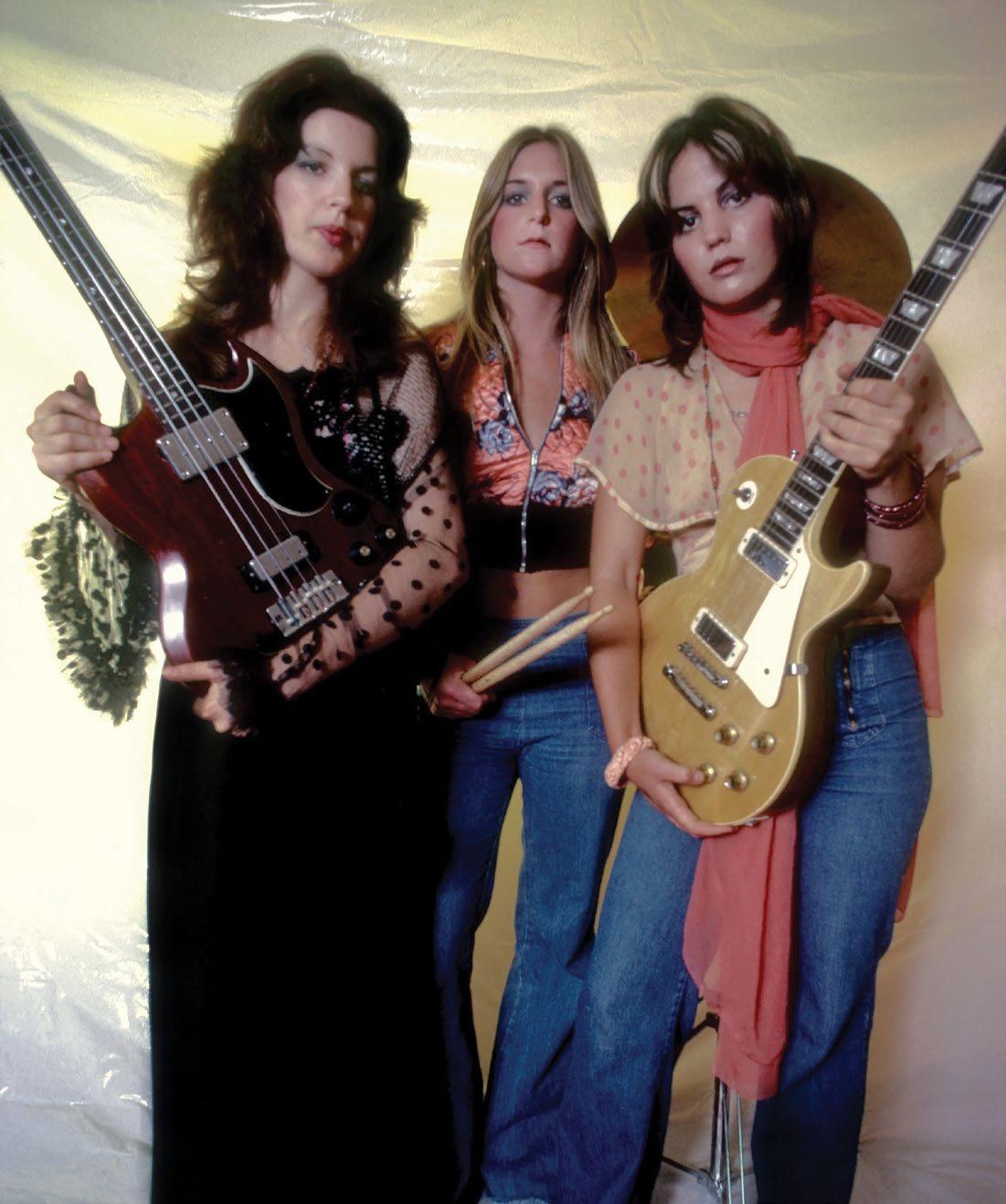
5. OZZY OSBOURNE DIARY OF A MADMAN
1. “That guy sounds like someone falling down the stairs.”
2. “That guy sounds like Yngwie Malmsteen on acid.”
3. “Wah-wah? Who do you think you are — Jimi Hendrix?”
4. “That’s way too weird — this isn’t Frank Zappa.”
5. “No country!”
From the February 1990 GW
Iron Maiden have been honored by Royal Mail, the U.K.’s postal service, with a new range of postage stamps. The “bona fide rock legends” — as Royal Mail describes Bruce Dickinson & Co. — now feature on 12 unique stamp designs for 2023, in the company’s fifth run of stamps dedicated to British music acts, after the Beatles in 2007, Pink Floyd in 2016, Queen in 2020 and the Rolling Stones in 2022.

Eight of the 12 stamps show photos of the band — with all members featured, including Dickinson, guitarists Dave Murray, Adrian Smith and Janick Gers, bassist Steve Harris and drummer Nicko McBrain — while four stamps [shown above] depict various iterations of the group’s mascot, Eddie. Live shots range from 1980 to
2018 and feature a photo from the band’s 1983 gig in Hammersmith, one from their 2008 show at Twickenham Stadium and various other group photos.
“We were all absolutely astounded — in a good way — when we first heard about the project, and equally pretty much speechless when we saw the stamps for the first time,” Harris said in a press release. “They look superb and really capture the essence and energy of Maiden.” The band’s manager, Rod Smallwood, added: “As a band who have never played by anyone else’s rules for over 40 years, it’s very gratifying to see them honored in their home country in this way.” For more information, check out royalmail.com.
— Sam Roche

JOHN FOGERTY HAS performed overseas many times throughout his career. But there is a mythical quality to his first tour of Europe in 1970 with his band, Creedence Clearwater Revival. In particular, the band’s April 14, 1970, show at the Royal Albert Hall is one of his favorite memories.
At the time, CCR — which also included John’s brother (and rhythm guitarist) Tom Fogerty, bassist Stu Cook and drummer Doug Clifford — were speedily making a name for themselves, already with five Top 10 singles in their first year together. Hits including “Proud Mary,” “Bad Moon Rising,” “Green River,” “Fortunate Son” and “Down on the Corner” showed off the band’s raw, high-energy, no-compromise
rock ’n’ roll and tight chemistry. The attention and success while touring the U.S. earned the band their first European tour. One of the shows was at the Royal Albert Hall, one of London’s most respected venues. The Beatles and the Rolling Stones were among the British groups that had performed there, and when CCR performed, it was just days after the Beatles had announced their breakup.
BY JOSHUA M. MILLER
“I was writing songs like a maniac,” Fogerty says. “By the time we got to Europe, there’d already been four or five hit singles, meaning in most cases, both sides, and also maybe three or four albums by then. It was like a whirlwind… Getting to play the Albert Hall was certainly an honor. That was at a time when the band was still mostly positive and happy to be there. And all the energy was in a positive direction.”
This past September, Craft Recordings, a sub label of Concord, released a live album of the concert, Creedence Clearwater Revival at the Royal Albert Hall, as well as a companion documentary and concert film, Travelin’ Band: Creedence Clearwater Revival at the Royal Albert Hall
The concert’s audio was mixed by the Grammy-winning team of producer Giles Martin and engineer Sam Okell and mastered by Miles Showell at Abbey Road Studios using half-speed technology. The concert film is directed by Bob Smeaton and narrated by the Dude himself, Jeff Bridges. The film focuses on the band’s earliest years in El Cerrito, California, through their rise to fame, culminating with the Albert Hall show. It’s the only concert footage of the band’s original lineup to be released in its entirety.

After 50 years of sitting in the vaults, fans are now able to revisit the concert. “I’m very happy for the fans,” Fogerty says. “It’s good that it’s finally coming out and that [people] can see it.”
GW recently caught up with Fogerty to reflect on the concert, the guitars, the amps and so much more.
How does the audio from the album release compare with what you remember about the show?
It doesn’t sound as clear as I remember it. But back in the day, I did not listen to the audio. There was another album around that time that was recorded in Oakland [The Concert, recorded January 31, 1970]. I produced that, even though I didn’t get credit for it later when that album came out. But the sound was done very well on that one. This one sounds very live. It’s not as clear as what I remembered in my mind’s eye, but it’s exciting. The performances are good.
What was the experience like going to Europe in your twenties with CCR?
We did just a manic, lightning-speed [trip] across Europe. We’d go from one country to another, the same way here in America, you go from Nevada to Arizona to Colorado to Chicago. It was just amazing for an American to go there. I’m talking about a 24-year-old person. Half of your knowledge was in musical terms, but a lot of your knowledge was in historical terms, things you’d read about in school, or on your own, or seen in movies, that sort of thing. So you had very little snippets of information about each country. But, of course, you weren’t there long enough to really even get a sense of each country. Staying in one country, basically on a stage and in a hotel room for two days and then moving to the next country, really doesn’t give you much of a sense of what’s going on there.
The guitars sound really great. What can you tell me about the gear you used for the show?
[Tom and I] were playing through Kustom amps. Tom had a Kustom with a cabinet that had one 15-inch JBL [speaker] in it. And those were D130 outs, which is probably still the best rock ’n’ roll speaker ever made — and it hasn’t been made since. I was playing a Kustom K200A[-4], which was an amazing rig. It was roughly 100 watts and was solid state, but it was probably the best-sounding solid-state amp ever made. It didn’t sound hard and cold and sterile the way so many other solid-state amps of that era sounded. And I’m just talking about when I used it clean… That amp had four effects built in; one was reverb, which I never used. It had a little remote pedal that you plugged in with a cord, and it had four buttons on it.
The reverb button, I’d just click it on and off to make sure the reverb was off, because the amp was louder when the reverb wasn’t used. If you pressed reverb, the amp got a little quieter, and I didn’t want that. I felt there was enough reverb in the big room; I didn’t need to add more. But the other things — I used all of them. They were wonderful. It had what they called a harmonic distortion. It was basically a buzz tone, but it was built in. It didn’t come in front of the amp, the way you’d have to plug in, let’s say, a Maestro fuzz tone at the time. Another gizmo that was built in was a treble tone-control thing. And it clicked to, I think, five different positions, like the way a Gibson — is that an ES-355? — the way they’d have had that little chickenhead knob that you could click to the different numbers.
It had resistors built in that changed the sound. That’s what this thing on the Kustom amp did. I didn’t use it too much. The only time I ever used it, I think it was on “Keep On Chooglin’.” It gave it sort of a nasally “honky” kind of a sound on one of the selections. Mostly I just like what a guitar sounded like straight into an amp. But by far for me, the most mind-boggling effect was the fourth one, which was a vibrato-tremolo effect — and you could blend between tremolo and vibrato. I didn’t want to use too much vibrato, vibrato meaning pitch-bending, so I’d turn it to the right a little bit, which was less vibrato and more tremolo, which is a volume effect.
It would sound like a normal tremolo, but with the addition [of] a little bit of this kind of a spooky sound that came out of vibrato. It was a blend, and they were on the same clock, happening at the same time. They weren’t two completely unrelated sounds. I used that sound on “Born on the Bayou” and “Midnight Special.” There are so many songs I recorded plugged into
that amp, using that vibrato-tremolo thing. Then I spent the next 45 years trying to get someone to replicate that.
For the [Albert Hall] show, I was playing my Rickenbacker 325 that I had heavily modified. I’d put a Bigsby [B5] on it. I’d put a Les Paul pickup in the bridge position. I had put better tuners on it. And I had modified the knobs so that I had a master volume control. That guitar gave a very unique sound — if you listen to the beginning of “Green River,” particularly the single. I was also playing a black Les Paul Custom that I tuned down a whole step, down to the key of D. I did that because when I was growing up, I experienced a lot of folk music, especially Lead Belly, who played a 12-string, and he did that low tuning.
That’s where I wanted to go with a Les Paul. The first time I ever tuned one down in a music store, [I] plugged it into a Fender Twin. I struck that first chord, which was an open E, which was coming out open D, and it made this incredibly wonderful sound, which is the basis of, let’s say,
the best example of that. Because as much as I love Steve Cropper or Booker, I just felt that their real strength was how they sounded together. No one’s ever put up a groove the way Booker T. & the M.G.’s did. I think that remains the Mount Rushmore to strive for.
What surprised you most while watching the documentary?
It’s an incidental thing, but you’re looking at people who basically have left their hometown probably for the first time. At that point, we’d been all over the states but had never been to Europe. I think we sound typically colloquial, almost hillbilly, meaning we tend to say things that very young people say, not very sophisticated, really. And that surprised me. It was a quaint discovery. Because after you live another 50 odd years, hopefully you’ve learned a thing or two and had some experiences. And I know that just seeing myself, I go, “Oh.” I hear a question and I go, “Oh, well. Yeah, that answer sounds a little silly.”
If you ever saw the movie Bull Durham, where the grizzled old veteran is trying to teach the young kid how to give baseball answers. And he just fills his head with cliches, like, “Well, it’s a game of inches,” stuff like that. And those are baseball cliches. And some of the stuff that Creedence answers in that film, sounded like rock ’n’ roll cliches to me.
“I THINK MUSICIANS, ESPECIALLY GUITAR PLAYERS, TEND TO BE A HUMBLE BUNCH BECAUSE IT’S SORT OF THE WILD WEST. THERE’S ALWAYS SOME GUY LOUDER AND FASTER AND GOING TO CALL YOU OUT IN THE STREET — AND IT’S JUST A MATTER OF A FLIP OF A COIN IF YOU GET BUSHWHACKED”
“Proud Mary,” “Bad Moon Rising,” “Lodi,” “Heard It Through the Grapevine” and so many others. It’s one of the more wonderful sounds I’ve been able to make.
In the documentary, you made a comment about not feeling you were the greatest musician. Why do you think you felt that way?
I didn’t feel that I was a virtuoso on guitar. I did feel I knew how to get a sound out of my instrument, which was pretty important. I had spent a lot of time in recording studios before Creedence existed, either with myself, or with some of the members of the band that became Creedence, or even with other people, and became very aware of what things sounded like. I think musicians, especially guitar players, tend to

be a humble bunch because it’s sort of the Wild West. There’s always some guy louder and faster and going to call you out in the street. And it’s just a matter of a flip of a coin if you get bushwhacked. So, the things that I knew are what I knew. And I liked how I sounded, but I also assumed that there were a lot of people running around that were better than me — and cooler than me and all the other stuff. I felt very comfortable within my own band.
I certainly felt that the other guys in my band, while we were good together, I didn’t think any of us was, let’s say, the best in the world, or even in our own country or our own state, at what we were doing. To me, that didn’t matter. I thought it was much more important to sound good together. And I always used Booker T. & the M.G.’s as
You have a pretty impressive collection of guitars. What’s your favorite at the moment?
I have a European-made Les Paul [-style guitar] that I got a few years ago, before Gibson sort of turned around, got their act together. It’s one of the most wonderful Les Pauls I’ve ever played. Recently, I was trying very hard to get a whammy on a Les Paul and be able to do all the stuff like I was doing back in 1969 or so, when I put a whammy on one of my Les Pauls.
You’ve played a lot lately with your sons, whether as part of your show or having their band, Hearty Har, open for you. What have you enjoyed most about playing with them?
First of all, every parent loves to interact with their children. You start that from the day they’re born. Having my sons grow up loving music and being musical was a true joy for me and my wife Julie. To be able to be on stage with the kids now as really great musicians, it’s a dream for me. I get a big kick out of playing the songs I’ve written, like “Proud Mary” and “Bad Moon Rising,” with my kids. Because we share DNA, there’s certainly a special understanding of how the music should go.
As any parent will tell you, you love watching your children learn and become better at the things they find joy in. I love watching them play with Hearty Har. To be watching them with their band, and then have this film from me and my band from 50 years ago when I was roughly the same age as they are now, it’s a special way
of looking at everything. It’s kind of surreal knowing I was on stage at that age with my bandmates, including my brother Tom. Being in a band with my brother was a wonderful thing; the whole thing felt like family to me. It was two guys whom I had gone to school with since eighth grade — and my brother Tom.
At the time Royal Albert Hall was filmed, it was probably the absolute height of Creedence. It was all positive, it was all wonderful. It was almost pure, like a new snowflake falling from the sky. It was a wonderful feeling. The Beatles — whom we had all grown up with — had broken up just days before, so the entire music industry was shocked. My brother Tom had walked into a hotel room where I was giving an interview and broke the news he had heard on the radio.
What’s next for you? How is the new material sounding, especially guitarwise?
I’m very excited to be making new music, especially now that I seem to have found the core of a great recording band. Artists of any kind go through some interesting times, sometimes strange times. If they’ve already created some works that are worthy, sometimes they find themselves in another part of their lives with a blank page, which is where I’m at today. I practice guitar ferociously. I’m grateful God allowed me to keep going with my love of guitar. It didn’t end when I was 15, and it didn’t end when I became famous. I love being able to see my own progress on the instrument I love. Hopefully, that mindset will be heard throughout the new music I will be making.

“IT WAS PROBABLY THE HEIGHT OF CREEDENCE. IT WAS ALL POSITIVE, IT WAS ALL WONDERFUL. IT WAS ALMOST PURE, LIKE A NEW SNOWFLAKE FALLING FROM THE SKY. IT WAS A WONDERFUL FEELING. THE BEATLES HAD BROKEN UP JUST DAYS BEFORE, SO THE ENTIRE MUSIC INDUSTRY WAS SHOCKED”
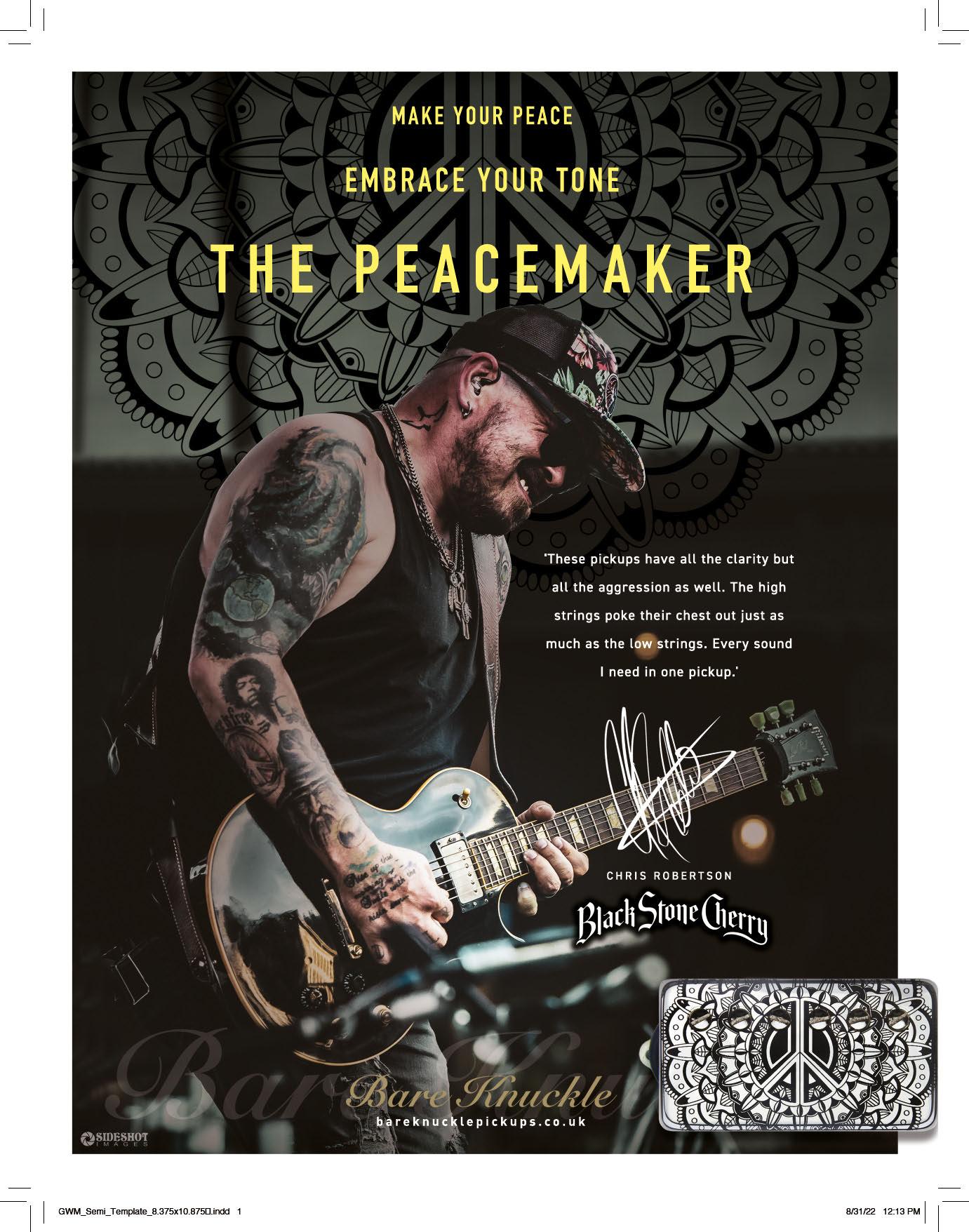
MEGADETH MAIN MAN DAVE MUSTAINE DISCUSSES HIS SIGNATURE GIBSON LES PAUL, HIS INFLUENCE ON METALLICA, THE LEGACY OF COUNTDOWN TO EXTINCTION — AND WHO GETS HIS VOTE FOR MEGADETH’S BEST-EVER GUITARIST
BY ANDREW DALY PHOTOGRAPH BY JEREMY SAFFERBEATEN ALCOHOLISM, come back from a career-threatening arm injury and bested throat cancer, it’s not a stretch to call Dave Mustaine bulletproof. Stronger than ever as he snatches another victory from the jaws of defeat, Mustaine is now triumphantly celebrating 40 headbanging years of Megadeth.
“There have been times where shit got hard,” Mustaine says. “There have been times when I needed to stop and figure out how to move forward. But there was never a time when I thought this would be over for good. I’m built differently; I’m not designed to give up. Things have stood in my way, but my attitude and faith have kept me going when most people wouldn’t.”
Mustaine’s habit of twisting trouble into triumph dates to being jettisoned by Metallica while on the precipice of success. Not to be deterred, the red-haired battle ax sunk his teeth into the opposition, coming out the other side a thrash metal icon.
“When the shit hit the fan, I dug in,” Mustaine says. “I didn’t pussy out. I instilled a mindset into this band that we would not be deterred or fucked with. We’ve always picked ourselves up off the deck, and that has been gratifying because it shows that my vision was right. I’ve been able to have success and maintain my integrity. Not many people can say that.”

“I don’t claim to be somebody that knows Mixolydian or Phrygian scales,” Dave Mustaine says. “I’m surprised I even remembered those two words just now, because I’m selftaught”
Some 40 years after the formation of Megadeth, Mustaine remains a spitfire, albeit wiser. Now surrounded by a cast of characters with whom he shares a genuine brotherhood, life seems more manageable for Megadeth’s alpha leader. While his penchant for ill-tempered moods and face-melting heroics remains, the menacing madman has found a soft spot for those he’s closest to.
“If I’m being completely honest, [guitarist] Kiko [Loureiro], [drummer] Dirk [Verbeuren] and [bassist] James [LoMenzo] are the most pleasant people I’ve ever been in a band with,” Mustaine says. “They work hard, aren’t money-driven and live to play. There have been a lot of people in this band, and I’ve dealt with a lot of assholes. Not everyone can handle this level of exposure. Not everyone shares my vision. But I’m not bullshitting you when I say that Megadeth, as it sits right now, is the best it’s ever been in 40 years.”
Mustaine’s relentless nature remains luminous, as does his desire to plunge into new ventures, culminating in the yet-to-bereleased Dave Mustaine Signature Gibson Les Paul, AKA “a Les Paul for thrash guys.” And while the gorgeous 24-fret single-cut remains a mystery to the world and is still in what Mustaine calls the “final tweaking
nificant design change. The headstock is the classic Les Paul headstock. But it does not have the Gibson Custom Shop inlay; I’ve got my little insignia. The part I’m still working on is the poker chip. I can’t decide if I want cream or black. I’m leaning toward black, but I’m still mulling it over.
Did the success of your signature Gibson Flying V spur on the Les Paul?
I’m known for using V’s, but I’ve been planning this with Gibson for around 18 months. I’ve always wanted to design a Les Paul for thrash players but never got around to it. And Gibson was pleasantly surprised with the orders for my V, so we made it happen. I went to the Gibson factory a couple of weeks ago, and when I got there, every room had my V’s stacked up and being built. The success of the V has been incredible; I’ve never seen anything like it when I’ve visited the ESP or Dean factories.
What was it about V-shaped guitars that initially drew you in?
My first electric guitar was an $80 Gibson SG copy; after that, I got a Les Paul copy. Not long after I started playing in Panic, I started using an Ibanez Destroyer, a copy of a Gibson Explorer. And when I
whole thing ended because Bruce [Dickinson, Iron Maiden vocalist] got sick. In the blink of an eye, an entire year’s worth of work was canceled, which was financially devastating for [Megadeth’s] Shawn [Drover] and Chris [Broderick]. So, the management we had took it upon themselves to call Shawn and Chris and say, “The tour is now canceled; you should probably go find another job.”
But I didn’t know about this; all I knew was that my drummer and guitarist had quit. I understood the circumstances, and I might have done the same thing, but I would have fucking told me before I went and quit. Having me find out afterward tells you all you need to know about Shawn and Chris’ characters. But it’s okay; they’ve got Megadeth on their resume. We had some good times together there for a bit.
How important have Kiko, Dirk and James been to flipping the script? This is the best group of people I’ve ever worked with. When I first heard Kiko play, I was enthralled. Megadeth has had guys like Jeff [Young] and Marty, but Kiko is the best we’ve ever had. I don’t say that because Kiko is in the band now; I say it because it’s the truth. Kiko is the best guitar player out of all of them. When Kiko
stage,” the red-haired firecracker gave me a sneak peek of his namesake rig in all its impending glory.
As he prepares to celebrate a victory 40 years in the making, Mustaine checked in with Guitar World to discuss his new Les Paul, his influence over Metallica, the legacy of 1992’s Countdown to Extinction, and why Kiko is a better fit for Megadeth than Marty Friedman.
What can you tell me about your stillunder-lock-and-key signature Gibson Les Paul?
It’s got my Seymour Duncan pickups and Grover tuners. It’s got my handpicked burst finish. We’ve shaved the back of a neck down where it meets the body for easier access for soloing. [With] Most Les Pauls, access stops around the 21st fret, but with mine, you can get all the way to the 24th. That extra access lets you nestle your hand in the cutaway on the back, which is a sig-
joined Metallica, I came upon the V, but I didn’t think much of it because of the weird shape. I didn’t think it was very playable, but I soon realized its versatility because I could do a lot with it once I got comfortable.
Once I learned I could rest the guitar between my legs, that was a game changer in the studio. With that, I could take my hands off the guitar and have them float instead of holding the neck upright to keep a grip. And I eventually got comfortable with it live, too. After that, I became fascinated with its beautiful shape; it’s iconic. So much so that it’s become a signature of what I do in Megadeth.
Megadeth’s current lineup seems to have granted you some much-needed serenity.
To understand how important that is to me, let’s remember how we got there. We had gotten a tour with Iron Maiden, but the
came in, the wounds from my personality conflicts with Shawn and Chris were fresh, and I had this paradigm of how things were, which I knew I needed to change.
But Kiko and I got along, and I eventually knew he was a good fit, personality-wise. So, I said to Kiko, “Look, you’re gonna join Megadeth, and your life is gonna change.” And we had Chris Adler helping us on drums, and I hoped he would stay, but he decided to stay with Lamb of God. So Chris recommended Dirk, and I fell in love as soon as he came in. I could tell that Dirk was the sweetest man, a phenomenal drummer and very humble. With that, I told Dirk the same thing I told Kiko when he joined: “Your life is gonna change, so be ready for it.”
We still had David Ellefson on bass, but as we know, shit hit the fan. I had to dismiss David from the band, and that left us in the position of needing a bassist. The last thing I wanted was some asshole who would get
“PEOPLE NEED TO KNOW THAT I FEEL THAT MARTY [FRIEDMAN] IS A GREAT GUITARIST. KIKO [LOUREIRO] IS BETTER FOR MEGADETH. THAT HAS NOTHING TO DO WITH SKILL AS MUCH AS IT HAS TO DO WITH THE WHOLE PIE”
a brain swell from being in Megadeth. I go back to Kiko, who went from being a guitar player in a band that plays in bars to being in a band that plays in arenas, theaters and stadiums, but he took it in stride. That’s when it dawned on me to invite James back into the band. James has played with Ozzy and has circulated in our industry at the highest levels. He has been great as a band elder, helping those guys when I’m not there. And if I’m being honest, he’s a significant upgrade as a bassist.

You mentioned that Kiko is the best guitarist Megadeth has ever had — better than Marty Friedman. Can you expand on that?
Marty is a superb guitar player, one of the best in the world. I’ve said a lot about Marty, but above all else, people need to know that I feel that Marty is a great guitarist. Kiko is better for Megadeth. That has nothing to do with skill as much as it has to
do with the whole pie. What is their outlook toward touring? What is their outlook toward recording? What is their outlook toward songwriting? We all know that Marty is a unique guy who goes to the beat of his own drum. That’s great, but it wasn’t great for Megadeth. I love the music we made together, but people change, and we change with it. Kiko and I share a mindset, and I needed that. I need someone who will contribute and has a shared mindset regarding touring, recording and growing musically.
How do you view your role as a guitarist within Megadeth?
I’ve always looked at myself as a utility player. Many people wonder how we divide the solos up, and it’s simple: if the rhythm is easy, then it’s better for me to solo over it, and I’ll have the other guy play rhythm. If the rhythm is difficult, then it’s better for me to play that and have the other guy do
the solo. I’m a very advanced rhythm guitarist who can play complicated rhythms and sing over the top of them. Most people can’t do that because their left and right brains don’t communicate. And my lead style is a very punk-rock and blues-on-steroids thing. I don’t claim to be somebody that knows Mixolydian or Phrygian scales; I stay in my pentatonic box. I’m surprised I even remembered those two words just now because I’m self-taught. [Laughs]
How have your arm injury and throat cancer altered your mindset?
It’s a fucked-up thing because I play guitar and sing, and both threatened me to my core. It’s been trying, but it’s helped me increase my faith. My mom was born in Germany, and after she came to the U.S., she became a Jehovah’s Witness. She impressed that upon me from a young age, but when I was about 15, I renounced my faith. I let go of everything I’d been taught
and went in a different direction. I was living on my own, and I figured, “I don’t need this stuff. I can make my own choices.” Things stayed like that for a long time, but as life worsened, I needed to consider altering my thinking and look for something to believe in.
How did you apply that to your recovery?
It goes back to when I was deep into alcoholism and going down a path that would kill me. Look, I’m a tough guy tougher than most but anyone who drinks at that level for long enough isn’t going to live to tell the tale. I was constantly drinking, and I was becoming unrecognizable. So I got sober and went to AA. And in 12-step programs, they talk about a “higher power”; they won’t mention God because people’s ass cheeks clench and they come mentally unglued when you say “God.” They tiptoed around Jesus, but I still found a power that seemed greater than myself, and considering nothing else had worked, I had to try. I didn’t know if it was gonna work,
but I began reading and spending time in prayer meditation, and sure enough, my life started to get better. And then I had the arm injury.
So, now I’m sober, but my arm is fucking ruined, and I’m being told I won’t play guitar again. What the fuck do I do? I dug deeper into my faith. Okay, I got through that, but then the neck issues came. I had arthritis, degenerative disc disease and stenosis from a life of headbanging. I again dug in deeper and kept my faith. They went through the front of my neck and had to rip apart the muscles in my collarbone to get into my vertebrae to fuse my neck together. They lifted the hood and fixed it; I’m thankful for that. I’ve got lingering side effects where my head falls forward sometimes, but I lived, and I feel like I’m a better person for it. My faith was the thing that made it possible, and that’s a big change for me.
How did those experiences affect you musically?
I’m not the same guy I was. When I decided
to change my life, many people said, “Dave is gonna become a pussy.” When I got married, those same people said, “Okay, now Dave is gonna become a pussy.” I chuckle when people say shit like that because they don’t know who the fuck I am. I know who I am, but that doesn’t mean I don’t change. I’m a constantly evolving organism, and that’s allowed me to heal.
So, to be able to sit back down and say, “What could possibly be worse?” I nearly died in ‘92. I had my arm blown out. My neck has been ripped to fucking shreds. I got cancer. What else can happen? All of that has made me who I am, and that is reflected in my music. I proudly wear the scars of those injuries in my guitar playing and vocals. I’ve played some dangerous games, and when you do that, you’re gonna get some serious injuries. I’m surprised I haven’t had anything worse happen, but I’m still here, and in case you’re wondering, I’m not a pussy. [Laughs]
Megadeth’s Countdown to Extinction

turned 30 years old in 2022. How do you measure its importance?
It was our biggest record. That’s pretty much the way I measure it. A lot of it was because of the timing; it came out in ‘92, and ‘92 was when everything was imploding because of alternative music. You had Pearl Jam, Nirvana, Soundgarden, Mother Love Bone and Blind Melon fucking things up, and radio gravitated toward that. They thought the yuppies would listen to alternative music while drinking their Stella Artois. [Laughs] The types who don’t drink Miller High Life and definitely don’t listen to metal. And the advertisers who handled brands like Lexus, BMW and shit like that would advertise on alternative stations, which fucked metal.
So, as these metal stations went the way of the great white buffalo, we had to decide, “Are we going to be alternative? Are we going to change like every other band?” Metallica cut their hair off, put makeup on and all that stuff, and I got little haircuts during that time, but I never chopped it off. We decided we wouldn’t change to
fuck did you say? [Laughs] I think I wrote many of the songs that made you famous, so you probably should recheck that bullshit statement. But this is the shit those guys say, and you’ve got the sheep who follow them around believing it.
In your eyes, who’s at fault for perpetuating the issues?
The issue is that people don’t know their history and take sides. I never wanted to take sides; I wanted things to be reconciled and to be friends, but for whatever reason, they didn’t. And Metallica is represented by the same agent as Megadeth, and I’ve asked our agent, “You’re Metallica’s agent, too; why won’t those guys play with us? What are they afraid of?” And they’ve confirmed they’re going out with Five Finger Death Punch and the Pantera thing, so it’s clearly about the money. The fact is simple: the world wants to see Megadeth and Metallica play together. And in case anyone is wondering: there’s fucking money in that. The fans want to see Metallica and Megadeth share the stage. Does Megadeth need Metal-
I the guy who can’t play guitar went up to the mic and started talking. That’s how it was until I left; James only started talking to the audience after I left; he had no choice. You can hear it on the tapes from the shows we did in San Francisco at the Waldorf and the Stone; I did all the talking. And most of what I said on stage was things James would then copy after I left. So how do I view my influence on Metallica? It’s pretty fucking deep.
Why do you feel they relegate you as a guitarist?
Ego, probably. If we look at the things I played, I guess Kirk Hammett did a noble job of trying; he took a swing. But I ask my guitar players for a bit more than taking a swing. When they’re doing a previous guitar player’s solo, I ask them to do it right and pay tribute; that’s how you honor it. When you go into an established song and don’t do the solo right, that’s a problem. If you can’t do it, that’s one thing, but if you can and you choose not to, that’s another thing. It’s not about you or your ego; it’s about the song. If
fit the trend and would tough it out. Sure, we made some minor changes at the behest of the record label, but that was as far as it went. The fact that Countdown succeeded despite the shifts in popular music showed that the music was more potent than any trend. We didn’t sell out like other bands. We didn’t change who we were. I think that’s the greatest measure of Countdown’s importance.
How do you view the perceived competition between Megadeth and Metallica?
In my mind, there is no competition between Megadeth and Metallica. We’re different bands, and I believe Megadeth has been more consistent. But the sad thing is that the drama between us has been more popular than the music ever was. And remember, Metallica got a big head start, and they did so on the back of what I helped create. They became one of the biggest bands in the world, and here’s one of the biggest bands wasting their breath trying to discredit me by saying, “Dave’s not a good guitar player.” Excuse me, what the
lica? No. But Metallica talks about their fans, but they don’t give them what they’ve been asking for. What are they afraid of? I don’t know. It’s not me; it’s them.
This begs the question: How do you measure your influence over Metallica?
In the early days, I was the only guitar player in the band and wrote some of the songs that ended up on their earlier records. So, for a guy who “couldn’t play guitar,” I sure did fucking influence things. The only reason James even played guitar early on was that we couldn’t find anyone else. So who was it that couldn’t play guitar? We had one guy named Brad Parker, whose real name was Damian Phillips. He showed up and had an oversized feather earring; we did one show, and that was the end of him. And that was why we ended up having James play guitar. There was no other reason.
Also, early on, James was terrified to talk to the crowd, and I would look at him and say, “Talk, man. Get up there and fucking talk,” but James didn’t do it; he stayed in the background, and he’s the fucking singer. So,
you can’t do it as well or better than the original, then don’t do it at all.
After 40 years, to what does Megadeth owe its longevity?
A lot of it is the take-no-shit attitude. People know Metallica has always tried to hold me back. They never expected me to do what I did after they fucked me over, but I succeeded and made better records along the way. But I don’t care because I’m happy with my success, and I’ve had plenty of it. The music we make now tells you all that you need to know. But I hope we can tour together before it’s all said and done, but I don’t know if we will.
As far as looking back at everything from the beginning, I think I’ve maintained my integrity. When I injured my arm, I sold off all my gear to pay the people I owed money to. When most bands end, they say, “Fuck it,” and leave their vendors holding the bag. Not me. I’m way different. I’m old fashioned. I’m old school. I do what I say I’m going to do. That’s why Megadeth is still here.
"IN MY MIND, THERE IS NO COMPETITION BETWEEN MEGADETH AND METALLICA. WE’RE DIFFERENT BANDS, AND I BELIEVE MEGADETH HAS BEEN MORE CONSISTENT. BUT THE SAD THING IS THAT THE DRAMA BETWEEN US HAS BEEN MORE POPULAR THAN THE MUSIC EVER WAS"
1944–2023
BY ALAN DI PERNAONE OF THE FONDEST MEMORIES OF MY 43 YEARS IN music journalism is an evening I spent with Jeff Beck at the bar of the Drake Hotel in New York City back in 1999. We’d been scheduled to do a big Q&A interview for this magazine the next day. But as we were both staying at the same hotel (something I always tried to do when on assignment), I was invited to join Beck, along with his publicist and a member of his management team, for a drink. I ordered a glass of wine but was promptly admonished, “C’mon, have a real drink!”
S
U

Switching my order to a cognac seemed to satisfy all concerned. Beck chatted, charmingly, for a few hours about nothing in particular — his cars, vegetarian diet tips, the sheep on his country estate, getting his pocket picked on the streets of London. I’d interviewed him before, but I was delighted to discover that even his casual conversation, much like his guitar playing, was exuberant, energetic, wildly original, idiosyncratic and highly inventive. Like his friend Keith Moon, Beck could be hilarious. His anecdotes were much like his game-changing guitar solos — spontaneous yet artfully structured and filled with surprising twists and turns.
About an hour into the evening, the barman, who had a heavy Eastern European accent, finally figured out whom he’d been serving. “Jeff Beck!!! Oh man!!! I love your record ‘Rice Pudding!!!’ brrrrrrrrr...” He then launched into an air guitar solo.
Supremely gracious, Beck acknowledged the compliment. The barman eventually calmed down and returned to his duties. I shot the breeze with Beck and his entourage a while longer. Later that night, as we got into the elevator to go up to our rooms, in that awkward silence that always seems to descend when people enter an elevator, Beck, propped against the elevator’s side wall, suddenly launched into a pitch-perfect impersonation of our friend behind the bar: “Jeff Beck!!! Oh man!!! I love your record ‘Rice Pudding!!!’ brrrrrrrrr...” With a few drinks down our necks, we all laughed so hard we nearly pissed over the posh hotel elevator’s floor.
Vocal impressions were another of Beck’s unsung talents — evidence of his finely tuned ear for any and all sonic phenomena. The manic voice heard over the apocalyptic guitar solo in the Yardbirds’ landmark 1966 track “Happenings Ten Years Time Ago” is Beck imitating a doctor at a venereal disease clinic that treated many of Swinging London’s pop stars. As if Beck’s astonishing, cathartic solo on that track — a harbinger of Hendrix and Van Halen’s feedback, divebomb mayhem — weren’t enough, he threw in a bit of schtick as well. Not to mention an in-joke for all his peers who’d passed through the portals of that particular clinic.
My interview with Beck the next day went like a dream — several hours of candid, cordial, in-depth conversation. The night before had certainly broken the ice. For me, personally, the evening was one of those “If my friends could see me now” moments. Or, even closer to home, “If my 13-year-old self could see me now.”
Like many fledgling rock guitarists in my age group, my life had been transformed by
the 1965 release of the Yardbirds’ U.S. debut album, Having a Rave Up So the news of his passing, on January 10, at age 78, hit especially hard. For many of us, he will always be Guitar Hero Number One — the greatest rock guitarist of all time, a consummate musician who continued to innovate and reinvent himself throughout the latter half of the 20th century and well into the 21st. In a 1998 song, Queen guitarist Brian May dubbed Beck “The Guv’nor.”
“Jeff is the standard by which many of us measure ourselves as guitarists,” May told me at the time.
Replacing Eric Clapton in the Yardbirds, Beck’s October 1965 through November 1966 tenure with that group shaped the style and direction of rock music for decades to come. His playing on classic Yardbirds recordings like “Heart Full of Soul,” “I’m a Man,” “Shapes of Things,” “Evil Hearted You,” “Mister You’re a Better Man Than I” and “Over Under Sideways Down” raised the bar appreciably for rock guitarists. Suddenly, it was no longer enough to be able to play “House of the Rising Sun” or “Day Tripper.” Beck’s mid-Sixties emergence initiated the phenomenon of the rock guitar hero. At a time before Hendrix, Clapton or Page had broken through in a big way, the Yardbirds became the first rock band where the guitar playing mattered more than the singing.
The front cover of Rave Up was every bit as influential and iconic as the back cover of the John Mayall with Eric Clapton “Beano” album. Just as guitarists glommed onto the Gibson Les Paul and Marshall combo amp that Clapton is pictured playing on the latter album sleeve, many of us became fascinated with the well-worn 1954 Fender Esquire that Beck is seen with on the Rave Up cover. It seemed almost magical — as if there was nothing Beck couldn’t do with that battered-yet-beautiful instrument and a pair of Vox AC30 amps. It would indeed be difficult to underestimate the impact of Beck and this guitar on the development of the extended rock guitar solo in all its fuzzedout, feedback-riddled glory.
The advent of psychedelic guitar rock can also be traced back to Beck and the Yardbirds’ summer of ’65 single “Heart Full of Soul,” with its raga-inflected lead guitar riff. The group’s producer/manager Giorgio Gomelsky had hired an Indian sitar player to perform the lick, but he couldn’t nail 4/4 time (Indian music being very different from its Western counterpart in its rhythmic organization). So Beck just played the part on his Esquire, and another milestone in the evolution of rock guitar had been reached. In the poetry of steel string pitch bends, Beck found the secret soulful sweet
spot where the Mississippi River meets the Ganges.
In the spirit of the times, Gomelsky had been trying to expand and internationalize the tonal palette of pop music with sitars, harpsichords and the like. Beck, in essence, had responded by saying, “Hey, I can do all that with my guitar.” Which indeed he would do in the years to come. His wildly eclectic musical vocabulary and openness to sounds from far outside the usual rock and blues contexts set him apart from most other rock guitarists.
One thing that enabled Beck to emulate a sitar on “Heart Full of Soul” was his unique finger-picking style. He could create a resonant drone on the open D string of his guitar, while playing the riff on the higher strings. He was one of the few hard-hitting rock guitarists who didn’t use a plectrum for much of his career. In later years, when he’d moved on to Fender Stratocasters, his fingerstyle technique had evolved to include the instrument’s vibrato arm and volume knob in complex displays of dexterity and sheer finger strength. This enabled him to create quavering, swelling and dying, microtonal timbres that rivaled the human voice in expressiveness and sheer emotional wallop. I once told him that I’d hurt my hand trying to emulate something I’d seen him do on TV.
“You’re not going to sue me, are you?,” he quipped.
Born in London on June 24, 1944, Geoffrey Arnold Beck was more profoundly influenced by rockabilly and country guitar playing than many of his more blues-based peers. His technique was very much based around fingerpickers like Chet Atkins and Cliff Gallup from Gene Vincent’s band.
“I remember having an insulting criticism from Eric Clapton saying, ‘You gotta get rid of that folk style of country picking’” Beck once told me. “I know it used to annoy him.”
Indeed it must have. Beck replaced Clapton in the Yardbirds because, unlike Clapton at the time, he didn’t want to confine himself just to 12-bar blues. Beck’s voracious musical eclecticism is what helped the Yardbirds achieve substantial commercial success in those adventurous mid-Sixties years, while Clapton toured around England’s small blues clubs, sleeping in John Mayall’s funky van. Beck wasn’t even precious about his beloved rockabilly. The Yardbirds’ 1966 hit “Over Under Sideways Down” is built around a bass riff taken from Bill Haley’s “Rock Around the Clock.” Pure rockabilly. Yet, over the top of that, Beck chose to lay another exotic Eastern European riff, like something out of a folk dance from Uzbekistan. He was like a collage art-
ist, forging a bold new work from disparate, recontextualized parts — a Levi-Straussian bricoleur
Not that Beck cared for that kind of talk. I once told him that some of his playing on the 2003 album Jeff was like a Jackson Pollock Abstract Expressionist action painting. “Oh dear,” he replied.
As the Yardbirds’ career began to wind down — owing largely to heinously unfortunate choices of recording material foisted on them by producer Mickie Most — Beck struck out on his own in March 1967 with another towering rock guitar monument, “Beck’s Bolero.” For the session, he assembled one of rock’s first super groups, with Jimmy Page as his co-guitarist, Keith Moon on drums, John Paul Jones on bass and Nicky Hopkins on piano. So much rock history is condensed in that one fleeting moment, including a key bit of Led Zeppelin pre-history. There was also brief talk of Keith Moon and John Entwistle quitting the Who to become Beck’s rhythm section.
In this period, Beck was also under consideration as a replacement for Syd Barrett in Pink Floyd and Brian Jones in the Rolling Stones. None of which happened, of course.
Beck’s career was in flux at the tail end of the Sixties. Mickie Most tried to groom him as a singer/guitarist with the singles “Tallyman” and “Hi Ho Silver Lining.” Though Most could be a brilliant producer at times, this wasn’t one of his better ideas. Jeff Beck’s voice resided in his guitar, not his larynx. While this made him somewhat less marketable than singing guitarists like Hendrix or Clapton, it also tended to make him the ultimate guitarist’s guitarist, highly valued for the originality and mastery of his unique approach to the instrument. Like the protagonist of the Who’s mod era anthem “Anyway, Anyhow, Anywhere,” Jeff Beck never “followed the lines that had been laid before.”
The “singer problem” was temporarily solved when Beck teamed up with Rod Stewart to form the first Jeff Beck Group
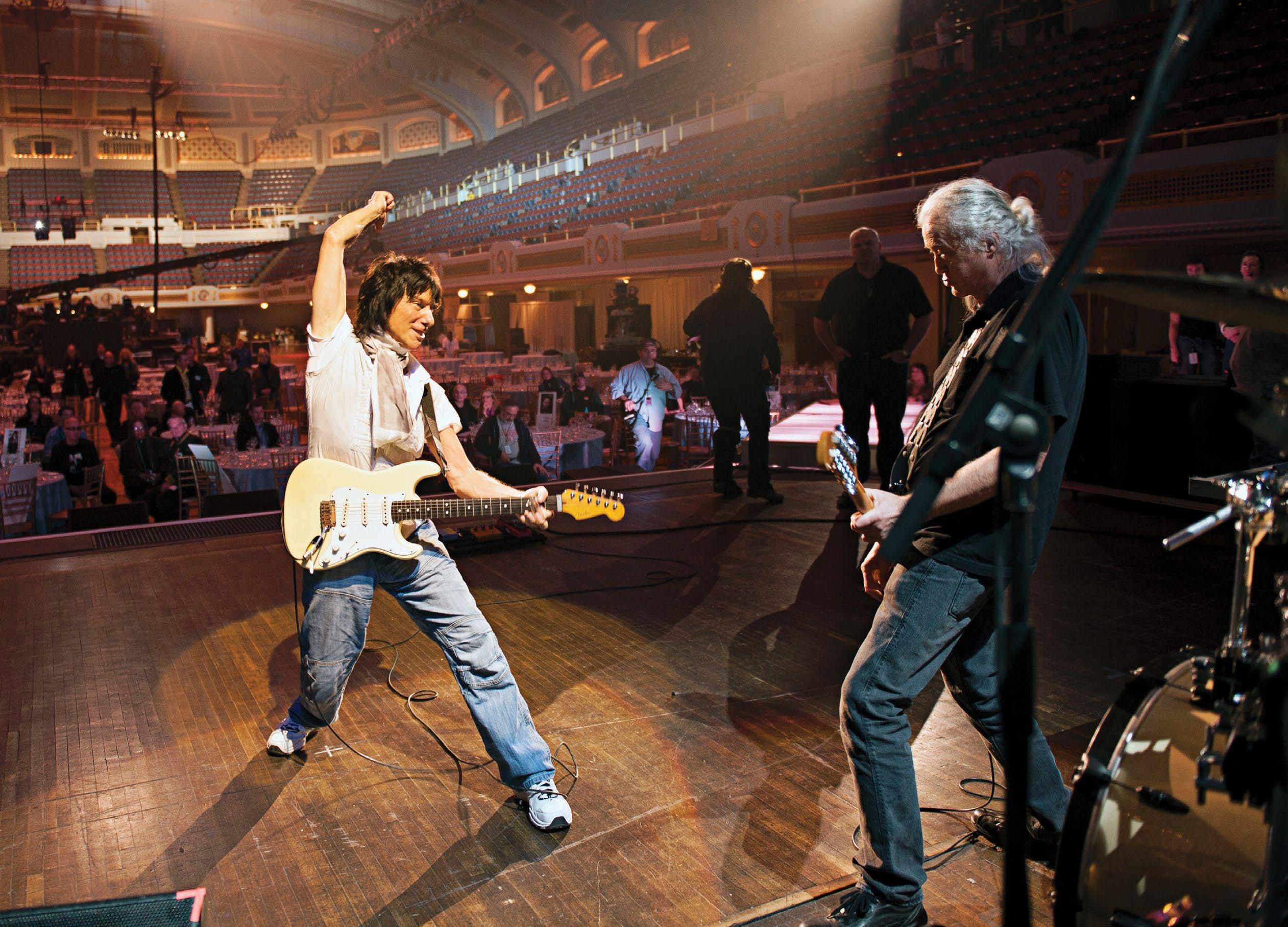
IN THIS PERIOD, BECK WAS ALSO UNDER CONSIDERATION AS A REPLACEMENT FOR SYD BARRETT IN PINK FLOYD AND BRIAN JONES IN THE ROLLING STONES. NONE OF WHICH HAPPENED, OF COURSE
in 1967. With Ronnie Wood on bass, Nicky Hopkins on piano and Mick Waller on drums, the lineup released two albums — Truth (1968) and Beck-Ola (1969) — that did much to establish, codify and popularize the guitar-centric heavy rock sound that would dominate much of the Seventies and beyond. Truth is where Beck switched to then-new de rigueur rig of the late Sixties — a Gibson Les Paul guitar through a Marshall stack. His hard-hitting interpretation of Willie Dixon’s blues standard “You Shook Me” predated Led Zeppelin’s version of the same song on their January 1969 debut album, which clearly shows signs of having been influenced by Beck’s recording. Beck’s slashing, start-and-stop rendition of another Dixon classic, “I Ain’t Superstitious” opened up a new vein of possibilities in the interpretation of the 12-bar blues idiom. And his slowed-down, slide guitardriven version the Yardbirds’ “Shapes of Things” is an object lesson in how mid-Sixties psychedelic pop could be transmuted to forge the Seventies heavy rock aesthetic.
Beck was an inspired interpreter of other people’s songs. He could tackle Charles Mingus, Lennon/McCartney or Stevie Wonder with equal aplomb and originality. But he wasn’t much of a songwriter himself.

All of his fierce and enormous creativity was invested in the guitar.
“I can’t just go to ‘Mr. Bloggs the songwriter’ and do a massive attempt at a big hit,” Beck told me in ’03. “It just wouldn’t work for me. ’Cause I’d lose all the followers who like what I do already.”
In a way, not being a songwriter was a liberation rather than a limitation for a player of Beck’s caliber. It meant he wasn’t tied to any particular songwriting style or idiom. He was free to move anywhere his restless spirit led him. The pieces he did write were more in the nature of jazz compositions — a melodic theme with improvisational variations. With Les Paul as another of his key early influences, Beck was no stranger to the jazz guitar idiom.
All this would come together for him beautifully in the mid Seventies. The breakthrough success achieved by Birds of Fire, the 1973 rock/jazz fusion album by John McLaughlin and the Mahavishnu Orchestra, fostered an eager new market and audience for instrumental guitar music. This was like a gift from on high for Beck. “When I first heard the Mahavishnu Orchestra, who were hugely popular, in Central Park, I began to develop wings because of that,” Beck told me in 1999.
He leapt into the fray with his 1975 masterpiece, Blow by Blow. Produced by George Martin, it consisted of nine instrumental tracks powered by Beck’s blazing guitar work. Unfettered by the need to fit his guitar into a pop or rock vocal format, he truly does take flight. The brisk tempos and tricky time signatures of the fusion idiom brought a new level of rhythmic intensity to Beck’s playing. The album also showcased Beck’s tremendously plaintive, sensitive way with a ballad, Stevie Wonder’s “Cause We’ve Ended As Lovers,” which Beck dedicated to another of his guitar heroes, Roy Buchanan. Blow by Blow went platinum and yielded iconic Beck tracks like “Freeway Jam” and his rendition of the Beatles’ “She’s a Woman.”
“A lot of people liked Blow by Blow because it simplified McLaughlin and it complicated rock ’n’ roll,” Beck said. Which brings up a key point. Whatever genre or style Beck drew from — be it jazz or Bulgarian folk music — he always managed to transform it into pure, raunchy rock ’n’ roll. While he brought a new level of musicianship to rock, his work never smacks of pretentiousness or music lessons. It came from someplace more raw and elemental than that.
Blow by Blow was followed by the equally
brilliant Wired in 1976. Beck aligned himself even more closely with the fusion crew on this record, drafting in Mahavishnu keyboardist Jan Hammer and drummer Narada Michael Walden. In this period, the Mini Moog and other synthesizers had begun to encroach on the guitar as a solo instrument in rock. Rather than resist or react against this trend, Beck embraced it readily. Listening to Beck and Hammer weaving and dancing around one another on Wired is like watching Nureyev and Fonteyn, or some other legendary ballet duo, in action. If the mid Sixties were Jeff Beck’s first Golden Era, the mid Seventies were indisputably his second.
The punk era backlash against fusion brought an end to this phase of Beck’s career. “You can’t say ‘fusion’ now,” he joked with me in ’99. “You’ll get arrested for that.” He felt somewhat at odds in the Eighties. I remember him complaining to me that “the clothes were more important than the music.” But the decade was also a time for Beck to celebrate and reconnect with his already formidable legacy. Highprofile charity gigs like The Secret Policeman’s Other Ball and the ARMS Concert for Multiple Sclerosis reunited him with his good friends and Sixties-era comrades Eric Clapton and Jimmy Page. His 1985 album, Flash, featured a spine-chilling duet with Rod Stewart on the Curtis Mayfield spiritual “People Get Ready,” which became an enormous hit at the time. Beck also celebrated his key guitar influences with the 1993 Cliff Gallup/Gene Vincent tribute album Crazy Legs and early 2011’s Rock ’n’ Roll Party (Honoring Les Paul).
High-profile collaborations with other legendary artists had long been intermingled with Beck’s output as a solo artist. You can think of it as a latter-day incarnation of a jazz musicians’ career trajectory, split between gigs as sideman vs. gigs as leader. In the Seventies, he worked with everyone from Memphis soul legend Steve Cropper to Motown’s “Funk Brothers” rhythm section to Vanilla Fudge bassist Tim Bogert and drummer Carmine Appice in the short-lived trio, Beck, Bogert and Appice. The Eighties through early 2000s brought projects with Mick Jagger, Buddy Guy, Roger Waters, Brian Wilson, Kate Bush, Jon Bon Jovi, Paul Rodgers, ZZ Top, reggae legend Toots Hibbert and, just prior to Beck’s passing, actor/ musician Johnny Depp.
If Beck’s own output as a solo artist slowed down a bit during the Eighties, it can be attributed to several factors. He’d struggled with health issues and injuries all his life; and as time went on, hearing loss and tinnitus became an increasing problem.
He agonized quite a bit over his career ups and downs as well. He was known to have bouts of bad-tempered irascibility, which helps explain why he never spent too much time with any one group of musicians. He was intensely self-critical, harder on himself than anyone else. Even classic Jeff Beck tracks like “Freeway Jam” didn’t escape his harsh self-judgment.
“I hate that tune,” he once complained. “It’s pretty awful. I couldn’t care less if people still like it. It felt like a slowed-down Irish reel to me.”
I once discussed this with Brian May, saying, basically, “How can anyone put down Jeff Beck like that — even if it’s Beck himself? Doesn’t he realize how incredible he is?”
May just smiled and said, “Oh, he knows. Believe me, he knows.”
But knowing that he was indeed the Guv’nor, and having to live up to that, surely brought its own burden of anxiety. As Shakespeare said, “Uneasy lies the head that wears the crown.”
At the dawn of the 21st century, Beck found a new set of inspirational wings in an unlikely place — the burgeoning world of electronic club music, particularly the electronic subgenre known as jungle or drum ’n’ bass. Some in the rock world saw electronica as either an abomination or a threat to rock’s hegemony — or both. But Beck, from his broader musical perspective, saw something akin to what had inspired him about fusion — frenetic tempos, dizzily skewed beats and a particularly adventurous new mode of sculpting the abrasive, raw essence of sound itself.
This new mode of Beck mayhem was first heard on his 1999 album, Who Else!. It would continue to be an energizing factor in his music on his subsequent albums, You Had It Coming (2000) and Jeff (2003), as
well. World music — from the Asian Underground electronic scene to traditional Bulgarian choral music — also made its presence felt in this phase of Beck’s career. For some, myself included, these discs represent a third Jeff Beck Golden Age. For an established artist in his 50s moving into such an unprecedented, and youthful, new territory is testimony to the boundlessness of Beck’s musical vision, particularly where the electric guitar was concerned. With these records, he pioneered a new breed of postmodern guitar heroics — or perhaps antiheroics would be a better term.
“I didn’t want the guitar’s role to be thrust in people’s faces, with just a little bit of backing,” he said in ’03. “I wanted it to be integrated. I wanted it to weave in an out and let other sounds be heard. Otherwise, it would be less rich. I mean, when it’s time to shred, then shred. But otherwise, let the rhythm do something.”
In this period, Beck was also noted for working with female musicians such as guitarist Jennifer Batten, bassists Tal Wilkenfeld and Rhonda Smith and vocalists Joss Stone and Imelda May. “It’s nice to know that there are really good quality young people coming up,” he told me ’03. “It’s a real plus to me that the labels have started signing young female guitar players. Not that girl guitar players are anything new. But it’s refreshing that the labels are acknowledging their talent.”
Well-deserved honors and accolades were heaped on Beck, celebrating his enormous contribution to the music of our time. In 2011, he received honorary degrees from both the University of the Arts London and the University of Sussex. He amassed eight Grammy awards and was inducted twice into the Rock and Roll Hall of Fame — as a Yardbird in 1992 and as a solo artist in 2009.
“Largely, I disapprove of overblown ceremony,” he said on the latter occasion. “But it’s hard to say no to something like that. After 40 odd years, it’s nice to be recognized. It’s nice to know that someone’s there ringing the bell for me.”
And now the bell tolls for Jeff Beck’s passing. His enormous spirit is an undying part of rock music’s very essence. He will always inspire guitarists not only to strive for technical mastery of their instrument, but also to keep on pushing the envelope stylistically, to keep on breaking and changing the rules in the quest for new sonic vistas.
“The electric guitar has proven to be as revolutionary as the wheel,” Beck told me in ’03. “You can’t make it rounder than round and it can’t be better. The guitar is just a facility which is infinite. There are no lengths to which you can’t go.”
“HOW CAN ANYONE PUT DOWN JEFF BECK LIKE THAT — EVEN IF IT’S BECK HIMSELF? DOESN’T HE REALIZE HOW INCREDIBLE HE IS?” BRIAN MAY SMILED AND SAID, “OH, HE KNOWS. BELIEVE ME, HE KNOWS”
GW ASKED A WIDE RANGE OF GUITARISTS to pay tribute to Jeff Beck, either by choosing their favorite Beck song or guitar moment — or, in some cases, sharing something a bit more personal and emotional. All of their responses, which are collected below, perfectly illustrate why Beck was indeed the guitar hero’s guitar hero.
I RECORDED “I Ain’t Superstitious” by Willie Dixon, as remade by Jeff Beck, and that was on one of our very earliest albums. I’ve been a fan for a really long time, and I recently got to see him (and all of the stars’ respect for him) at the Classic Rock Awards ceremony in Tokyo [Tokyo Super Jam] — and he was amazing. I also saw him once at the Hammersmith Odeon in England, and that was a show to behold! I will miss him and surely follow the sounds of his magic guitar in heaven.
HE WAS SUCH a big influence on me. His playing brought me to tears many times. His heart and soul were connected to his fingers, and what came out was full of love and beauty. My song “Rain” was obviously inspired by him; big time. I saw him perform live three times; once with Clapton and Page, once with Stevie Ray Vaughan and once solo. Thank you, Jeff, for making my life a lot better.
 Jeff Beck photographed in London, May 13, 2009
Jeff Beck photographed in London, May 13, 2009
“EL BECKO” HAS WILD jazz modulations during the intro, and Jeff’s melody ties the chords together perfectly. His slide playing in the verse is so tight that I never even knew it was a slide. And he knows when to throw off the chains of the chord structure and rock with minor blues licks in the middle solo. I also love “I’m Not Talking” by the Yardbirds. Jeff uses a blistering fuzzy guitar tone to drive this unusually arranged rock ’n’ roll song.
GIVEN HIS PROLIFIC wealth of recorded content, for me, it’s his ballads that are like going to church. All the lessons you need in music are in those tracks. Jeff told me that Charles Mingus, who wrote “Goodbye Pork Pie Hat,” sent him a nice note written on a notation sheet praising Jeff’s version of the tune. There are slices of life amongst all the struggles that stick out to me, where I’d often think, “Appreciate this moment with him; it’s not going to get better than this.” I played an outdoor summer show with him on the beach in Sardinia that was so magical that I could hardly be contained. And then our first tour was all over Italy because he wanted to get some miles on the new band before taking it to the U.S. and Japan. I played with him for three years, but that one is a highlight. The setting was magical, and I couldn’t have been prouder to be on stage with him that night.
absolutely beautiful from start to finish, as is a lot of Jeff’s work. I remember seeing him once on a double bill with John McLaughlin and Mahavishnu Orchestra, and he made time stand still. In more recent years, his innovation of playing melodies with the tremolo bar transcends the limits of the guitar.
Billy Gibbons
I MET JEFF Beck when I was 17 and I was glad to know a guy like that, a guy who was able to show me how this guitar-playing thing should be approached — and that’s still very much the case. Jeff’s was a wondrous soul, and we already miss him terribly but take comfort in the fact that he’ll be with us forever. Hi Ho Silver Lining!

Brad Gillis
AS A KID learning guitar, I remember hearing “Beck’s Bolero,” which blew me away. I started listening to Truth and was an instant fan for life. Then came Blow by Blow. It was a game changer for me, as Jeff had added a funky feel on guitar. I sat in my room and learned the whole record. The way he used his volume control, his note choice and feel put him in a category of his own. I’m happy to say his style influenced me greatly. You’ll be missed, Jeff, as you were one of the world’s best, if not the best…
“I AIN’T SUPERSTITIOUS” from Truth. The riff sounds like a biker gang about to run you over. I don’t know if anybody had ever sounded that “mean” before that was released.
I’VE ALWAYS LOVED Jeff’s solo on “Blaze of Glory” from Jon Bon Jovi’s Young Guns soundtrack. It still blows me away. Stellar all the way through, especially the last couple of slide notes. I remember being so happy for my buddy, Jon, to have a legend like Jeff play on his record.
Joe Satriani
WATCHING JEFF PLAY live was always thrilling. He never stopped striving to outdo himself and show us a new way to approach the instrument. People say it was all in his hands, but I think it was all in his heart.
Eric Johnson
WHEN I WAS very young, I heard the solo from “Happenings Ten Years Time Ago” by the Yardbirds and was blown away and have been ever since. “The Nazz Are Blue” is another great guitar performance. Truth is
DURING THE BRIDGE section of the Jeff Beck Group’s “Ice Cream Cakes,” he does this guitar pick-to-string scrape that comes out of nowhere and is percussive and melodic. Such a creative choice to do that over anything else. He’s the most inventive and creative guitarist I’ve ever heard. I can point out his endless licks and musical moments that have made me go back and repeatedly listen to try to figure it out — such an inspiration.
MORE THAN ANY specific song or moment, it was the experience of seeing Jeff Beck live for the first time; that is my favorite moment. I knew his playing from all of the incredible bands he was in and from his solo albums but seeing him live and watching his sweep-picking technique blew my mind. I’ve always loved that electric guitars are capable of making so many different types of sounds. Beck’s playing is such a great example of that — it’s so fluid and emotive and literally sounds like an extension of his soul, and that is particularly clear during the live performances of songs like “The Final Peace” and “Where Were You.” That has been a huge influence on me, and whenever people pick up on that in my playing and compare me to him, I beam.
“CAUSE WE’VE ENDED As Lovers” is emotional and technically perfect. His ability to make his guitar speak was magic. Every note on the track is special to me, using every guitar technique. His attack, pickup selection, super-smooth vibrato, pings and over-bends — they’re incredible. No one can compare to what he accomplished in his career as a guitar genius. Rest in peace, Jeff Beck.
ONE OF MY favorites is “Somewhere Over
I’D OFTEN THINK, ‘APPRECIATE THIS MOMENT WITH HIM; IT’S NOT GOING TO GET BETTER THAN THIS’” —JENNIFER BATTENMICK HUTSON/REDFERNS (BATTEN) DAVE M. BENETT/GETTY IMAGES (MAY)
the Rainbow.” I never heard a song so beautiful, emotional and spiritual. He truly was otherworldly. I had a chance to witness his performance at Eric Clapton’s Crossroads Festival, and Rhonda Smith was on bass. I literally wept when he played. He will be missed — but his music lives on.
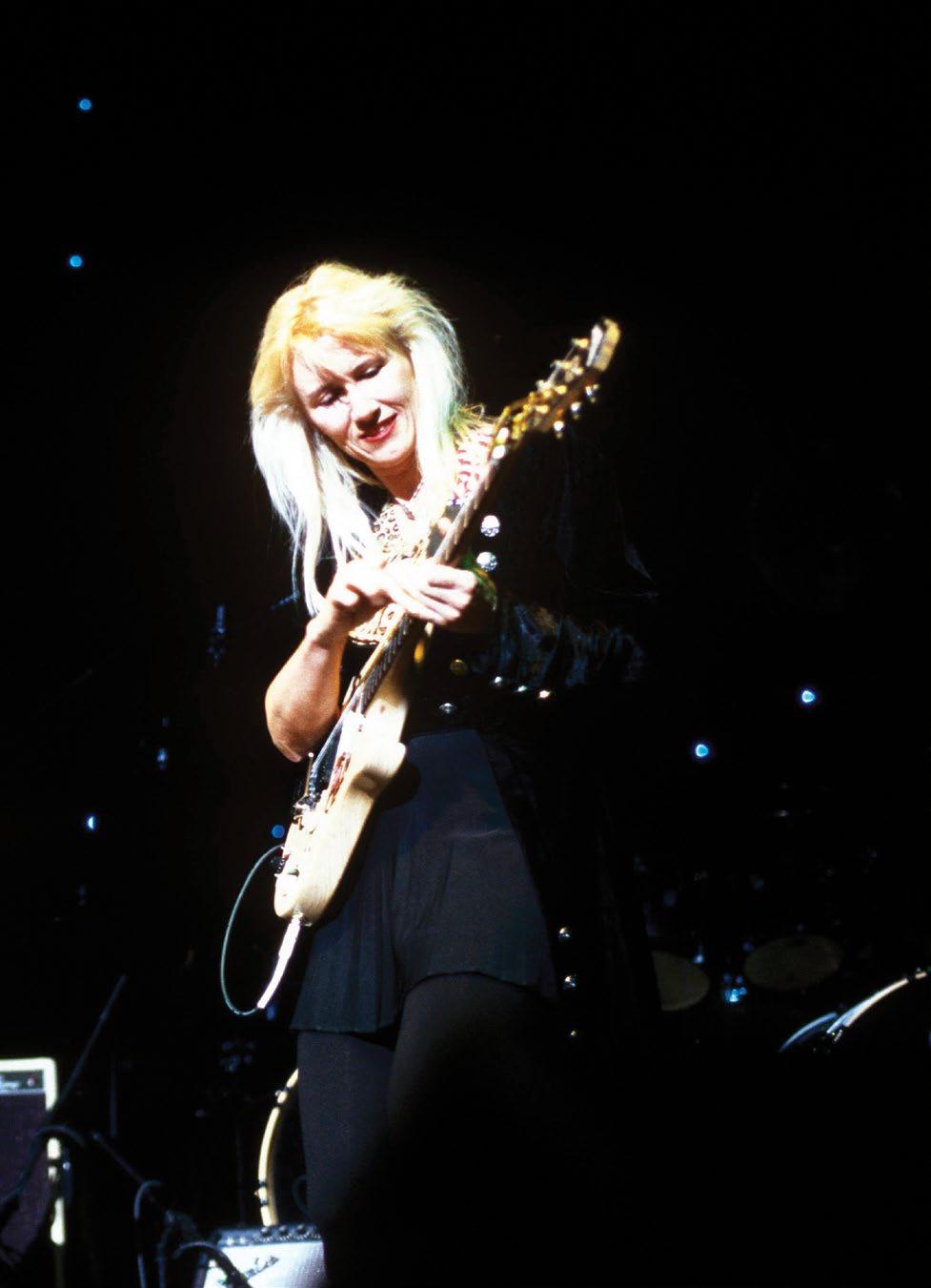
A GUITAR IN Jeff Beck’s lyrical hands had the power to touch our souls in ways we never heard before. It hurts to know he’s physically gone, but he’s left us a lot to remember him by. The most surprising song for me was “Nessun Dorma.” It’s as soul-

“JEFF WAS COMPLETELY and utterly unique, and the kind of musician who’s impossible to define. And I was absolutely in awe of him,” May said in a touching video posted to his Instagram soon after Beck’s passing, some of which is transcribed here with his permission. “He was only a couple of years older than me, and came from the same area where I came from, but he was a hero to me all along, doing things I kind of dreamed of doing. When I was at school, even, he was already up there, in the Tridents and then in the Yardbirds, doing extraordinary things, and a major, major inspiration for me to try and do the same... not the same, but to give myself a voice the way he had.” May goes on to describe “Where Were You” — from Beck’s 1989 album, Jeff Beck’s Guitar Shop — as “possibly the most beautiful bit of guitar music ever recorded, alongside Jimi Hendrix’s “Little Wing.” “[It is] so sensitive, so beautiful, so incredibly creative and unlike anything you’ve ever heard anywhere else. Of course he had his influences, too, but he brought an amazing voice to rock music which will never, ever be emulated or equaled.”
May recalls growing up in the same area as Beck, and how he was inspired by seeing him play as a youngster. “He came from my area, so he was a local boy. I saw him play so many times, always with my jaw on the ground, thinking, ‘How does he do that?’
I often think it must have been like being around Mozart and seeing that incredible genius at work and wondering where it could possibly come from; how could he be that great? If you were with Jeff, if you were around his house, he’d come out from the garage, having been under one of his cars for the last few hours, his fingers all covered in grease and muck and looking like he’d just kind of crawled out from a ditch somewhere, and he’d pick up a guitar and this beautiful, beautiful, sensitive music would come out.”
May concludes: “He was wild, he was unquantifiable and extraordinarily difficult to understand, but one of the greatest guitar geniuses the world has ever seen and will ever see. God bless you, Jeff.”
JEFF IS THE ONLY GUITAR PLAYER I WOULD HEAR WHERE I KNEW WHAT HE WAS DOING, BUT I COULDN’T UNDERSTAND HOW HE COULD DO IT SO ELEGANTLY, EFFORTLESSLY AND WITH SUCH BADASSERY”
—STEVE VAI[ from left ] Beck with Jennifer Batten in the U.K., September 13, 2005 Beck with Brian May in London, September 5, 2011
ful and lyrical as any operatic version I ever heard. The heavenly rock ’n’ roll band has a new angelic voice unlike any other. Rock on as boldly into eternity, Jeff Beck, as you did here on Earth.
WHEN WE WERE recording Hysteria in Holland, Mick Jagger was doing his second solo album with Simon Phillips on drums and Jeff Beck on guitar. You can’t hear fuck all through a studio door but I’m still trying to listen because I know they’re in there! Then the door opens and it’s Jagger. He goes, “Hey man, come on in!” So me and [Def Leppard drummer] Rick Allen went in. We’re sitting in the control room with Mick Jagger doing a live vocal, and there’s Jeff Beck and Simon Phillips playing live with Doug Wimbish on bass. It was completely surreal. Some people are just purely expressing themselves in a beautiful way. That’s why Jeff Beck was Jeff Beck. I think the integrity of your actions makes you happy. Jeff could have been in the Stones, he was of that era, but he still had stuff to say. Some young artists want to be famous above everything else. They want to be noticed, and that’s not the Jeff Beck thing. [Beck said] “I want keep my integrity and I want to express,” and that’s beautiful. That’s really rare, and I think he was completely happy with choosing that.
“CAUSE WE’VE ENDED As Lovers” is among the most timeless instrumentals. Not a singer in sight, yet Jeff’s playing is so “vocal” — it just reaches inside and caresses your soul! Another moment in Beckology that knocks me out is his searing duet with Joss Stone on “There’s No Other Me.” Funky, sexy, mysterious... Then the chorus kicks you right in the arse. In headphones, it’s a landscape of guitar magic and majesty.
MY FAVORITE IS “Sophie.” It reminds me of the kind of music I aspired to in the late Seventies and the style I used to hear at clubs in L.A. like the Baked Potato and Dante’s. The first two sections are kind of quirky and disjointed in a great way, but when the refrain hits — pure joy. It’s fireworks. It’s celebratory, triumphant, hopeful and perfectly executed. His phrasing, dynamics and intonation are, as always, perfect. He just never stopped getting better. Rest in peace, Jeff.
(KK’s Priest, ex-Judas Priest)
JEFF BECK WAS a great inspiration and an

exceptional innovator, and he played such an important role in the evolution of guitar music as we know it today. It’s too hard for me to pick a favorite, but his unique style and superb musicianship will be missed by everyone all over the world, including us guitar players, for a long time to come. Rest in peace, Jeff.
(Tyler Bryant & the Shakedown)
ONE OF MY favorites has always been “Blue Wind.” It’s such a brilliant riff and melodically so cool. I’ve always loved trying to play that one. What a massive loss. Rest in peace, Jeff Beck.
I’M A BIG fan of all of Jeff’s stuff, but I really wore out Truth and Beck-Ola as a teenager. “Let Me Love You” is my favorite for its sheer irreverence. What an amazing player.
JEFF BECK WAS a legend and innovator. His guitar work and solo on “Nessun Dorma” from Emotion & Commotion is definitely my favorite; the crying emotion of his playing and the soaring crescendo has sometimes brought me to tears.
WHAT CAN I say about Jeff? What comes to mind initially is, Wow! What an innovative master of his craft! To say that I’m highly inspired by him would be an understatement. Actually, it’s way more than that. When I think of his rendition of “Somewhere Over the Rainbow,” I tear up now as I type this. I’d awaited the time and hour that we would’ve crossed paths and been able to have a musical conversation; I’m not sure my emotions would’ve been able to take it, but I sure would’ve given it my best shot! To say the least, yet another master is gone way too soon. But I’m grateful for the amount of time he was given to us to be inspired, influenced, moved and every other verb or
I FIRST MET him at the Iridium in New York City, and I remember he was a sweetheart, and then once he got up and played, he was brilliant, as usual. But going back, I still remember when Truth came out, which had the “Beck’s Bolero” instrumental on it. It was a classic song and a huge influence. And what it actually did for me, besides it being my favorite Beck song, was it inspired me to record “Fractured Mirror” on my ’78 solo record. And since I left Kiss, every solo record I’ve done has had an instrumental on it, which continues to this day. So, Truth made me realize that an instrumental could work. It gave me the courage to try because I had never done that before.
Losing Jeff Beck is huge. It’s so big that I can’t even put it into words. Jeff was almost in his own category and was probably the top guitar player. Some of my favorite guitar players are guys like Jimmy Page and Eric Clapton, and those guys are all great, but Jeff was multifaceted beyond even those guys. He had his own technique that was not to be believed, and I remember the first time I saw him perform live; it blew my mind. The guy was a genius who could do anything.
It’s devastating. I don’t think it’s really hit me yet, but it makes me feel my mortality because I’m 71. We won’t ever forget him; his legacy will live on through his music until the end of time; it’s something all of us guitar players aspire to, you know? Through Jeff’s music, he’s still here with us. It makes me hope that when my time comes, that I’ll be remembered in the same way he is. That’s all we can hope as musicians, that the legacy stands up. I know Jeff’s does. He was a hero to me and many others.
IT’S DEVASTATING. I DON’T THINK IT’S REALLY HIT ME YET, BUT IT MAKES ME FEEL MY MORTALITY BECAUSE I’M 71. WE WON’T EVER FORGET HIM” —ACE FREHLEY
JEFF BECK WAS a miracle. I see him as the chosen one. His touch on the instrument created profoundly beautiful soundscapes that held the heart of the listener in its intoxicating heaven. No other guitar player has evolved so dramatically past their prime as he did, and at 78 years of age he played as if he was still in his prime. It’s impossible to quantify his hallucinogenic wizardry.
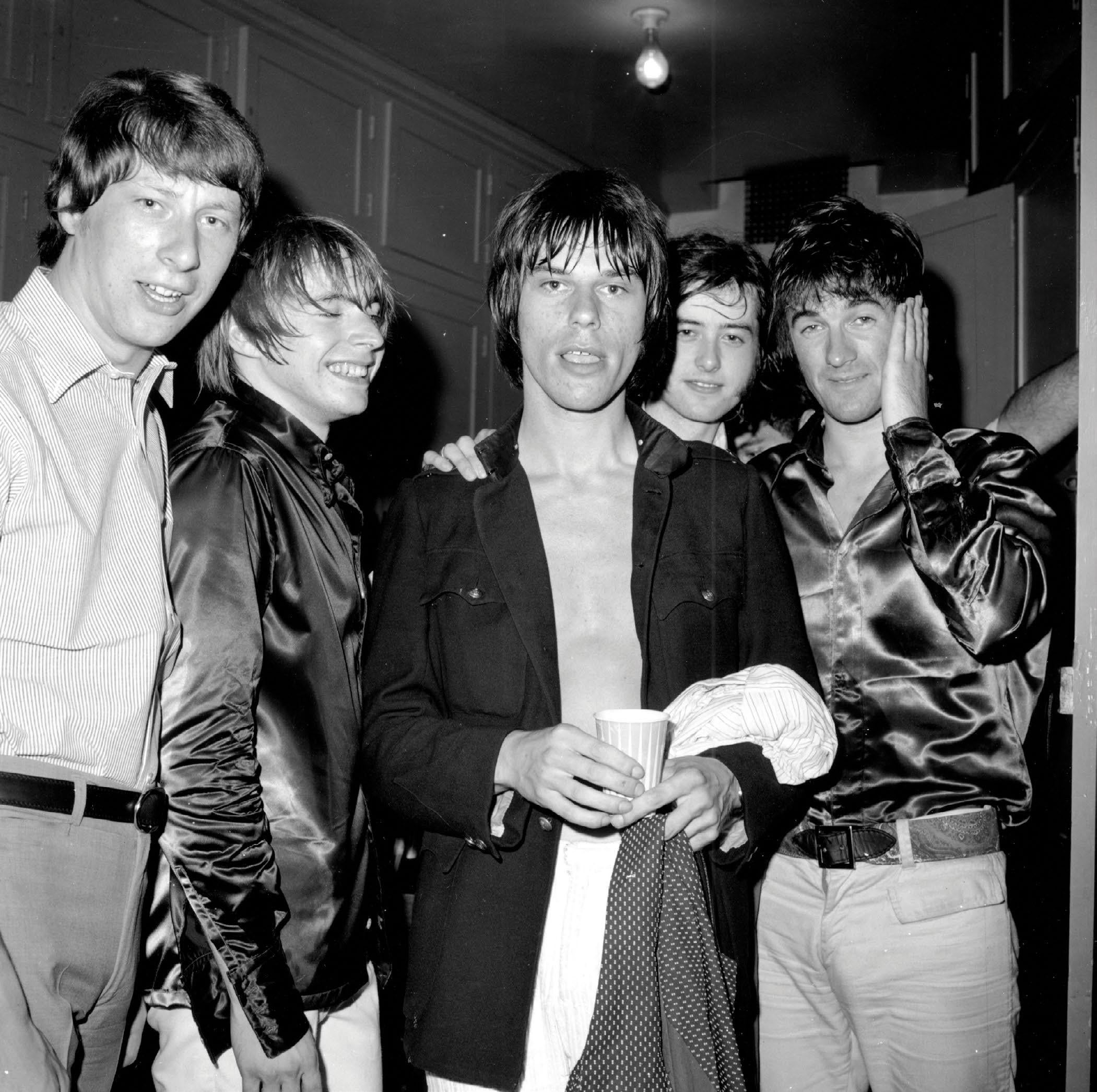
As a guitar player, when I hear any other guitar player, I basically know what they are doing, although I may not be able to do it, but Jeff is the only guitar player that I would hear where I knew what he was doing, but I couldn’t understand how he could actually do it so elegantly, effortlessly with such badassery.
I was fortunate enough to have met him four or five times and he was always so kind, warm and engaging. But the thing that struck me the most was his teenage-like sense of humor. He loved to laugh. Jeff was 78 but also 17. He knew little about music theory but used his inspired ears to weave his tapestries of sonic brilliance.
I can’t imagine my guitar life without him. When Blow by Blow came
out in 1975, I was 14, and it went straight to my heart. I meditated on that record, along with Wired, and learned every song. I then acquired his full catalog and listened with intense interest to every new record he released. Time and time again I was surprised and stunned with his evolution, and I feel that in his later days he truly blossomed into a potential that was unexpected. He was a craftsman of the highest order. The word unique has been overused and watered down, but Jeff represented the superlative meaning of that word.
After I heard of his passing, like many I was stunned and gutted. And like many, for the last few days he has been on my mind quite a bit. After the initial shock and sadness, I started to feel a deep appreciation and gratitude for all he has given us. When you find an artist like Jeff, it’s like finding a life treasure that keeps giving. The love and appreciation for him can feel overwhelming at times, and in this vast appreciation, there’s a little space for the sadness. But the joy is much greater. At 78, he was still delivering. He came, he saw, he played and he enriched our lives. Thank you God for Jeff Beck.
adjective one can think of. Forever in the thoughts of every guitar player I know! Fly on, my friend.
“I AIN’T SUPERSTITIOUS”! Amazing playing. Best wah-wah ever.
LIVE AT RONNIE Scott’s is one of the greatest guitar performances in history. It’s up there with Jimi Plays Monterey and others. The entire concert is dazzling, but my favorite moment is Jeff’s incredible performance of the Beatles’ “A Day in the Life,” which is followed by a standing ovation from a smiling Jimmy Page in the audience. Beck was one of the few guitarists who never stopped developing his sound, technique and ways of self-expression throughout his career. When I watch Jeff play in his later years, it’s so effortless that it’s almost as if he’s not even there. It’s just a flow of energy coming from another place.
MY FAVORITE JEFF Beck song is his version of the [traditional] tune “Greensleeves.” I grew up playing it on piano, and his rendition on the acoustic guitar is so beautiful. Hearing different melodies and guitar techniques throughout the piece is so inspiring; it really pushes me to be creative when I do covers.
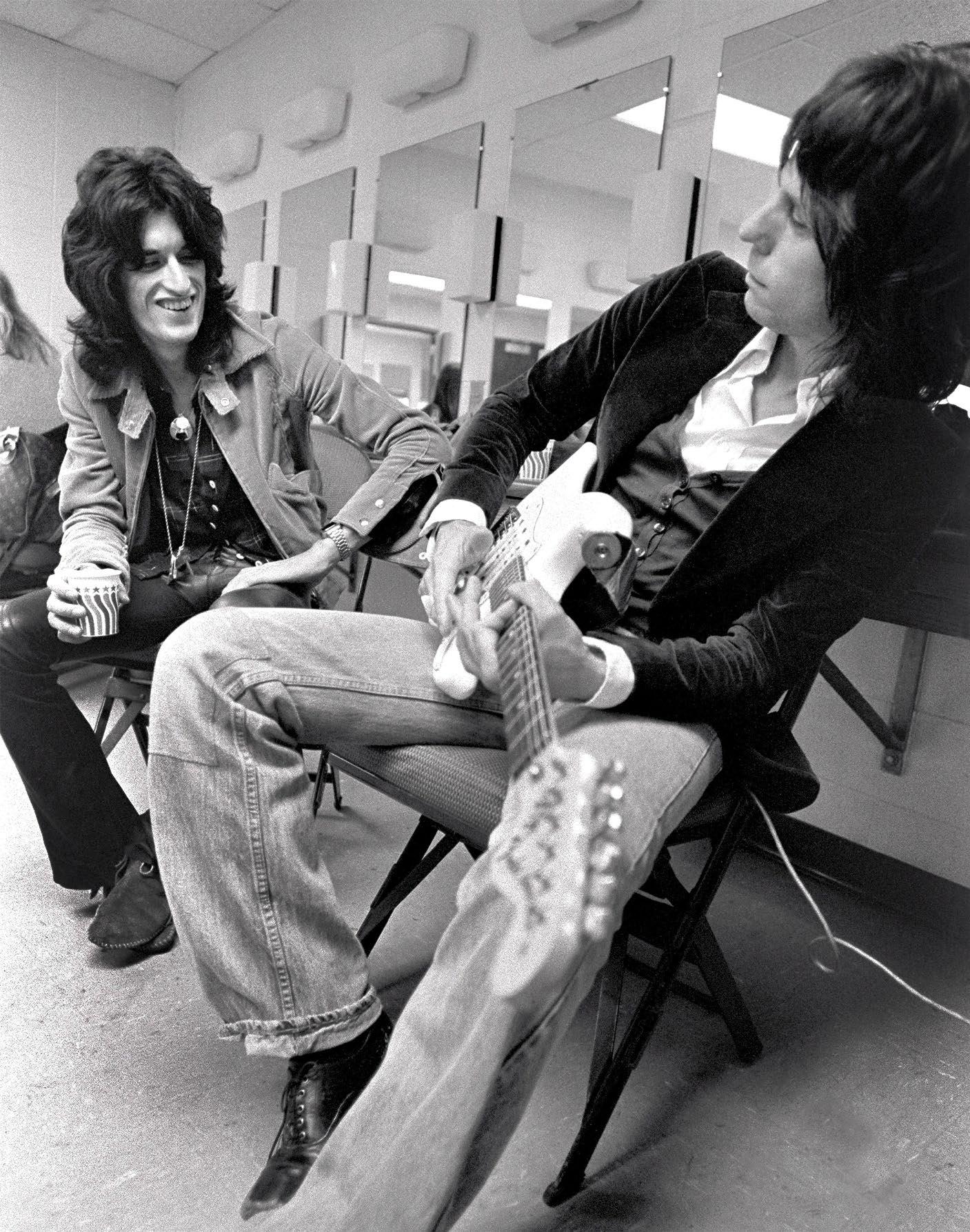
WHENEVER HE TOUCHED the guitar, Jeff would push boundaries and play a melody or something you’d never expect. He always put his touch on it, and you always knew it was him when you heard him play. The way Jeff played, he truly became part of the guitar in a way no other guitarist ever has. There have been many great players, but no one ever did that. I would watch him play, and I’d be thinking to myself, “How the hell is he doing that?”
He was insane as a live player, and I remember going down to Atlantic City to see him play at the Hard Rock Cafe. I was blown away by the whole show, but then for an encore, Jeff launched into a rendition of “Somewhere Over the Rainbow” with this slide work that went up and then down over the pickups... it was unreal. I was sitting there watching him and thinking to myself, “This guy’s sense of his tone is spot on. His slide work is unnaturally good.” You would swear he was putting his guitar through some computer program, but he wasn’t; he was just a savant. Even when you watched him do it, you still couldn’t believe he was doing it.
THAT’S EASY — “Freeway Jam.” It showcases all of Beck’s signature tricks. The tone and experimentation with effects, the early pioneering skill with the whammy bar, and the hybrid fusion of rock, funk and jazz, all wrapped up in a song that is chock full of hooks and — fun fact — brilliantly produced by Beatles producer George Martin.
MY FAVORITE TWO Beck albums are Truth and Beck-Ola. Both are phenomenal, with absolutely brilliant songwriting and playing from all involved. One of my favorite songs is “Plynth (Water Down the Drain).” It’s funky and rockin’. Jeff’s playing is so unique, fluid and brilliant. He was an absolute giant of a talent. We’re going to miss him.
I LOVE JEFF’S show at the legendary Ronnie Scott’s Club. The whole concert is phenomenal, but “Beck’s Bolero” is my favorite. In this three-minute composition, he begins with his gorgeous tremolo notes — his signature and amazing mix of tremolo and
I AM SAD THAT I LOST MY FRIEND... BUT HE LEFT US WITH A LOT OF INCREDIBLE MUSIC AND MEMORIES, AND HE MADE A REAL IMPACT ON MY LIFE” —JOE PERRYAerosmith’s Joe Perry backstage with Beck in Providence, Rhode Island, October 7, 1976
He would do stuff like that with his whammy bar, too. He would play slide-sounding solos but using the whammy bar and harmonics. He got so much out of his guitar with just a couple of pedals and the whammy bar. It was like that from the very first time I saw him back in the early Seventies with Rod [Stewart], Ronnie [Wood] and Micky [Waller]. I saw him on a tour when he stopped in Boston — this was before Aerosmith, I was a kid — and I remember being 17 or 18 and having my mind fucking blown, man.
I remember waiting at the stage door after the show; it was just me — and Jeff finally came out... I was stunned. It was just Jeff and his Les Paul, and I just stopped everything and said, “Jeff, I just have to shake your hand; you’re the best in the world.” And he looked at me and said, “Thanks. You don’t seem like just another geeky kid from the crowd.” That was the first time I shook his hand; I had no idea we’d become good friends. And that was the reason I started playing Les Pauls.
So I am sad that I lost my friend. I’m sad, and I always will be. But he left us with a lot of incredible music and memories, and he made a real impact on my life dating back to that show in Boston. You’ll always have people who will try and emulate his tricks, but there
will never be another Jeff Beck. No one will ever play like him again. I know that for sure. I’ve never heard anybody play with that level of creativity and sensitivity. He was such a hard-ass guy, but he’d come up with these ballads, and I loved that about him. He’d have to take a break from working on his cars to go on tour, so I guess he stopped getting his hands dirty and went on tour when he needed a new engine block. He loved those cars, but when it came time to rock, man, forget it.
This will probably surprise people, but I think my favorite record of all was his last one, [2016’s] Loud Hailer. I listened to them, and they’re all amazing in their way, but Loud Hailer blew me away. Jeff came up with some sounds on that [album] that are just amazing. After it came out, I remember listening to a couple of the tracks in the backseat of a car with him; he was very proud of it.
Jeff was one of a kind, man. He’s the kind of talent that comes along once in a generation if you’re lucky. He did come along, and he sure left his mark. I will miss him every day for as long as I’m alive. I’m thankful I got to know him as a friend, and I’ll always cherish his music.
commanding it by a supernatural force. The damn thing was screaming, and the audience was returning the cries of his ax in pandemonium.
MAYBE IT’S A bit of a pedestrian pick, but Blow by Blow and Wired as a one-two punch is about as good as you can get. Those records will always sound like the future, which is an almost impossible feat to achieve. Jeff Beck excelled at it.
“GOODBYE PORK PIE Hat” from Wired is the most complete telling of a musical story and a conversation between the different guitar personalities involved. Jeff’s head, heart and mind are very apparent there. The different tones, the bursts of high-octane, bent blues notes offset by the sweet, clean tones of beauty, and the choices of notes against the chords... it’s simply the greatest example of taste and tone ever recorded by a rock guitarist.
slide guitar add-ons, then goes into a classic rock riff, solo, back to the main melody, and finishes it off in his classic “crescendo.” Another wonderful creative cooperation I like is on Roger Waters’ Amused to Death, with Jeff’s gorgeous guitar licks mixed with Roger’s timeless sound.
HIS PLAYING ON “Rice Pudding” from Beck-Ola was mind-blowing. But a much more obscure track, “I’ve Been Drinking,” which is on a U.K. greatest-hits album (with Rod Stewart doing some of his best singing), has Jeff doing maybe my favorite [Beck] guitar solo; it is so heartfelt, perfect and short. His fingers speak as only the best can do. You always know it’s Jeff Beck. Only B.B. King, Jimi Hendrix, Carlos Santana, Leslie West, David Gilmour, Mark Knopfler, Albert King and Eddie Van Halen are so blessed.
I DEFINITELY HAVE to go with “Cause We’ve Ended As Lovers.” It sounds like the guitar is crying and talking to me. The emotion and expression from his playing still give me goosebumps. Jeff was truly amazing!
“CAUSE WE’VE ENDED As Lovers” from Blow by Blow. I’ve played that song since it came out in 1975 whenever I want someone to take me seriously as a guitarist. I even played it at my wedding to my first wife and a million other times. And whenever a young guitarist has asked me for advice, I tell them to get Blow by Blow, which is easily the best guitar instrumental record ever.
MY FAVORITE JEFF Beck moment is in [the 1966 film] Blow-Up, when he smashes his guitar due to a faulty amp. Growing up, I had a copy of Truth, but I think I was too young to understand it. I didn’t make the connection that they were the same person, but as I grew older, that music became very meaningful.
MY FAVORITE JEFF Beck performance is “Train Kept a-Rollin’,” and my favorite moment was watching him from the side stage performing live with the Yardbirds at the IMA Auditorium in Flint, Michigan. Jeff stood that Stratocaster on its edge and was waving his arms at it as if he were
AT THE 2012 Kennedy Center Honors, Beck and Beth Hart paid tribute to Buddy Guy. It was so amazing because, throughout his career, Beck was so unselfish with the spotlight and always tried to make others shine. In this moment, he created a perfect backdrop in an absolutely iconic blues song (“I’d Rather Go Blind”) to blow everyone away and, at the same time, let his genius shine through without overshadowing Buddy. It was a perfect threading of the needle, an amazing performance for everyone, a gift of real appreciation and love for Buddy, and anyone who was not as giving and unselfish as Jeff could never have done it so well.
ONE OF MY favorite moments from Jeff Beck is seeing him play for the first and only time in New Jersey — at the Starland Ballroom. P-Funk played there the day before and stayed the next day as a day off. Starland Ballroom generously hooked us up, and how cosmic it is! He was absolutely brilliant and amazing. He came from another planet — definitely one of the greatest of all time.
[I met him] at the Montreux Jazz Festival in Switzerland, where P-Funk played. He was very nice and cordial, an unbelievably cool dude. Last but not least, what I cherish about this amazing artist is listening to his records, such as Who Else!, which became one of my optimum experiences. That album floored me. Jeff Beck is, without
a doubt, one of a kind. Like the album title says, “Jeff Beck — Who Else!”
doesn’t get much better than that.
Travis
and Cambria)
WHEN I LISTEN to “Cause We’ve Ended As Lovers,” I immediately return to my childhood. I feel like I know I have had deja vu more than once to that song. Which is always a sign that you have heard it in countless scenarios of your life. I have tried to emulate the playing and approach in that particular song millions of times. But it’s Jeff Beck, so… not gonna happen. Every note and riff Jeff Beck played somehow had a certain wisdom to it. As if the way he played was always ahead of its time. I guess that’s what happens when you hear the playing/writing of a genius.
“THE THRILL IS Gone” live in St. Louis, May 19, 2015. Only days after the passing of B.B. King, Jeff and the band paid tribute to B.B. by playing this song. I was blown away at how much it sounded like B.B. and Jeff all at the same time. I had the pleasure of talking with him afterward about it. “How could it sound so much like B.B. and you all at once? After all, you both have very distinctive and different styles.” He dissected a few trademark B.B. licks and sang them to me and then said he played them in his manner on the guitar. He proceeded to say, “I think it’s pointless to do something if you are going to copy it exactly.” He then proceeded to say you could actually play a guitar solo with two notes by varying the inflections ever so slightly. This is why he was the master of the guitar and why every guitar player looks up to him.
EVEN THOUGH IT wasn’t written by Jeff Beck, my favorite song/moment is “Cause
We’ve Ended As Lovers” [written by Stevie Wonder]. His versions [of this song] are the prime example of “everything Jeff Beck” to me — his unmistakable voice and touch on the instrument, his remarkable improv moments and the way he interprets and emotes melodies — where they absolutely spill out of him. I feel I’d be hard-pressed to find a human who doesn’t feel the emotion in that tune — the Blow by Blow version as well as so many magical live ones.
MY FAVORITE JEFF Beck track is “Theolonius” from Blow by Blow. It makes my mind melt and my booty shake. Jeff Beck, Stevie Wonder and George Martin all together? It
THE LIVE “SOMEWHERE Over the Rainbow” is my favorite Jeff Beck song. You can take your pick from any number of the live versions out there. It is one of the most emotional guitar pieces I’ve ever heard.
THE FIRST TIME I heard Jeff Beck was when he reconnected with Rod Stewart for their version of “People Get Ready.” It still makes my heart sing. There’s something about the phrasing and the way he holds back on the intro melody that gets me every time. This performance taught me so much as a young lead guitar player. It showed me that, ultimately, less really can be more.
“PEOPLE GET READY” is my choice! To hear Jeff Beck and Rod Stewart do their take on it takes my breath away. The tasteful playing and tone are enough to get your ear hooked. Jeff Beck knew when to play the right notes at the right time, and this song is a great example.
WE PLAYED A festival once with Jeff Beck and shared a backstage trailer with just a
thin wall separating us. For about half an hour before he went on, I could hear Jeff warming up and playing these insane solo blues riffs. I was floored. I’ve never heard anything like it. What a great memory and what a tremendous loss.
“TWO RIVERS” FROM Guitar Shop displays everything I’ve ever loved about Jeff Beck: his mastery of the instrument, his compositional acumen and melodic brilliance, his exceptional tonal characteristics and his ability to challenge the limits and the orthodoxies of guitar. Not to mention seeing him nail that song live to the point of making me tear up every time.
WHAT AN AMAZING LIFE and career. From the Yardbirds to 18, his recent album with Johnny Depp, it was a constant upward trajectory, a ball of creative brilliance with zero lulls. I feel blessed that I saw him play in 2010 during the filming of his Rock ’n’ Roll Party (Honoring Les Paul) show at the Iridium, which was incredible. His musicality, feel, technique and writing will live and inspire beyond forever. God bless Jeff Beck.
Damian Fanelli, Nick Bowcott, Sam Roche and Jenna Scaramanga contributed to this story.
I BECAME AWARE of Jeff Beck a bit late in the game through my dear friend Jason Becker, who was constantly extolling Jeff’s many virtues. Beck is a peerless role model, especially in the sense that his playing identifies him immediately, and it is always played with so much finesse and the depth of a master. I knew how much Jason admired Jeff, so I made the rather foolish decision to play a Jeff Beck song for Jason at one of the first Jason Becker tribute concerts in Chicago. Doing that sounds nice on paper, but Jeff’s touch is inimitable; you would have to literally live his life and go through his experiences to play like that. And then you would need a master’s degree in unique techniques that he invented and polished over the years.
Still, I love Jason, so after playing a bunch of my own songs, I threw caution to the wind and ended my set with “Cause We’ve Ended As Lovers.” The song itself is a relatively simple and familiar melody that many guys have played pretty well, as it is kind of a “guitar standard.” The thing is, the more simple a melody is when it’s in the hands of Jeff Beck, the more
exponentially difficult it becomes for others to interpret on the same instrument — because the feelings, inflections and emotions in the original version are Jeff’s and Jeff’s alone. The bill was full of super guitar players, including Eddie Van Halen, who was to follow my set. Imagine the tremendous stupidity (or balls... but probably leaning toward stupidity) I must have had to play a Jeff Beck song in front of Eddie Van Halen... and just before his set, no less. So, I played the song and survived it; maybe it was passable at best. Most likely, it just plain sucked. I am pretty sure it was the latter.
My point here is to point out just what an extremely unique and special identity Jeff Beck is and how playing his music further inspired me to try to carve out my own musical road. I’m not the only one Jeff inspired in this way. There might be something in the fact that when many of us tried to play some of Jeff’s material, we just gave up and sat there in wonder, thinking, “Who am I kidding? I’ll never be able to play like that.” I’m sure we have Jeff to thank for a lot of us taking inventory of what we could do on our own.

IN THIS CANDID, TRUTHFUL AND PREVIOUSLY UNPUBLISHED INTERVIEW, JEFF BECK REVEALS THE BLUES BEHIND HIS 1999 COMEBACK ALBUM, WHO ELSE!
 STORY AND PHOTOS BY CHRIS GILL
STORY AND PHOTOS BY CHRIS GILL
IN MID FEBRUARY OF 1999 I FLEW FROM SAN FRANCISCO to London to interview Jeff Beck. I had interviewed Jeff several times before, starting in December 1992 with a wonderful experience at his home in Sussex where we talked at length about his Crazy Legs album and his hero, guitarist Cliff Gallup of Gene Vincent’s Blue Caps. Over the years I interviewed him about various projects he was involved in and saw and shot photos of him on tour numerous times. But the one thing I really wanted to do was an in-depth interview with Beck about one of his solo albums.
It took almost 10 years after Beck’s previous solo outing, Guitar Shop, was released, but I finally got the opportunity I was waiting for — Player magazine in Japan flew me to London to interview Jeff about his forthcoming album, Who Else!, and Jeff and I met up on February 19, 1999, at London’s Royal Garden Hotel, near the British royal
residence, Kensington Palace. In the afternoon, I shot photos of him in the private confines of a basement lobby surrounded by meeting rooms, where occasionally a bewildered businessman or two would walk by and give us a confused glare. That evening we met up again at the bar on the hotel’s top floor to do the interview.
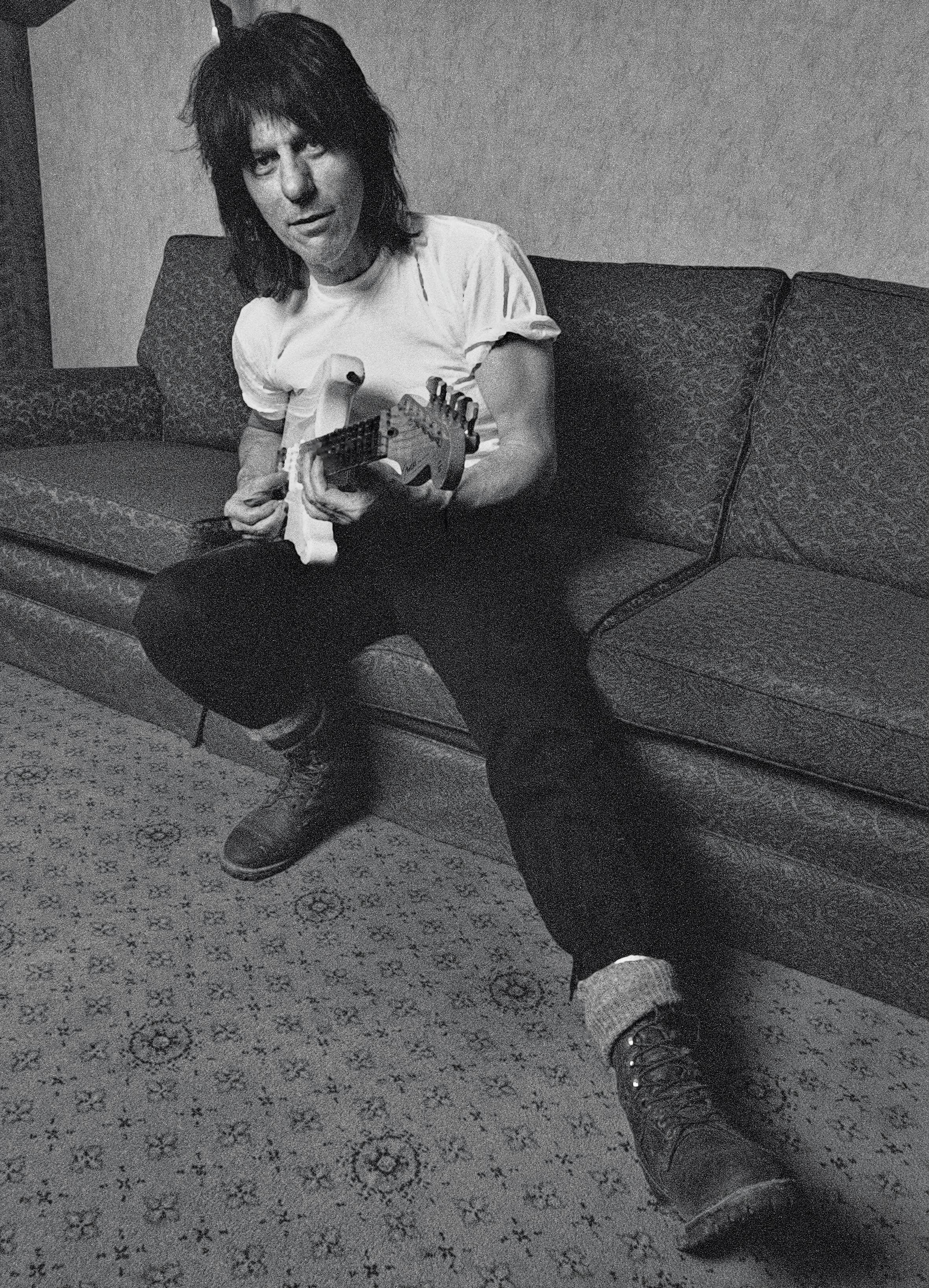 Jeff Beck relaxes in a basement lobby at London’s Royal Garden Hotel, February 19, 1999
Jeff Beck relaxes in a basement lobby at London’s Royal Garden Hotel, February 19, 1999
When I showed up, Jeff was waiting at the bar and drinking a beer (it was a Beck’s, of course — what else!). We talked about the album’s background, including its beginnings in 1996 with sessions he had done in Los Angeles produced by Steve Lukather, as well as the smoking-hot band consisting of guitarist Jennifer Batten, bassist Randy Hope-Taylor and drummer Steve Alexander, that he formed in 1998 to road test new material. During the course of the interview, Jeff was extremely and unusually candid, honest and forthcoming about the struggles he went through to bring the album to fruition. My biggest and only regret was that this interview would be published only in Japan and in Japanese.

After Jeff passed away, I revisited this interview for the first time in more than 20 years. The section where he talked about having only a limited time left on this earth choked me to tears. Here he was only 54, and he was already facing his own mortality. I’m glad he lived almost another 24 years after that — although I wish he could have stayed with us a lot longer — but I’m especially relieved that he kept the promise he made back then to be more prolific and released five additional studio albums and eight live albums. He also toured frequently.
The following is a condensed version of the interview, published for the first time in English.
I’d like to start with the question everyone has probably been asking you Which is, why has it taken me 10 years to come out with a new album? I had a few diversions, subversions, all kinds of things. The last nine years were rough for music. It has been jumping around all over the place like a fox. I could never tell where anything was going to go. I was also really depressed about not being able to keep the original three-piece band together: me, Tony Hymas and Terry Bozzio. That was such a cooking band. And the idea was great — for Tony to go bananas on the keyboards and cover bass, rhythm and everything else.
Unfortunately, we didn’t get the dimension that we wanted. I felt that after the initial tour, the failure of the album [Guitar Shop] to do anything more than a little blip was very depressing. We put a lot of work into it. Bear in mind that Guitar Shop was a startup album as well, after another long period of no output from me. I was doing a lot for other people, and I thought, “Well, I can make a living doing this.” So I went into this rather uncomfortable but laidback mode. Unfortunately, the closer you are friends with who you’re working with, the less you’re paid. I often did things for
nothing because they were my friends. I got really disillusioned with my playing as well. I knew there were these other guitarists coming up around the block, and they could really play.
Did you feel like they were a threat? Not a threat. It was just telling me it was time to move on. I wasn’t going to let that happen, but they did shove me aside for a while. I just thought I should be an observer rather than a participant. Right in the depths of my depression, I put some money into building a home studio. When all else was lost, I did the one thing I never thought I’d do, and I built my own studio. That gradually started the healing process — not that there was anything broken but me.
Everyone goes through drug rehab and all that. I never had that problem. But I have other problems, like having difficulty holding relationships together. It’s really confounding to be blasted in the newspapers by a status-climbing girlfriend. It’s a bit rough. It was a compound series of events that I could have done without. The capper of it all was when the newspapers were coming around and banging on my door. I had to wait for all of that stuff to blow over before I felt I could start to pull myself together.
I want to talk about my ordeal one day. It’s sufficiently charged with interest, either in novel form or as a biographical movie. There’s a hell of a movie in there. I could sell the rights to Aaron Spelling. You could call it “East Sussex, TN 566” or “Sex in East Sus-
sex.” [Laughs] I also distracted myself by restoring my house, which was a great thing to do. It gave me a complete other interest besides my guitar, cars and getting into trouble. Having made a series of lame excuses, here we are in 1999.
Did the problems you were having with your relationships influence your music at all?
I’ve got some pretty deep blues on tapes lying about. I went into this mode where I wanted everything I’ve done that was lying fallow destroyed. All the stuff that was boiling around eventually made it. I got so messed up with loads and loads of tapes that I had no idea what I had done or where it was. There were no labels on the DATs or cassettes. I would just shove something in the deck, and if it didn’t make me smile I’d take it right out. Usually it just made me real depressed. On seldom occasions it might have a nice, pristine start to something really good. I didn’t have anybody around to say, “Wow! That was really good. Stay with it. The hook is great.” I preferred to wait to get Tony Hymas involved so I could pick his writing to pieces instead of criticizing my own work.
Tony has often been one of your most helpful critics.
It’s torture for him listening to me trying to interpret his songs. And it’s torture for me to try to interpret his songs, to try to supplant some kind of notion of what I want to do without sounding like some goof who can’t remember what I want. I got pretty graphic with some of the stuff that you hear on the record.
Is that why things didn’t work out with Steve Lukather? Was he too much of a fan to tell you when he didn’t think things were as good as they could be?
He came around at a bad time. The idea was to get Steve involved with his wacky humor, but at that time I was about as low as I could get. He did lift me a bit, but it was a temporary thing. It probably would have been better to just let me wallow in my misery for a while. I ended up getting this false sense of elation during the writing period. You’d probably like some of the material. I’m sure there are people who would freak out over it.
Steve was definitely raving about it. There was some good stuff. Don’t get me wrong. I just wasn’t hearing that little birdie whispering in my ear going, “This is the stuff.” If that doesn’t happen, I’m done. I need to go out somewhere else. I need to move along.
“I WENT INTO THIS MODE WHERE I WANTED EVERYTHING I’VE DONE THAT WAS LYING FALLOW DESTROYED” —JEFF BECK
But you put a good amount of time into it. You recorded over at his studio in Los Angeles for a few months and then about a year later the two of you were working at David Gilmour’s studio in London. The first initial try out took place at Steve’s studio in Los Angeles. Everything was great. Then I came back to L.A. again to start recording, and I was in the middle of these problems. And I got very ill. It was very serious. I don’t think I felt right for four months. I slowly made a gradual recovery. After three months, I went out and tried to wash my car and fainted. I just brushed the sponge over the roof and I collapsed. I really thought I was finished.

It was some bizarre strain of Legionnaires disease, not the strain that kills you, but something related to it. It was horrible. I went to the doctor and he said, “I don’t want to shock you, but I’ve looked at other patients who have the same thing as you and it may take months before you recover.” I didn’t need to hear that.
Eventually I got better and we started up again at David Gilmour’s studio. Everything was perfect. The weather was wonderful. But we were still stuck in a rut with the material. Along comes Tony with three great tracks that blew everything else I’d written into the weeds. I suddenly sensed there was a disagreeable situation with trying to juxtapose his material on top of what we already had. It sounded like another album. We couldn’t make it flow. So I thought that I’d better be faithful to Tony because he’s always written from the heart. What I’d written was promising, but it needed development. Steve is such a good soul that even when I played badly he’d say, “Man, it’s boiling hot in here!” But I needed somebody to push me.
You share the same affliction that has bothered guitarists like Eric Johnson and Danny Gatton. It seems like what you hear in your head is beyond what your fingers can do.
Exactly. The fingers are not saying what the head is saying, or the heart. I was just so frustrated because all I needed was a sillyass melody to get people going. That’s what I do. There are many guitarists who can play like a typewriter. Technically they’re great, but that’s not my style. There’s no Stevie Wonder writing for me anymore. He would write beautiful ballads, and I would just interpret them the way I heard them.
There was talk of you collaborating with Eric Johnson, and you worked with John McLaughlin. And you’ve been working with Jennifer Batten in your band. Did you start working with other guitarists to push yourself?
It was more because I wanted to work. But it was a bit of a blow, only having the odd chance to play with people every few months. I found myself getting into the mode where I was thinking, “The phone will ring today. Something will happen.” I have to tell you that’s not likely to happen in
my neck of the woods. I don’t have too many musician friends living in my area. In fact, I had very little enthusiasm for any friendship at all the last few years.
I have a couple of good friends who aren’t musicians. One is a film director and the other is a mechanic. I get tremendous confidence boosts from them, but not enough musical input. But having said that, the film director friend was a great support when I suggested doing something that was a cross between the Prodigy and myself. He said, “That’s the stuff. I could hear that working well.” So I developed tiny little snippets of this stuff and sizable chunks of other stuff.
What happened with Terry Bozzio? You managed to get him back for your 1995 tour with Santana.

That was another weird thing. Playing 46 gigs together should have resulted in us coming closer together. Unfortunately, we shouldn’t have done a big, over-the-top tour without a new product. That was bad planning. Doing the gigs was the positive side of the experience. Once again, being disparate characters we pushed each other away.
Tony was obviously champing at the bit to do his own projects, and Terry was starting to make inroads to superstardom as a drummer in his own right. I’m not going to say, “Hey! Come back here,” and take a piece of rope and drag him back when I didn’t have any new material. It was all down to the big “M.” “Where is the bloody material?”
I’m very sad it didn’t work, especially since we had Pino Palladino on bass. I felt sure that we’d get something going. Even though Tony, Pino and I live in the same country, we might as well live 15,000 miles apart. We live our own lives. People say it only takes two steps to get from one coast to another in England, but it doesn’t matter
when you’re living very separate lives. And Terry was living in Austin, Texas, with his wife and baby. It didn’t seem likely, unless we had some really masterful plan, that we could work things out.
Then we came up with another plan, which was to work with Terry and Tony Levin. It would have been very interesting to have Tony playing Stick. Then Jennifer Batten came along and I thought, “Right on! Let’s do a four-piece band.” I think that would have been incredible. But it seemed that Terry and Tony were just on loan. There wasn’t any camaraderie. There was less than there was with the original band.

Over the years you’ve developed quite a collaborative relationship with keyboardists, such as Tony Hymas, Jan Hammer, Jed Leiber and Max Middleton. What drives you toward keyboardists?
The fact that they know chords. [Laughs] The first keyboardist I worked with was Nicky Hopkins, on Beck-ola. He added something, but he also took away something. It was a fair trade at the time. I lost the raucousness. As soon as you hear the piano, it makes things sound civilized. It makes it sound safe and familiar. Before that, I could leave holes — dangerous, great chasms where nothing was going on. I had freedom to pop in and out where I wanted with Rod. It was a tennis match — voice against guitar. I could change riffs to catch Rod’s attention. With Ronnie, I could play different riffs and he’d follow me. He’d just look at my fingers. But when you’ve got a keyboard player looking the other way, he gets lost really quickly.
You went through a few false starts on this album. When did you finally get on the path that led to the finished effort? Having gone through all sorts of negative emotions and disasters as well as a colossal
loss of money, I suddenly came out of this cloud and went, “I’ve got to do something. This is serious.” I went down and visited Tony and said, “Look. Never mind the fancy Lukather session. We need to listen to what I’ve got to say.” I took a bunch of very interesting techno music to him and he stared at the ground blankly. He didn’t seem to be into it.
Then the next thing you know “Psycho Sam” came out of him. I said, “That’s what I’m talking about!” I went down to the studio again and threw some more ideas down on tape. Gradually we pieced it together. It was a slow, agonizing process, but when we started hearing how the band was sounding with the new material when we played live it was very promising.
After that I discovered “Declan,” which was written by an Irish folk artist named Donal Lunny. I love it. It’s a real tear-jerker. If they clap for that song when I play in Ireland, I shall be very happy. I’m worried to see how they respond to this British guitarist playing their hallowed music. I hope I don’t get hit over the head with a bottle of Guinness.
I’ve never played in Ireland either, except recently when I did a crazy weekend with Ronnie Wood and Scotty Moore with D.J. Fontana on drums. That was amazing fun. I did the All the King’s Men record [1997] with them, which was also great. We recorded so much more material that never made it on the record. But it was so difficult to write stuff for Scotty to play. It was a total East/West vibe. There was no excuse for us to play together other than the fact that we respect each other and we wanted people to know that we care for these musicians who are still alive and kicking. Moore and Fontana’s playing was so eclipsed by what happened with Elvis after the Louisiana Hayride.


I didn’t know that D.J. Fontana was once a member of Gene Vincent’s Blue Caps. He replaced Dickie “Be-Bop” Harrell. What a band that must have been! I have a picture and some lost session tapes of a Dallas show with the Blue Caps Mark II, with D.J. Fontana on drums and Johnny Meeks on guitar. I have some very rare footage that I got from the Rock and Roll Hall of Fame. They showed it at an induction ceremony, and I said, “You’ve got to send me this. I’m not going to go on stage unless you promise to send it to me.” I’ve got some tapes from Australian television — Johnny Meeks, with blond hair! And they’ve got no caps on. There he is, chewing gum, singing. He is so sharp looking. The world must have been at their feet back then.

What inspired you the most when you were making this record?
I’m a great fan of the Prodigy. They kick butt and they make that great, wallowing-inthe-mud sort of festival music. I love it. It’s like the Who and the Yardbirds. I love their drum sounds. They’re punky, but they’re articulated and beautiful. It’s not trashy. I wanted to capture that power with my guitar on top of it. I wanted to marry that notion of techno with a real drummer. I ended up using drum machines some of the time, though. I’m not a purist. I’ll go wherever I need to go to get the result.
Did you add any new equipment to your rig or are you still using the basic Strat and Marshall setup?
I don’t have any equipment. [Laughs] It’s still the same old, same old. To me it’s like a Fifties toaster. You just plug it in and switch it on. If I don’t hear me in there, I don’t like what I’m plugged into. There are millions of fantastic guitar sounds, but they always sound exactly the same no matter who's playing. They’re not transparent enough to reveal the character. I could use maybe one flurry of notes with that kind of sound, but I prefer the sound of a really loud amp blasting away. I like for there to be some size. I like to hear the room. I don’t like to stuff the mike right up against the cone.
Your single notes have a horn-like quality, like a saxophone.
I try to avoid shattering the eardrum. A Stratocaster can be too bright. I kill off all of the top end on the guitar by turning the tone control all the way down, and I set the controls on the amp where the throat is still there. Then I overload it to get this honking, choked-up sound.
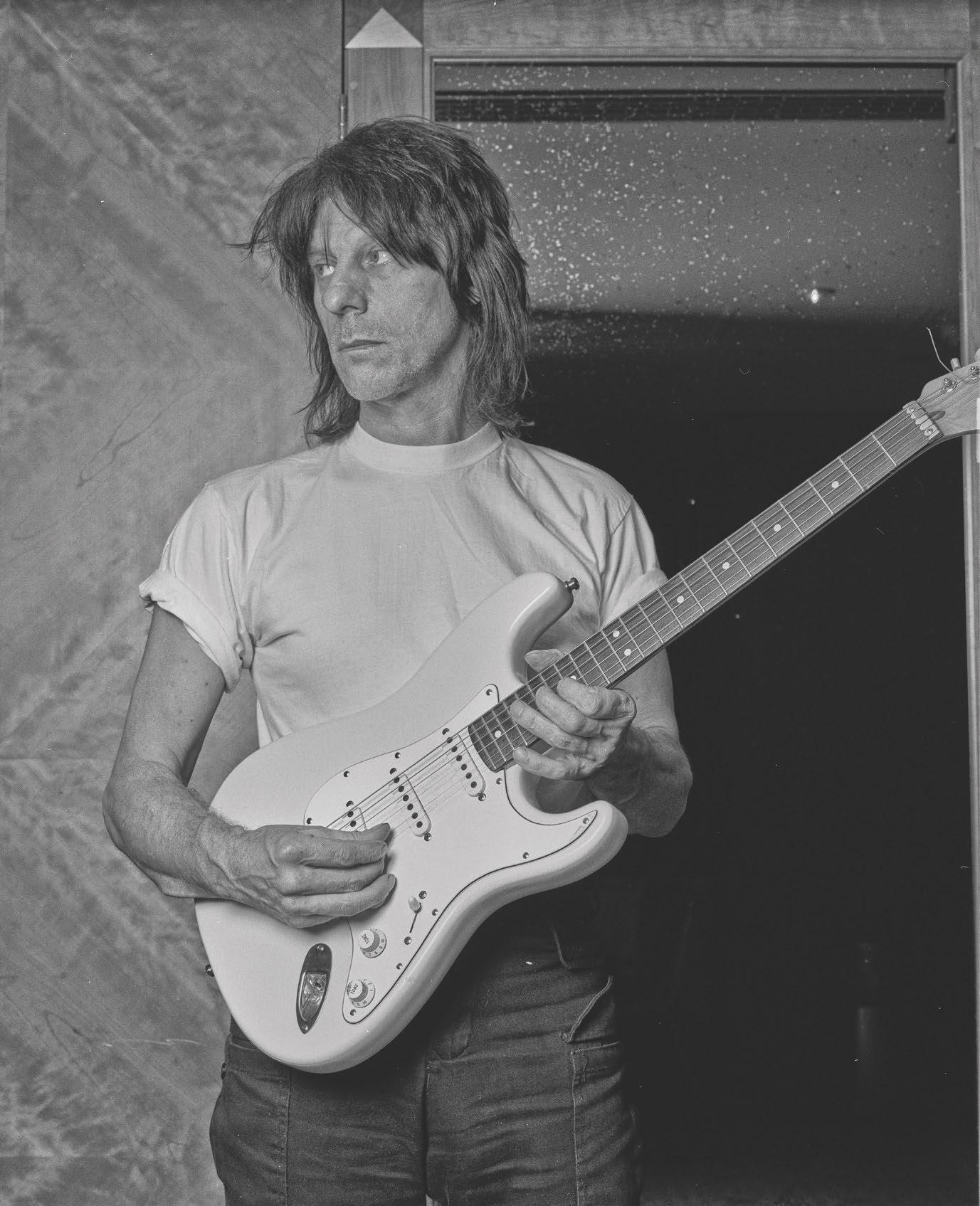
Are we going to have to wait another 10
years for your next album, or have you gotten over that hurdle?
I don’t know if I have another 10 years left. If for no other reason, I only have a limited amount of birthdays left.
It’s about time that I did something. I’m committed in a big way to doing a lot more. I have a lot of stuff left over, so if I see some good results from this I won’t be touching the ground again for quite a while.
Now that I’m in the latter part of my life, it’s best to enjoy it and appreciate it. I don’t want to fizzle out and become some retro act. I’m really concerned about what is going on out there. Television has sunken to unbelievable depths. I can’t believe that we’re entertained by Jerry Springer and watching people kick the shit out of each other. They emulate that here in England, and it is so cheesy. It makes me want to throw my TV out the window. That invention is probably the greatest communicator of the 20th century, but how come for 24 hours a day we get filth like Jerry Springer and all of these rubbishy soaps? There is so much knowledge that is stuffed away that should be on television. If I ever made a mil-
lion quid I’d start my own TV channel. Why do we need 50 channels of sports or to be able to tune in the Italian weather forecast? I don’t get it.
The Internet is much better. You can search out the information that you want. I’m very relieved that I was born when I was born, and not in the Seventies. I’m not envious of that generation.
And then there is the whole “Girl Power” thing. I think women are entitled to kick men’s asses, but at the same time they are mocking us. It’s so easy for them to turn a simple peck on the cheek relationship into “I’ll have your Cadillac, your Porsche and everything else you have.” It’s best to have nothing and marry a rich wife.
You’re much more aware of what is going on around you musically than other 54-year-old rock musicians. Most musicians your age are clinging desperately to the past and trying to revive their past glories. What keeps you looking ahead? I never at any phase in my career felt that that was my time, but now I do. Perhaps it is my turn now.
IN JANUARY 2016, JEFF BECK ASKED ME TO WRITE historical and basic technical info about 10 of his favorite guitars for his book Beck01: Hot Rods and Rock & Roll published by Genesis Publications. The publisher recommended me for the project based on the work I did on Eric Clapton’s Six String Stories, and since I had previously interviewed Jeff about half a dozen times, he was very comfortable with my input and involvement. It was one of the highest honors in my career to be hand-picked for the project. Jeff was one of my biggest guitar influences since day one, as well as a dear friend.
The following guitars represent a great overview of Beck’s career from his groundbreaking stint in the Yardbirds through his very last shows in November 2022 with Johnny Depp. Yes, a few key instruments are missing (like the white mid-Seventies Strat he played on Blow by Blow and Wired), but the inclusion of a few personal favorites that he only played at home and never previously revealed to the public make up for it. Beck01 features large, detailed photos of each instrument, but unfortunately for readers who would like a closer look, the limited-edition book
is long sold out and plans for a general release have not been announced.
1. 1954 FENDER ESQUIRE
WHILE JEFF BECK’S iconic Fender
Esquire which he played with the Yardbirds started life as a 1954 model, it is actually constructed of various parts from the Fifties thanks to modifications that he made to the instrument. When Beck bought the Esquire from John Walker (née Maus) of the Walker Brothers, the guitar still had its original white pickguard, but Jeff quickly replaced it with

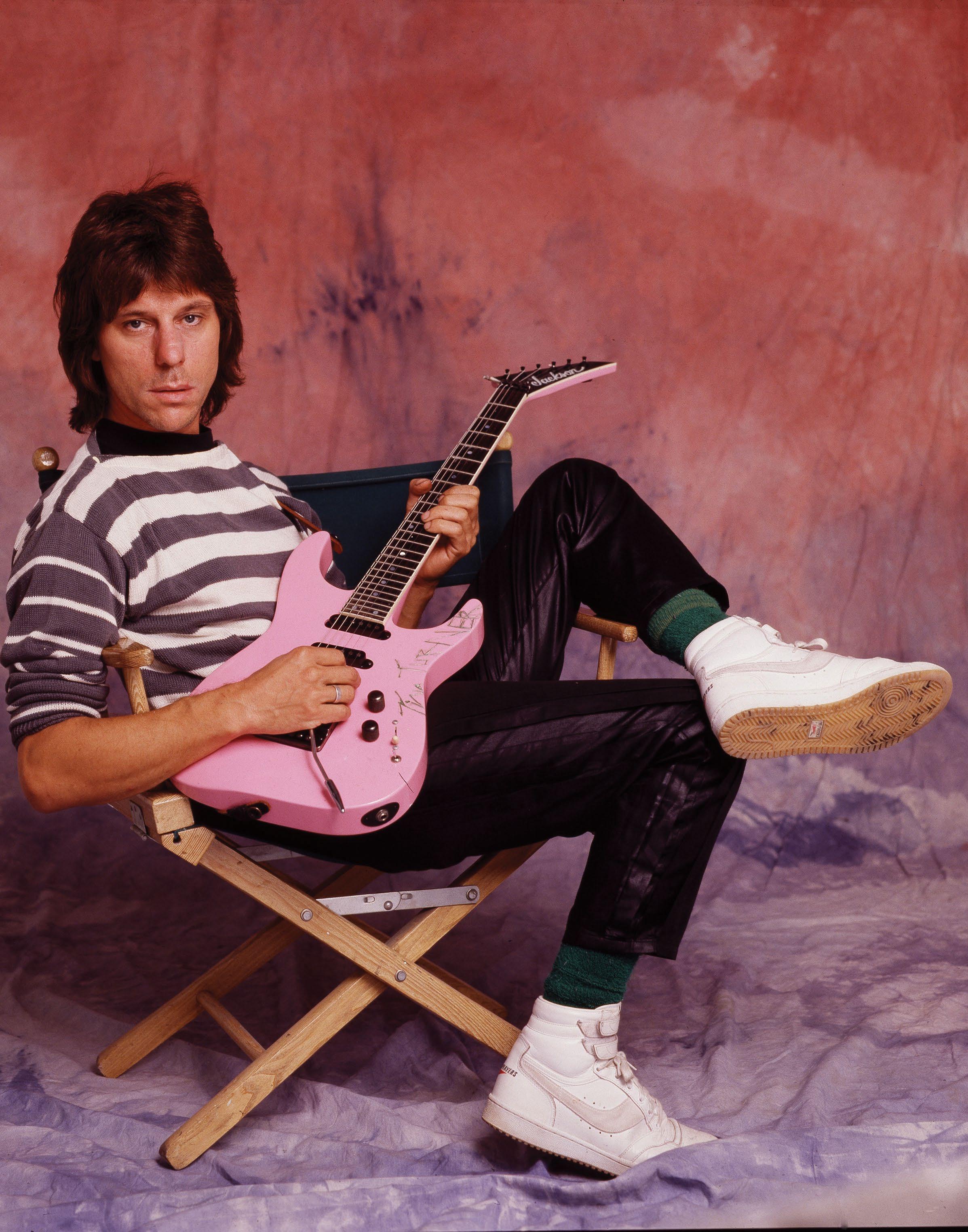 Jeff Beck with his early Eighties Jackson Soloist in October 1984; this guitar appeared on our January 1985 cover
4
Jeff Beck with his early Eighties Jackson Soloist in October 1984; this guitar appeared on our January 1985 cover
4
a black Esquire pickguard because he preferred the look of Fender’s earlier Esquire/ Telecaster models. Because the original steel saddles were rusted, Jeff replaced them with brass saddles from a 1952 Telecaster. The original neck was also broken at one point and replaced with the 1955 Esquire neck it has now.

However, the guitar’s most visible and recognizable modification was performed before Jeff acquired the Esquire. John Walker carved the contours on the front of the body’s lower bass bout and rear of the body’s waist in an attempt to replicate a Stratocaster’s comfortable feel.
BECK BOUGHT HIS first Les Paul guitar — a 1959 Standard — in early 1966 just before the Yardbirds began recording sessions for the Roger the Engineer album. The guitar originally had a cherry sunburst finish, but sometime around late 1967 or early 1968 he
stripped off the finish and left the top in its natural, unfinished state. He also removed the black pickguard that was on the guitar prior to stripping its finish.
Beck played this guitar in the studio and frequently on stage with the Jeff Beck Group during the late Sixties, but after the neck suffered damage in late 1968 he acquired another late-Fifties sunburst Les Paul with exquisite curly maple figuring as a replacement while this guitar was repaired (that sunburst Les Paul was later stolen). The neck currently seen on this guitar, which features an L-5-style headstock with flowerpot inlay, non-original trapezoid fingerboard inlays and Jeff’s initials inlaid at the 22nd fret, was a custom-made replacement installed during the mid Seventies by Strings & Things in Memphis. The original creamcolor humbuckers were also replaced by black pickups during an earlier repair.
IN NOVEMBER 1972 while Jeff was passing through Memphis on tour with Beck, Bogert & Appice (still called the Jeff Beck Group at the time), he bought this guitar from a fan named Buddy Davis. Originally it was a 1954
1. The ’54 Fender Esquire in Beck’s hands in 1965 [ far left ] — and today

2. Beck’s 1959 Gibson Les Paul
3. Beck with his oxblood ’54 Gibson Les Paul in Santa Monica in 1977
4. (See page 61)

Les Paul goldtop, but apparently the owner, Robert “Butch” Johnson, took it to Strings & Things in Memphis and asked them to refinish it chocolate brown and install two humbucking pickups. The owner wasn’t satisfied with the work so he traded it in and Buddy bought it. When Buddy was driving Jeff to various stores around Memphis to help him find a guitar to replace his flame-maple sunburst Les Paul that was stolen in upstate New York earlier that year, Beck immediately fell in love with Buddy’s guitar with its distinctive dark brown “oxblood” finish and offered to buy it from him.
The oxblood Les Paul immediately became Beck’s main instrument on stage with Beck, Bogert & Appice, but it is best known as the guitar that appears in his hands on the cover of his first solo album, Blow by Blow. It’s also one of four guitars, along with two Stratocasters and a 1958 Telecaster featuring a pair of humbucking pickups installed by Seymour Duncan, that Beck used to record Blow by Blow. The guitar’s combination of ’54 Les Paul features such as its single-piece wraparound tailpiece/bridge with later Les Paul features like humbucking pickups and a shaved neck profile gives it a very distinctive tone.


IT’S FITTING THAT the concept of the hot-rodded guitar originated in Southern California as that locale was also the birthplace of the hot rod car phenomenon. During the late Seventies and early Eighties, Jackson/Charvel was one of several companies in Southern California that specialized in making Strat-style custom guitars with flashy finishes, high-output pickups, state-of-the-art double-locking tremolos,
IT’S INCREDIBLE. EVERYTHING IS AS CLOSE TO CLIFF [GALLUP]’S GUITAR AS ONE CAN SEE. I WISH I COULD HAVE USED IT ON [CRAZY LEGS]”
—JEFF BECKMICHAEL OCHS ARCHIVES/GETTY IMAGES (YARDBIRDS) COURTESY OF SEYMOUR DUNCAN (ESQUIRE) JEFFREY MAYER/WIREIMAGE (OXBLOOD LES PAUL)
and slender necks that were built for speed. This design eventually became known as the “super Strat.”
cption caption caption
Jeff acquired this pink Jackson Soloist in 1983 and played it throughout the midEighties, including at a few ARMS benefit concerts and on the hits “Private Dancer” with Tina Turner and “People Get Ready,” his reunion with Rod Stewart. Notable features of this guitar include its neck-throughbody construction, 24-fret neck and Kahler double-locking tremolo. However, the ne plus ultra feature of this guitar is Tina Turner’s signature on the treble bout, which she scratched into the guitar’s face with a knife.
ABOUT 10 YEARS before Beck recorded the Crazy Legs album — his tribute to Cliff Gallup, guitarist with Gene Vincent and his Blue Caps — he searched for a Gretsch 6128 Duo Jet like the one played by Gallup to duplicate Gallup’s signature sound. First he acquired a 1963 model, which he said was “totally wrong,” but eventually he found a 1956 model that was in pieces. He rebuilt the guitar and installed a swivel-arm Bigsby on the ’56 Duo Jet, which he later used to record 1993’s Crazy Legs
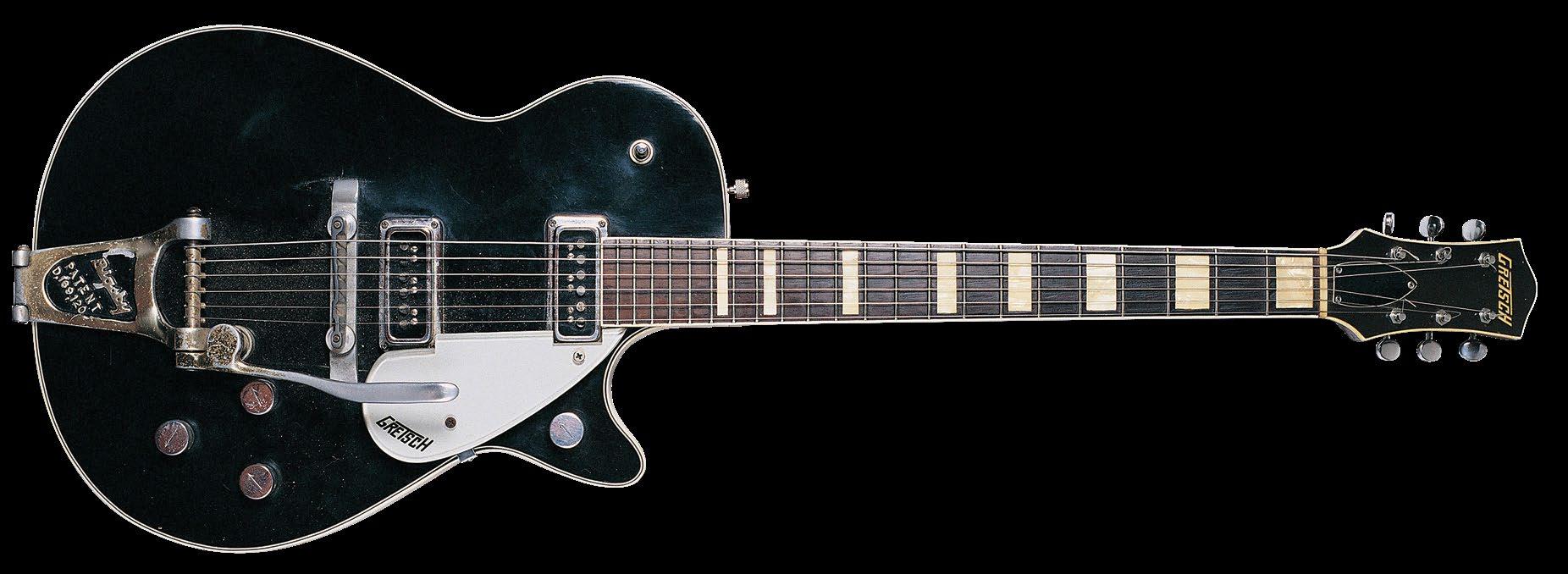
While the sound of this Duo Jet was close to Gallup’s, shortly after completing the album in 1992 Jeff found another ’56 Duo Jet (pictured above) with the missing link —
a factory-installed fixed-arm Bigsby identical to the one on Gallup’s guitar. “It’s got a depth, clarity and quality that the other one doesn’t have,” he said. “It’s incredible. Everything is as close to Cliff’s guitar as one can see. I wish I could have used it on the record.” Jeff played this Duo Jet frequently on stage, and it plays a starring role in the Rock ’n’ Roll Party (Honoring Les Paul) video release of his tribute concert for Les.
ANOTHER GRETSCH GUITAR played an important role in Gene Vincent’s music, although its powerful effect was more visual than aural. A photo taken at Hollywood’s Capitol Studios in 1957 shows Vincent strumming a Gretsch 6022 Rancher flattop acoustic, his legs spread in a classic rock ’n’ roll pose with the Blue Caps huddled in a triangular formation behind him. Blue Caps rhythm guitarist Paul Peek also aggressively strummed a Gretsch Rancher when performing with Vincent in the film The Girl Can’t Help It, which introduced many young impressionable minds to the irresistible energy of rock ’n’ roll.
Jeff’s Rancher is a more recent model made in Japan sometime between the early Nineties and 2003 when Fender bought Gretsch. With its traditional saddle and pin bridge, it sounds better than original Fifties Gretsch Ranchers, which have an unortho-
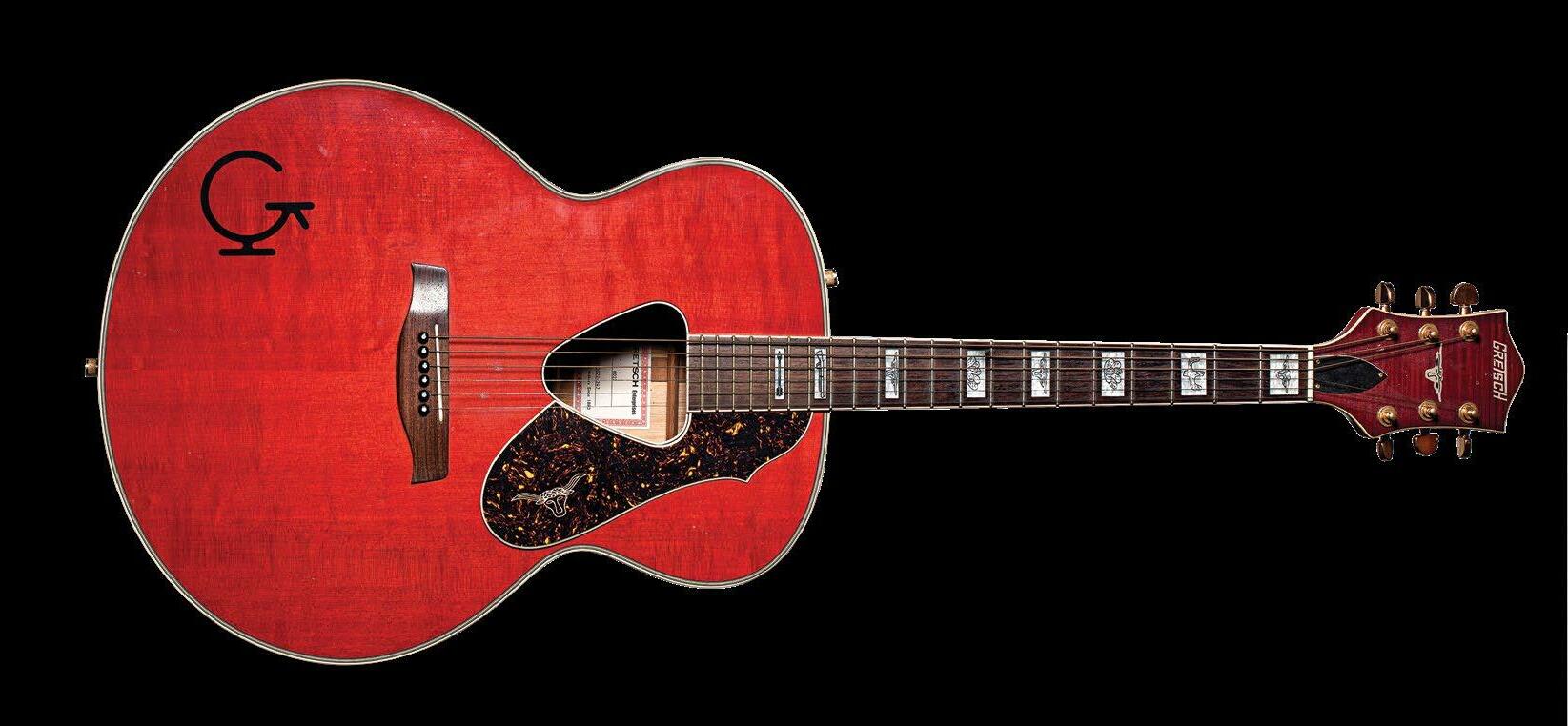

5. Beck’s ’56 Gretsch Duo Jet with fixed-arm Bigsby
6. Beck’s MIJ Gretsch 6022 Rancher
7. Fender Custom Shop master builder Todd Krause built this Strat for Beck in 2003. According to Krause, it is one of two guitars he made that were custom painted by Roy Brizio, the street rod designer and builder who made several cars for Beck
dox triangular “harp” bridge. This example also has a Western-inspired “G” brand and engraved block inlays similar to the original 1954-56 Ranchers.
FENDER CUSTOM SHOP master builder Todd Krause built this Stratocaster for Jeff in 2003. According to Krause, it is one of two guitars he made that were custom painted by Roy Brizio, the acclaimed street rod designer and builder who made several cars for Jeff. The metallic bronze finish with distinctive black and white pinstriping details matches the paint job of a street rod that Brizio was building for Jeff at the time. Krause says that other than the finish, the guitar is a standard Jeff Beck Custom Shop Signature Stratocaster with hot noiseless pickups, a Wilkinson roller nut, Sperzel locking tuners and a contoured neck heel.
Fender officially introduced its custom color option in 1957. The concept was born shortly before then when Leo Fender’s associate George Fullerton visited an automotive paint shop and purchased some Fiesta Red DuPont Duco paint to finish a guitar. Fender’s original DuPont Duco custom color guitars match the colors of various Cadillacs, Corvettes and other Chevrolet models built during this era. This Stratocaster with its Roy Brizio street rod-style

paint job is a natural evolution of Fender’s custom color concept and a fitting crowning touch for a custom-made guitar.
IN 2006, THE Fender Custom Shop produced 150 exact replicas of the 1954 Fender Esquire that Beck played with the Yardbirds. Pickup manufacturer Seymour Duncan, who acquired the Esquire from Beck in the Seventies and kept it in its original, untouched condition, loaned the guitar to Fender so they could examine, measure and duplicate every exact detail. Fender master builder Chris Fleming painstakingly replicated the V-shaped profile of the neck, the contours that John Walker carved in the body and every scrape, scratch and ding on the body, neck and pickguard. Fender veteran Abby Ybarra, who worked for the company since 1956, even wound the pickup for each replica guitar by hand.
GUILD’S HOLLOWBODY ELECTRIC models were never quite as popular as those made by Gibson and Gretsch, even though the quality was generally comparable. The “Stuart” X-500 was Guild’s flagship archtop electric model upon its introduction in 1953, and thanks to its popularity it remained in continuous production up until 1993.
Although Beck never played this Guild on stage or in the studio, it was one of his favorite guitars as it reminded him of the hollowbody archtops played by rockabilly guitarists like Scotty Moore that he admired as a young child. Jeff’s Guild X-500 B (with “B” designating the blonde finish) dates from between 1965 through 1971. Distinguishing characteristics for this brief period include the center-raised headstock shape, large triangular abalone fretboard inlay inserts, Grover Rotomatic tuners, four controls and a Guild-branded Bigsby vibrato. However, just like many street rod enthusiasts will put a Ford motor in a Chevy body, this X-500 had its original humbucking pickups swapped out for Gibson-style Seymour Duncan Antiquity P90 Dog Ear pickups, and a Gibson Tuneomatic replaced the original rosewood bridge. The gold Guild knobs date from the Fifties. The custom pinstriping on the gorgeously figured curly maple back adds an appropriate

8. In 2006, the Fender Custom Shop produced 150 exact replicas of the 1954 Fender Esquire Beck played with the Yardbirds

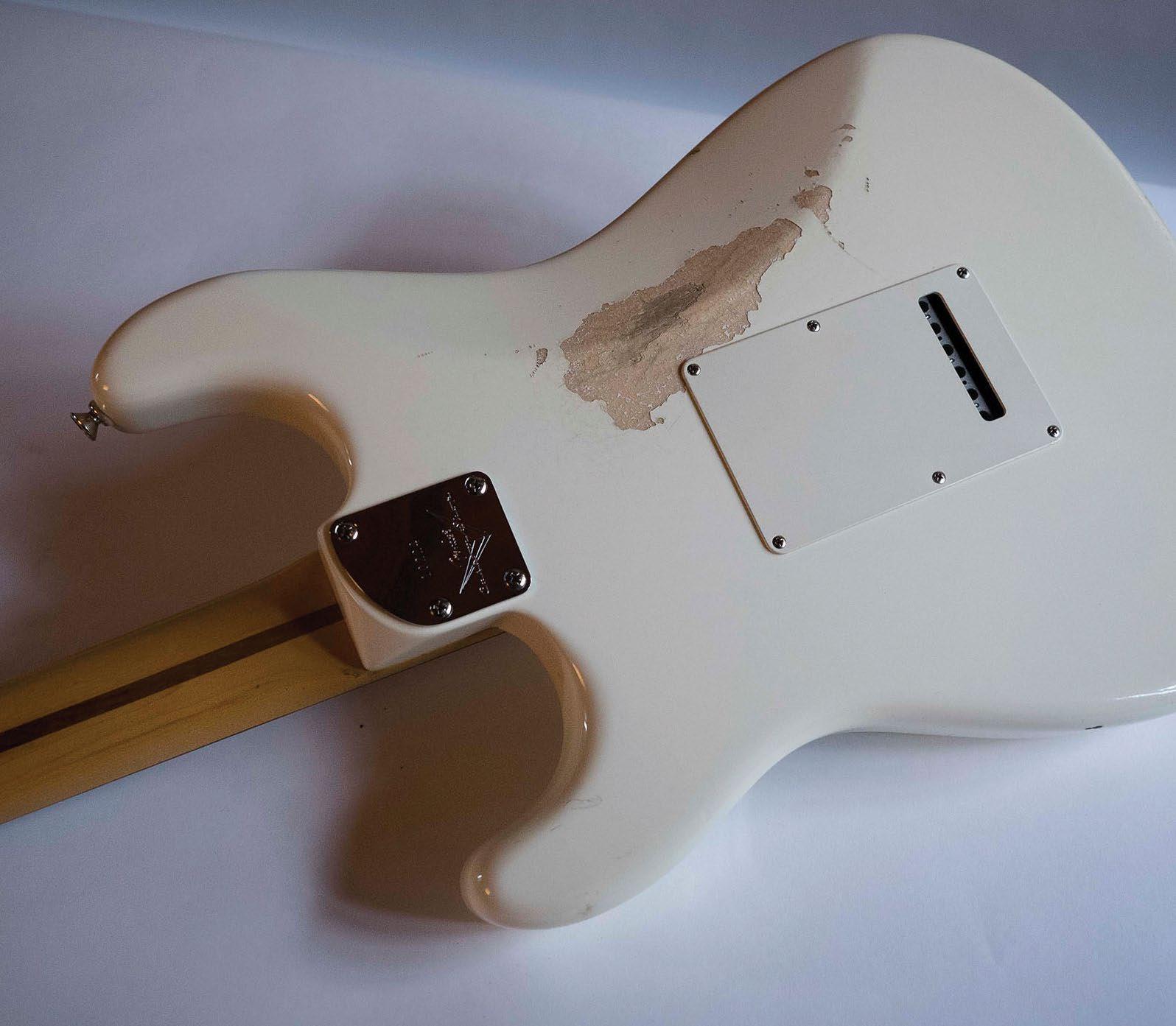
9. Although Beck never played this vintage Guild Stuart X-500 B on stage or in the studio, it was one of his favorite guitars
decorative touch for a hot-rodded guitar like this.
THE FENDER JEFF Beck Signature Stratocaster has remained a perennial best seller since its introduction in 1990, but it has undergone only two changes over the years — an upgraded version introduced in 2001 and a Custom Shop model officially introduced in 2004. However, Jeff’s main Stratocasters have changed frequently over that same time period. The guitar shown here was Jeff’s main Stratocaster from the mid2010s through his final shows with Johnny Depp in late 2022.

The most notable feature of this guitar is a neck built for a left-handed Strat, which places the arrangement of the tuners in reverse order. This also reverses the tension of the strings, making the high E and B strings much easier to bend and the low E and A strings more percussive and brilliant. Some consider this an essential element of Jimi Hendrix’s distinctive Strat tones, as Hendrix played left-handed and strung a right-handed Strat in reverse order and flipped the guitar over.
Jeff’s personal custom Strats also feature Wilkinson roller nuts, whereas current Fender Jeff Beck Signature models are equipped with LSR roller nuts.
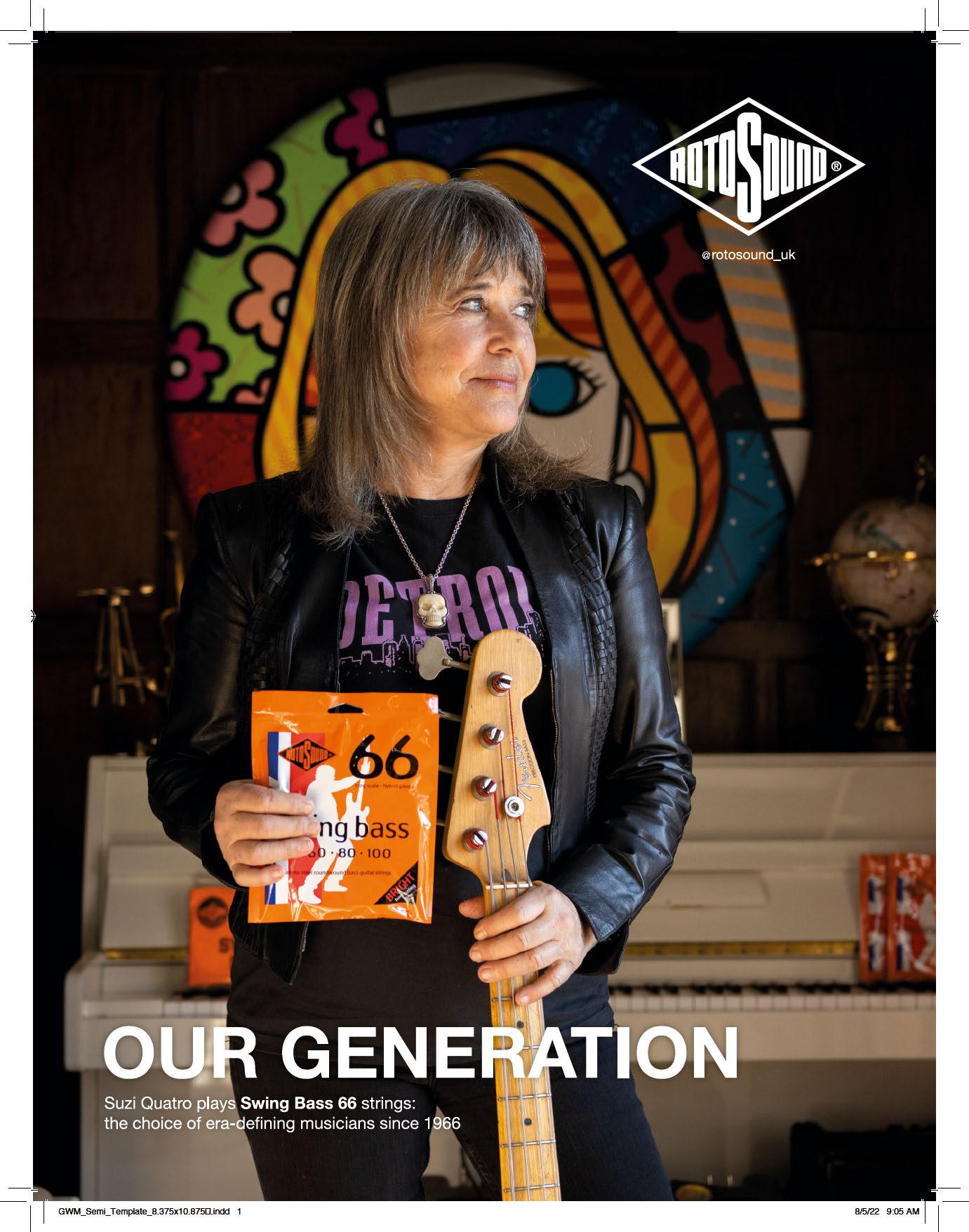
JEFF BECK NEVER DELIVERED A DULL, UNINSPIRED performance (although he personally often argued that “Hi Ho Silver Lining” belonged in the dustbin). As a result, when asked for Jeff Beck music recommendations, many of his fans are inclined to answer, “All of it!” Although Beck had few bona fide hits during his career, much of his work with the Yardbirds and his Truth, Blow by Blow and Guitar Shop albums are well known and beloved by most guitarists. However, the true Jeff Beck fan knows that he delivered many gems throughout his career well beyond his best-known work.
With that in mind, here is a list of 10 deep cuts that are worthy of a closer listen, especially from a guitarist’s perspective. These are recordings that display his influence and inimitable imagination as well as the surprising breadth of his talent through-
out his career. Beck delivered so many dazzling performances over the years that it’s nearly impossible to come up with a definitive top 10 list of anything he’s done, but we think this offers a good overview of memorable moments worth revisiting.
 Jeff Beck with a Fender Telecaster, August 9, 1985
Jeff Beck with a Fender Telecaster, August 9, 1985
THE YARDBIRDS
B-side of U.K. “Happenings Ten Years
Time Ago” single, 1966
This song’s I-IV-V chord progression may be rock ’n’ roll, but the aggressive swagger and attitude of Beck’s guitar is pure punk and manic metal before either genre ever existed. With a stop-start riff inspired by Eddie Cochran’s “Somethin’ Else,” Beck hot rods that rockabilly classic by blasting out a snarling staccato downstroke rhythm (backed by Jimmy Page on bass) that became the blueprint for bands from Black Sabbath through the Sex Pistols and the Ramones to Metallica. Beck’s singing and stinging counterpoint solo fills add irresistible British blues bombast that Rick Nielsen later tipped his baseball cap to on the solo section of Cheap Trick’s “My Baby Loves to Rock.”
THE JEFF BECK GROUP


Rough and Ready, 1971
The first incarnation of the Jeff Beck Group featuring Rod Stewart, Ron Wood, et al gets all the love and attention (it is pretty damn impressive), but the Mark II version with Cozy Powell on drums, Clive Chapman on bass, Max Middleton on keys and vocalist Bobby Tench deserves a closer look from the uninitiated. “Got the Feeling” is the first song on the first album by this version of the Jeff Beck Group, and it knocks listeners for a loop with its stanky, low-down funk groove and Beck’s driving chukka-chukka wah-wah work, amazingly recorded before “Theme from Shaft” was released. His killer slide solo during the last minute and a half is groovy, jazzy and gritty — 100 percent pure unadulterated Jeff Beck.
BECK, BOGERT & APPICE
Beck, Bogert & Appice, 1973
Beck, Bogert & Appice are best known for the band’s blues, bombast and boogie, but on “I’m So Proud” they took an uncharacter-
istic breather with a smooth, soulful cover of a Curtis Mayfield slow jam. Beck plays yet another stunning slide solo, spiced up with some interplay with a tape echo. His uncanny voice-like phrasing provides a hint of his later work on songs like “Where Were You.”
Wired, 1976
Beck says that some of his best work came about when he had a great keyboard player to bounce ideas off of. Wired was the first album where he collaborated with Jan Hammer to great effect, particularly on “Blue Wind.” Hammer’s synth solos were very guitar-like, and the dueling interplay between him and Beck pushed the guitarist to deliver soaring, aggressive solos. Beck’s tone is particularly notable, with a hornlike quality that he would continue to refine throughout his career.
There and Back, 1980
There and Back is often overlooked, but it’s an essential element of Beck’s trilogy of Seventies jazz-fusion albums, along with Blow by Blow and Wired. Like “Blue Wind,” “Star Cycle” is another killer Jan Hammer composition, but the percolating intro and main riff give the song a proto-techno flavor that planted the seeds for Beck’s deep dive into electronica two decades later. Beck plays his first solo starting around the 1:30 mark with a ripsaw distorted tone that was heavier
than most metal players at the time, and his manic shredding during the song’s last 30 seconds is jaw-droppingly dazzling.
Jeff Beck’s Guitar Shop, 1989
For all of the high-tech gloss that characterized much of Guitar Shop, Beck’s approach was generally simple and straightforward, employing a primitive rig of a pair of Fender amps and a handful of pedals that contrasted the refrigerator-size racks that ruled the day in the late Eighties. On the main melody line of “Savoy,” what sounds like a harmonizer or multi-tracked parts is just Jeff playing triple-stop bends way up the neck. I once watched him play this on his unplugged 1956 Gretsch Duo Jet with .013 flatwound strings, and it sounded exactly like the record. With its horn-like solos and swinging rhythm, “Savoy” is the closest thing to a modern sci-fi rockabilly song that Jeff ever recorded.
JEFF BECK & JED LEIBER
Frankie’s House, 1992
This soundtrack album that Beck and Jed Leiber (son of songwriter Jerry Leiber of Leiber & Stoller fame) recorded for a British-Australian television drama features a ton of killer playing by Jeff, including “The Jungle,” “Sniper Patrol” and “Cathouse.” The track “Vihn’s Funeral” is the most quiet and contemplative composition on the album. Beck plays a few sparse, undistorted notes with harmonics and whammy bar bends, and the stripped-down, naked instrumentation really allows listeners to experience how much emotion he can express with only his fingers and a guitar.
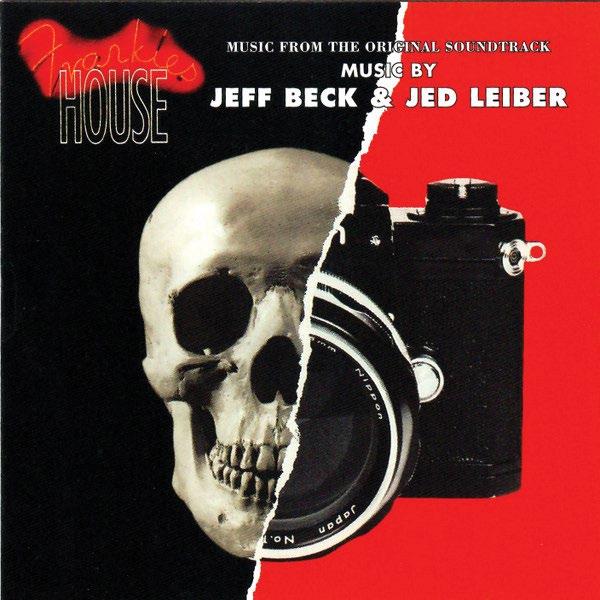
Who Else! 1999
This live performance recording is a dazzling contrast to the electronica-influenced flash and fury on the remainder of Who Else! Yes, it’s the blues, but played in a way that only Jeff Beck could, and it’s also argu-
WITH ITS HORN-LIKE SOLOS AND SWINGING RHYTHM, “SAVOY” IS THE CLOSEST THING TO A MODERN SCI-FI ROCKABILLY SONG
JEFF BECK EVER RECORDEDKEYSTONE FEATURES/HULTON ARCHIVE/GETTY IMAGES
JEFF
FROM
STEVIE WONDER
“Lookin’ for Another Pure Love”
Talking Book (1972)
Stevie Wonder’s sultry groove is the stuff of legend, but it comes as no surprise that Beck managed to go toe-to-toe with the soul man with a demonstration of his own formidable musicality on this cut from Talking Book. Not only does he raise Wonder’s keyboard musings with some silky noodles of his own; he also manages to steal the show with a crystalclean solo halfway through proceedings — an unfiltered lens into his brilliance.
JON BON JOVI
“Blaze of Glory”
Blaze of Glory (1990)
We could take or leave the title track’s hokey cowboy references, but Beck’s peach of a slide solo was essential, taking an already epic song and turning it into something that was defi-
antly his — in just 30 seconds. Punch it into Google and you can find an isolated version: just the guitar solo, in all its “glory.”
THE PRETENDERS
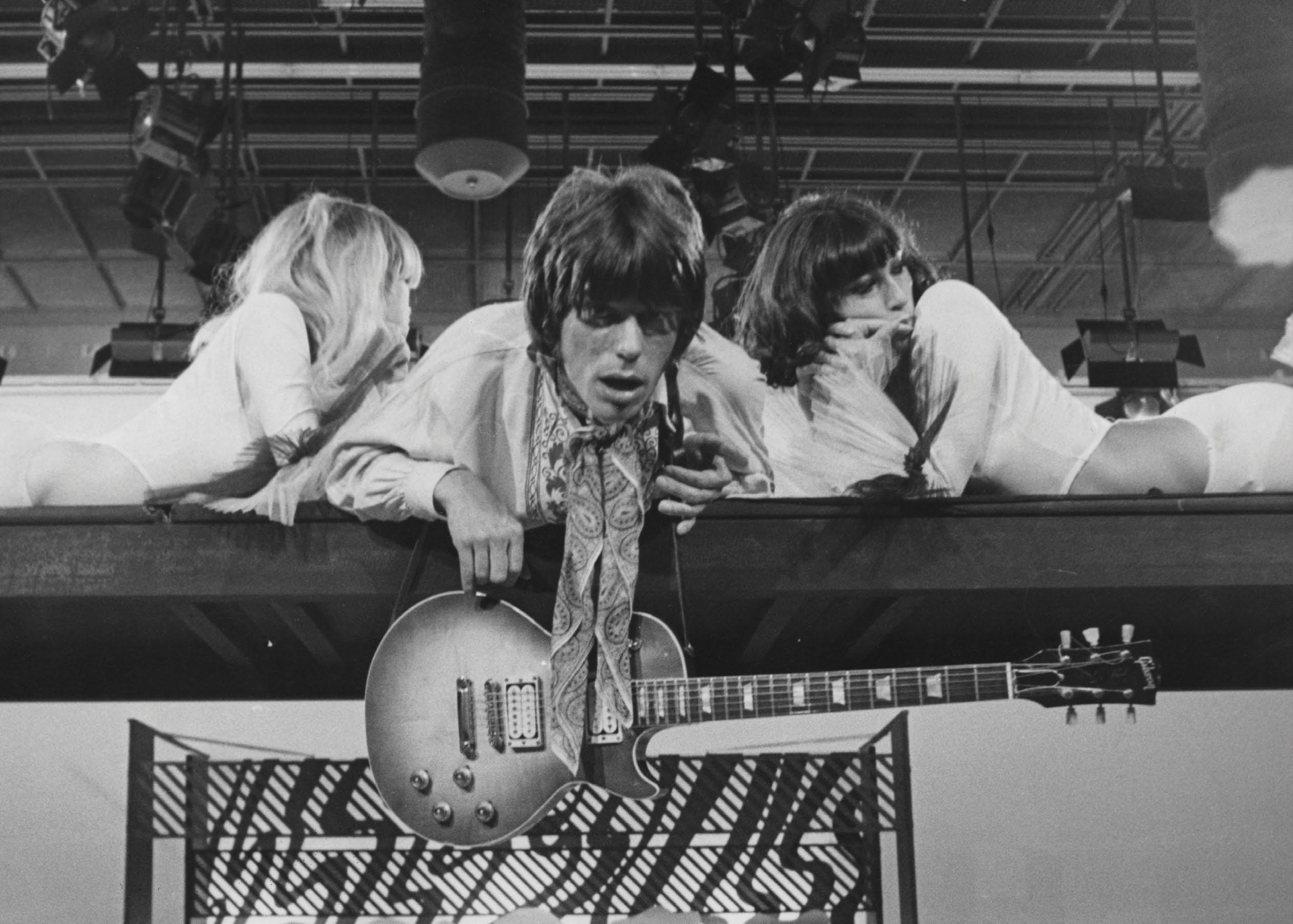
“Legalize Me”
Viva El Amor (1999)
At first, one wonders if Beck is even playing on this song — until just around the 2:14 mark, when he boldly announces his presence with one of his freakish trademark whammy-bar moves... and it just gets better from there.
TOOTS & THE MAYTALS
“54-46 Was My Number”
True Love (2004)
This Toots album is packed with guest appearances by big-name guitarists, including Eric Clapton, Trey Anastasio, Bonnie Raitt and Keith Richards. But, as always, Beck stood out in a crowd, delivering a cool, weirdo solo
BECK ’S 12
STUDIO sessions with Stevie Wonder all the way to a surprising reggae runout with Toots & The Maytals, here are some of Jeff Beck’s greatest collaborative creditsJeff Beck — with a Gibson Les Paul and a couple of dancers — on the set of a U.K. TV show in October 1967, sometime between “Hi Ho Silver Lining” and “The Dog Presides”
ably Beck’s best blues performance ever. There’s nothing remotely traditional about the licks and lines that he delivers with aplomb, but even the most staunch blues purist would be impressed by his emotion and commotion — his own apt description for his playing that he later used as an album title.
You Had It Coming, 2001
“Nadia” is part of a unique class of instrumentals that can only be defined as “Jeff Beck music” along with “Where Were You,” “Declan,” “Nessun Dorma” and “Bulgaria.” Each of those songs has a distinct ethnic flavor — Bulgarian vocal music, Irish folk music, Italian opera, etc. — but on “Nadia” he mastered the heart and soul of Indian vocal music, particularly the characteristic nuanced and complex phrasing and flourishes. “Nadia” is one of many instances where Beck’s playing transcended conventional guitar techniques. He was much more than a guitarist — rather he was a consummate musical visionary and genius for whom the guitar was simply his means of expression.
Emotion & Commotion, 2010
Beck’s characteristic guitar tone was full and robust, with a throaty, hornlike midrange that he generated with the help of a good amount of overdrive. However, on the last two minutes of “Lilac Wine” he shifts to tone that is unusually crisp, clean and understated. It’s simply beautiful. Jeff had been in the public limelight for 45 years by this point, but whereas most guitarists lucky enough to be around that long usually fall back on comfortable licks and old tricks, he still managed to grow and explore and master new territory until the end.
that almost makes it sound as if his part were tracked backwards (It wasn’t). It was also a nice change of pace to hear Beck in a reggae setting.
PAUL RODGERS
“I Just Want to Make Love to You”
Muddy Water Blues: A Tribute to Muddy Waters (1993)
Beck’s evil tone on the intro riff alone is enough to earn a spot on this list. He appeared on three songs on this Muddy Waters tribute album by the beloved Bad Company and Free frontman.
PAUL JONES
“The Dog Presides”
Insane Times (1968)
Here’s the early Jeff Beck Group-era Beck sounding very much like his former Yardbird self on this song’s opening riff, fills and solo. The recording even features another former Yardbird, Paul Samwell-Smith, on bass, not to mention the Beatles’ Paul McCartney on drums.

NARADA MICHAEL WALDEN
“Saint and the Rascal”
Garden of Love Light (1976)
This catchy, funky, hooky instrumental can almost be considered an outtake from Wired, Beck’s 1976 album. After all, Narada Michael Walden played drums on Wired and wrote four of its songs, including “Play with Me.” Beck returned the favor in marvelous fashion by recording with Walden.
JIMMY COPLEY
“Everyday I Have the Blues”
Slap My Hand (2008)
For fans who were a bit turned off by the heavy-handed production on Beck’s 1986 album, Flash, it’s a treat to hear him play with such a small, stripped-down band here; in fact, all you really hear are the drums (the late Copley was a U.K. session drummer with impressive credentials) and Beck’s chunky-sounding Strat. And that’s fine, because you get to hear him turn a simple three-chord blues shuffle into a showcase for his whammy-bar hijinks and bizarro-world bits and pieces.
ROD STEWART
“Infatuation”
Camouflage (1984)
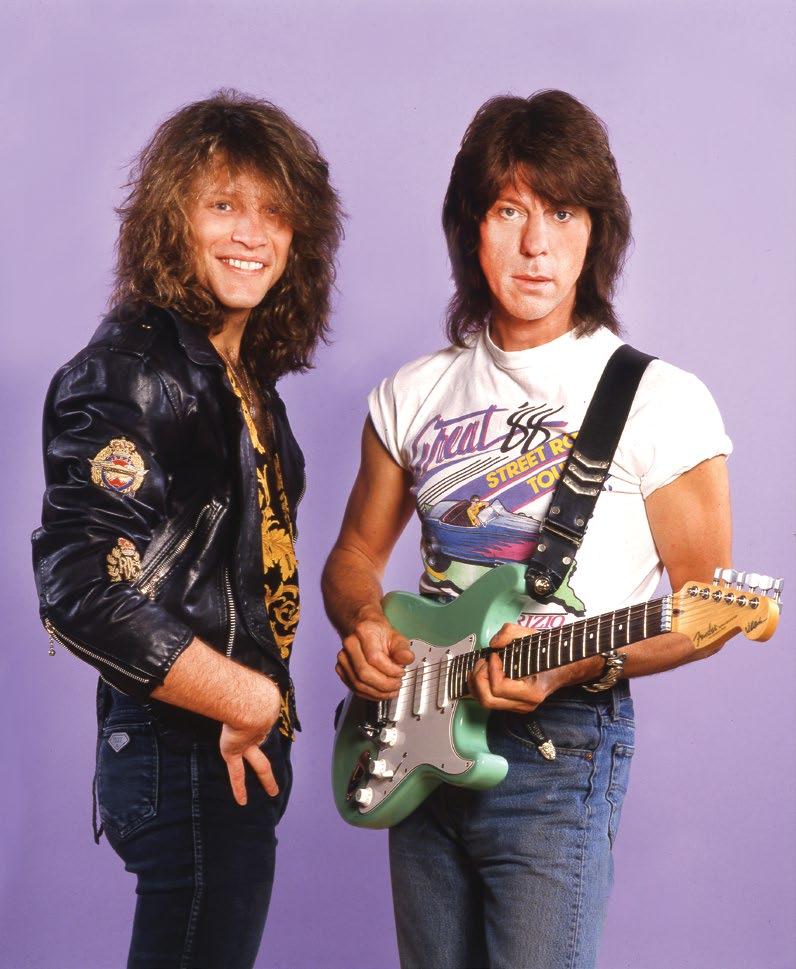
Listen to how Beck contributed something special and unique to what could’ve been just another catchy mid-Eighties pop hit. Beck also appeared in the music video — as does actor Mike Mazurki, who can be spotted in the films Some Like It Hot (1959) and It’s a Mad, Mad, Mad, Mad World (1963).
JOHN MCLAUGHLIN
“Django”
The Promise (1995)
This one gives you lots of bang for your buck: you get Jeff Beck trading off with John McLaughlin on a seven-plus-minute rendition of John Lewis’ Django, a musical elegy for Django Reinhardt. Beck starts things off with the basic melody, and things pretty much get more and more interesting as the song moves forward.
STANLEY CLARKE
“Hello Jeff”
Journey to Love (1975)
When the star of the show — in this case, bassist Stanley Clarke — incorporates his session guitarist’s name into the title of the track he played on, you can expect some memorable fretwork. Such is the case on this mid-Seventies instrumental gem, which features impressive playing by everyone involved, including the brilliant Clarke.
“What God Wants, Pt. III”
Amused to Death (1992)
Roger Waters is singing about vultures, bullets and soldiers, when, all of a sudden, a Strat bursts into the mix just before the two-minute mark, playing a powerful, emotional solo. Is it an outtake from Pink Floyd’s The Wall? Nope; it’s one of a handful of Beck-enriched songs from Waters’ Amused to Death. Check out Beck’s solo — how he uses every inch of real estate Waters gives him. If nothing else, the song answers the rarely asked question, “What would Pink Floyd have sounded like if Jeff Beck were in the band?”
“I still don’t know how he does it,” Waters once said of Beck. “He’s incredibly technically gifted in ways the rest of us can’t even begin to think about. He also has incredible pitch. When you play a harmonic and then play a melody on the whammy bar, it’s quite extraordinary to listen to.”
— Damian Fanelli

Four guitar tricks you can learn from Jeff Beck’s blossoming late-Sixties-era style
BY RICHARD BARRETTWORLD
THE BULK OF JEFF BECK’S DEBUT ALBUM, TRUTH, WAS recorded in two sessions and a total of four days in May 1968, after the renegade guitarist resisted putting out additional solo singles in the Mickie Most-approved “Hi Ho Silver Lining” vein.


These days, most conversations about Beck begin with how the revered axman maintained consistent creativity and innovation over the decades, particularly with his inventive whammy bar usage on his Fender Stratocaster — and fair enough. This lesson, however, focuses on the late guitar legend’s cutting-edge role in the British Invasion of the Sixties, before he would later go on to help define jazz-rock in the early to mid Seventies.
Back then, Jeff played a Gibson Les Paul with a pick, and even without a whammy bar the crafty guitarist was able to manipulate the pitches of notes in an innovative way, using just his fingers, adding rhythmic, stuttering phrases that would often punctuate Rod Stewart’s raw vocals. Ronnie Wood’s complex guitar-like lines on the bass were a valuable support, too, particularly live.
Beck always followed his own musical path, taking inspiration from a wide range of styles. Cliff Gallup’s rockabilly pyrotechnics were a major early influence, and Beck would also later embrace stylistic elements from musicians — guitarists and non-guitarists alike — with influences as diverse as Stevie Wonder and Nitin Sawhney.
Second guessing what a player like Beck might’ve come up with is an unenviable task, but having a listen to his inspired and deeply inspiring playing on Truth — and taking some cues from that — guided me to craft the 16-bar tribute solo that’s presented here, which I split into four sections (FIGURES 1-4). The solo is played over a funky midtempo rock groove, and the underlying chord progression is based on a stock 12-bar blues in the key of F#, but with a twist from bar 9 onward, where it veers off from the conventional turnaround structure, with four bars added to the form. The majority of the notes played fall within the F# minor pentatonic scale’s root - b3 - 4 - 5 - b7 structure (F#, A, B, C#, E), but notice the addition of a couple of melodic-harmonic color tones in a few spots, namely the major 6th, D# (see FIGURE 2, bar 5) and the 2nd, or 9th, G# (see FIGURE 3, bars 11 and 12).
It’s likely that Beck was plugged into Marshall amps for the majority of the Truth sessions, possibly with a Marshall Supa Fuzz pedal. The main ingredient, though, is Jeff’s fingers. To get the tone on my tribute solo, I linked the channels on a small-box JTM45 combo and pretty much maxed both volumes — a bold setting not for the faint-hearted!
For video of this lesson, go to guitarworld.com/april2023
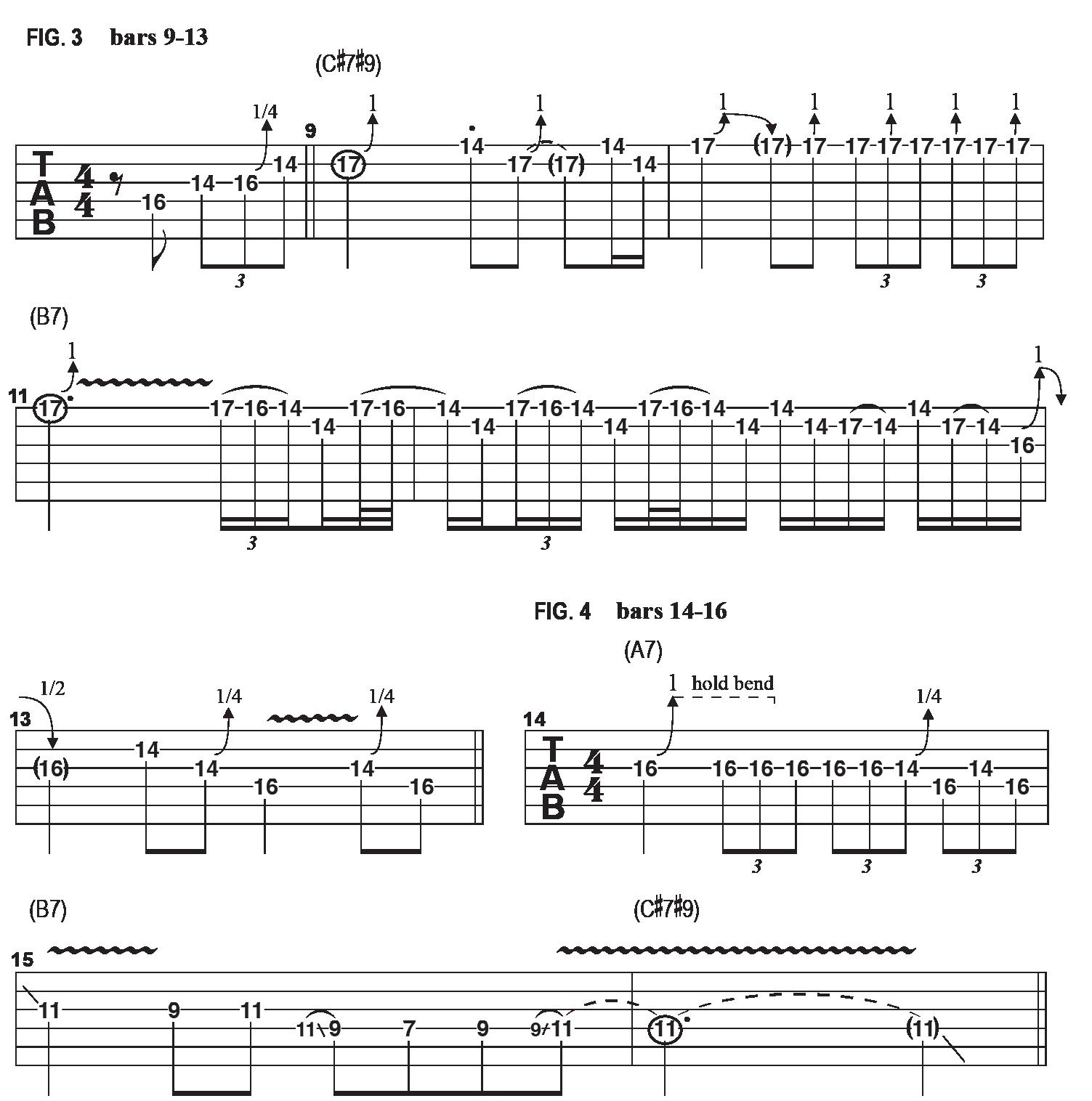
 FIGURE 1
FIGURE 2
FIGURE 3
ROBERT KNIGHT ARCHIVE/REDFERNS
FIGURE 1
FIGURE 2
FIGURE 3
ROBERT KNIGHT ARCHIVE/REDFERNS
While recognizably minor pentatonic, which is not necessarily a norm for Beck, even in the Sixties, this opening phrase demonstrates the guitarist’s creative rhythmic and articulation approach. We begin with a pickup phrase that leads into a bold one-and-one-half-step overbend, from the F# root note up to the b3, A. The notes are attacked aggressively and emphasized with an abundance of bends and pre-bends (notes bent before they’re picked). Note the playful alternation between the b7 (E) and pre-bent root (F#) in bar 3. The partial release from the 5th (C#) to the flatted 5th (C) at the beginning of bar 4 is an example of how Beck would take what might sound like standard blues (or just plain wrong) in another guitarist’s hands and create a poignant melodic twist in what was still a very new style in 1968.
Moving up the fretboard via a series of legato finger slides, these ascending minor 3rd intervals on the G and B strings add melodic color to the proceedings, with the D# note in bar 5 effectively acknowledging the major 3rd of the underlying implied IV (four) chord, B7 (B, D#, F#, A). This climbing lick leads up to another sequence of stuttering pre-bends and silent releases in bar 6, recalling those in FIGURE 1, but now with higher notes, with the 4th (B) bent up to the 5th (C#) and alternating with the b7 (E), creating another minor 3rd interval. This move recalls the psychedelic sounds that were everywhere at the time, and the way blues harp players would bend notes.
Leading into bar 9 and a prolonged stay on both the V (five) chord, C#7#9, and, in turn, the IV chord, B7 — two bars on each chord, instead of one — we have a longer phrase here that incorporates some of the same devices featured earlier in the solo, including more stuttering pre-bends and a particularly unsubtle partial release to the b5 coming out of bar 12 into bar 13. Additionally, bars 11 and 12 feature a series of Beckstyle rapid-fire double pull-offs with an interesting rhythmic displacement scheme applied to a repetition lick, exemplifying another one of the legendary guitarist’s signature improvisational moves. Beck never made fast playing a goal in itself, but there’s

no doubt he was able to go there if he felt the moment called for it or needed a rhythmic kick.
Closing the solo, this final phrase begins with some more playful pre-bends up in 14th position then quickly shifts down to 9th-11th position in bar 2. This is some-
thing I hadn’t consciously intended to do but in hindsight felt it was probably true to Beck’s non-linear and often quirky improvisation approach. Ending with a high screeching note also feels like something that would’ve come later (perhaps in the Seventies). I don’t believe Beck thought in linear terms — maybe not even in terms of stock licks or scales at all — which made him one of the most interesting guitarists to listen to.
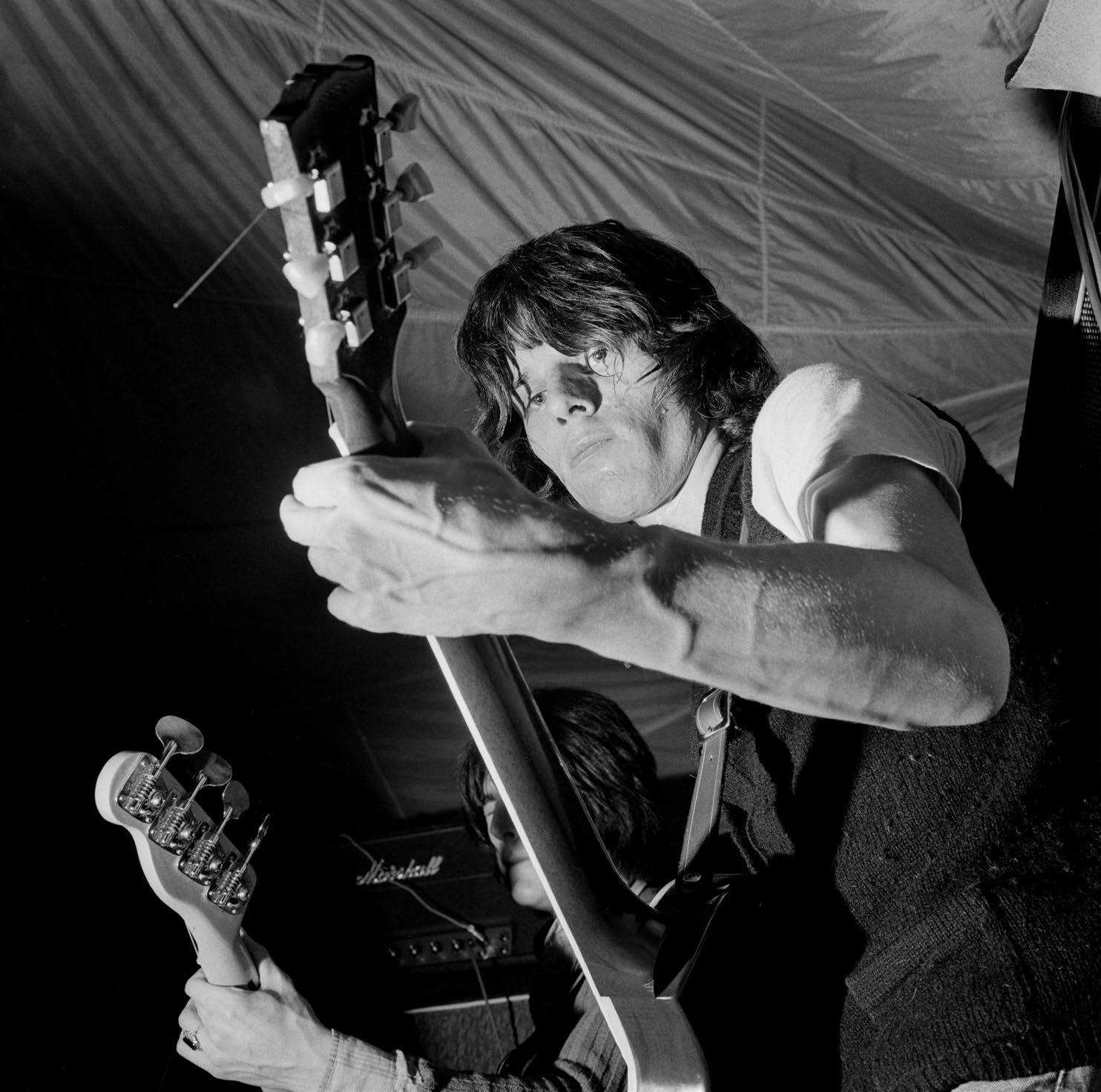
77
VICTORY AMPS
V1 SERIES
V1 Copper, V1 Duchess and V1 Sheriff
78
KERNOM Ridge Overdrive
79
EARTHQUAKER DEVICES Sunn O))) Life Pedal V3
FOR DECADES THE boutique pedal market consisted mostly of builders who refined somewhat low- to middle-tech designs and relied heavily on obscure and obsolete new old stock parts that were too rarified for mass consumption. Sophisticated, high-tech effects were the domain of bigger companies with bigger budgets and armies of engineers, which led to some stellar innovations that unfortunately often lacked the personality and quirk that comes from more individual creativity.
However, recently the boutique pedal realm has undergone a renaissance of sorts where a growing number of smaller companies are developing some truly cutting-edge stomp boxes with intensely progressive technology and features. Hologram is part of this new
breed of boutique builder, founded in 2015 by Jason Campbell and Ryan Schaefer, who have backgrounds in engineering and software design but are also musicians. The Microcosm is Hologram’s latest offering, described as a “granular effects pedal” that employs delay, looping, pitch shifting and sampling as well as reverb, modulation and filtering to generate truly fascinating tones, textures and rhythmic patterns. When Hologram says that the Microcosm generates new sounds, they are not kidding as the unit offers effects that are truly unlike anything else out there.
FEATURES Pedals that offer such an advanced level of sophistication can be intimidating, but the Microcosm features a very straightforward layout that makes it easy

to navigate presets and tweak your own sounds. A rotary Preset Selector button in the upper right corner accesses the four basic groups of effects (Micro Loop, Glitch, Granules and Multidelay) that offer a total of 11 distinct effects plus a User bank. Each of the 11 effects has four preset variations to provide a total of 44 presets plus 16 user programmable presets. Parameter adjustments are made via eight knobs at the upper left, consisting of Activity, Shape, Filter, Mix, Time, Repeats, Space and Loop Level controls. There’s a 60-second phrase looper with pre-fx, looper only, burst and quantize modes plus a reverse button that instantly plays your loops backwards. The three footswitches control tap tempo, bypass and hold/ sampler in regular effects mode and record/play/ dub, activate looper and stop/erase functions when the looper is engaged.
Rear panel jacks consist of a single mono/stereo TRS ¼-inch input, left/mono and right ¼-inch outputs, ¼-inch expression pedal input, full-size five-pin DIN MIDI In and MIDI Out/Thru and a standard 9VDC center negative power input for the provided adapter

PERFORMANCE Whereas most stomp boxes provide effects that are like frosting on a cake, the Hologram Microcosm is an entire instrument unto itself that’s more like the cake itself with decadent frosting, shiny, sparkly sprinkles and a detailed three-dimensional candy rendering of Hokusai’s Great Wave of Kanagawa on top. This is a deeply inspirational pedal that dictates
very distinct sounds, note patterns, textures and rhythms that are anything but subtle. Ambient and progressive guitarists will definitely love the incredibly complex sounds it generates, but open minded players of other genres will likely figure out creative uses for it unless they exclusively play traditional styles like blues, rockabilly and old school country.
Words cannot do justice to the complex and richly textured tones the Microcosm generates. Clean amp settings are best when you want to hear the finest nuances of its gritty Granules and skittering Glitch effects, but I also loved the wondrous clatter and noise it offers with high-gain settings both in front of an amp and inserted in an effects loop. The way some of the effects howl and smear when distorted could even work in a progressive metal context.
Generally effects that provide the Microcosm’s level of sophistication require an advanced degree to program and operate, but here operation is surprisingly straightforward and simple. With effects as unique as these, my advice is to just dig in and start tweaking knobs to see where it leads you and what inspires your creative impulses. Just take the time to familiarize yourself with the process for saving presets, which you certainly will want to do. The looper section is more powerful and sophisticated than most (the reverse function is a blast), but it too is very straightforward and intuitive to use. The 16 user preset locations can save loops as well as effect settings.
STREET PRICE:
$459
MANUFACTURER: Hologram Electronics, hologramelectronics.com
11 unique granular effects with 44 preset variations plus stereo reverb, pitch modulation and a resonant lowpass filter provide a wealth of provocative tones, textures and rhythms.
The phrase looper provides up to 60 seconds of recording time, distinctive burst and quantize functions and a reverse playback button.
The Hold sampler function freezes effects and patterns instantly by engaging the dedicated Hold footswitch.
Effect settings, loops and overdubs can be saved in 16 user preset locations.


THE BOTTOM LINE:
Truly unlike any other stomp box you’ve ever heard, the Hologram Microcosm generates a wealth of sophisticated textures, soundscapes and rhythmic patterns that are sure to inspire open-minded creative musicians.
VICTORY AMPS V1 SERIES: V1 COPPER, V1 DUCHESS AND V1 SHERIFF
By Paul RiarioIN A MARKET flooded with countless overdrives and distortions, the next logical step for designers has been to pivot toward stompboxes that mimic celebrated amplifiers. Universal Audio, Friedman, Soldano and others have successfully released amp-in-a-box pedals that sound convincingly close — if not identical — to the tube counterparts they represent. Not to be late to the party, newcomer Victory Amps has released their V1 Pedal Series — the Duchess, Copper, Sheriff, Jack and Kraken — that aim to emulate the detailed tones of their corresponding tube amplifiers. Beyond any doubt, Victory has done a bang-up job of establishing itself as a premier boutique U.K. brand with a family of tube amps painstakingly voiced from vintage to metal. For instance, I recently had the distinct pleasure of reviewing their V40 The Duchess compact head, which blew my doors off in tone for an amp of its size and power. Now, with the release of their V1 stompboxes, I was able to test drive three of them: the V1 Duchess, V1 Copper and V1 Sheriff, all of which offer a spectrum of familiar amp-like flavors guaranteed to spruce up your existing rig.
CHEAT SHEET STREET PRICE: $249 (each)
MANUFACTURER: Victory Amps, victoryamps.com
FEATURES Designed in collaboration between Victory’s chief designer, Martin Kidd and Adrian Thorpe of ThorpyFX, the V1 pedals are an uncompromised labor of love to extract the very tonal nature of Victory’s award-winning amp range in an analog stompbox emblazoned with fancy graphics. Less bulky than a brick and about the size of an iPhone Mini, the Copper, Duchess and Sheriff are delightfully compact and robust in construction with steel enclosures and premium components and jacks. Their straightforward control set includes Volume and Gain, and three-band EQ (with Tone replacing Middle for the Copper). All the pedals feature a single footswitch, a standard 9VDC center negative power input, and a blue amp jewel status indicator
PERFORMANCE With the exception of the Duchess, I have yet to try the original tube amp versions of the Copper and Sheriff, but judging from the Duchess pedal, Victory seems to have capably distilled the organic tones from its amplifiers. It’s no mystery that these three V1 pedals draw their tonal inspiration from time-honored amps with the Copper and Sheriff illustrating classic British chime and aggressive British bark
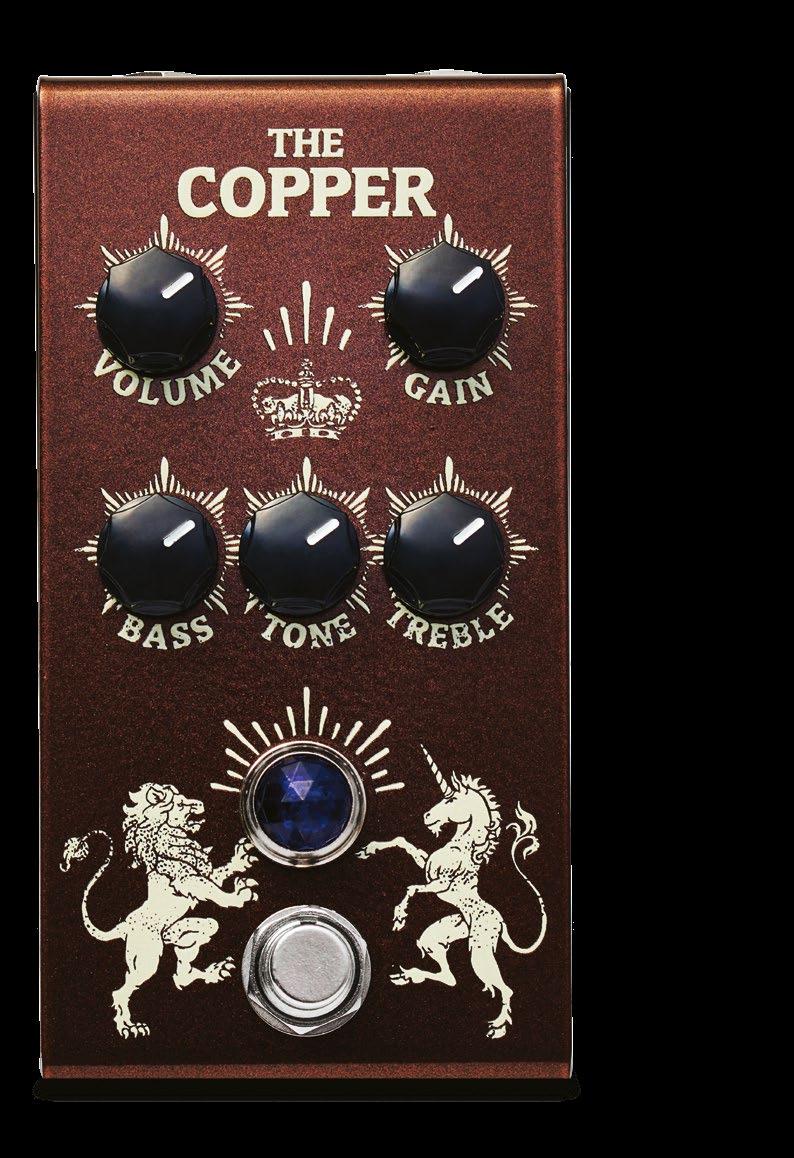
The V1 Sheriff is the gain authority with varying degrees of classic rock overdrive to hot-rodded saturation.
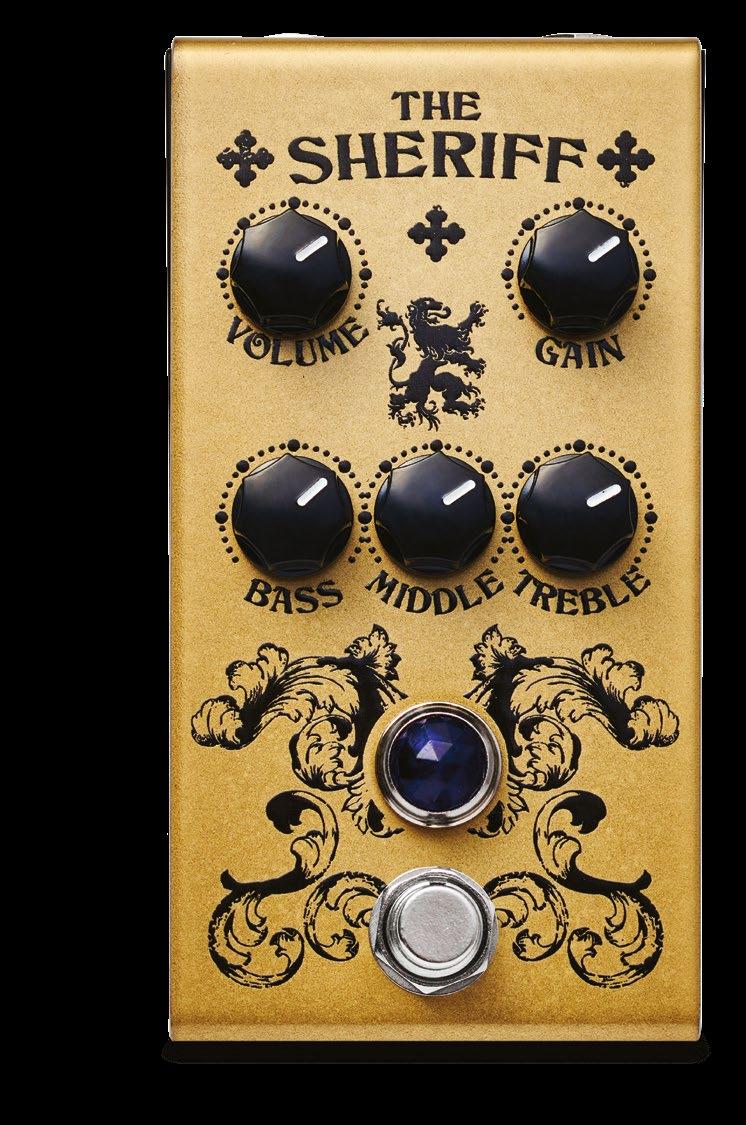
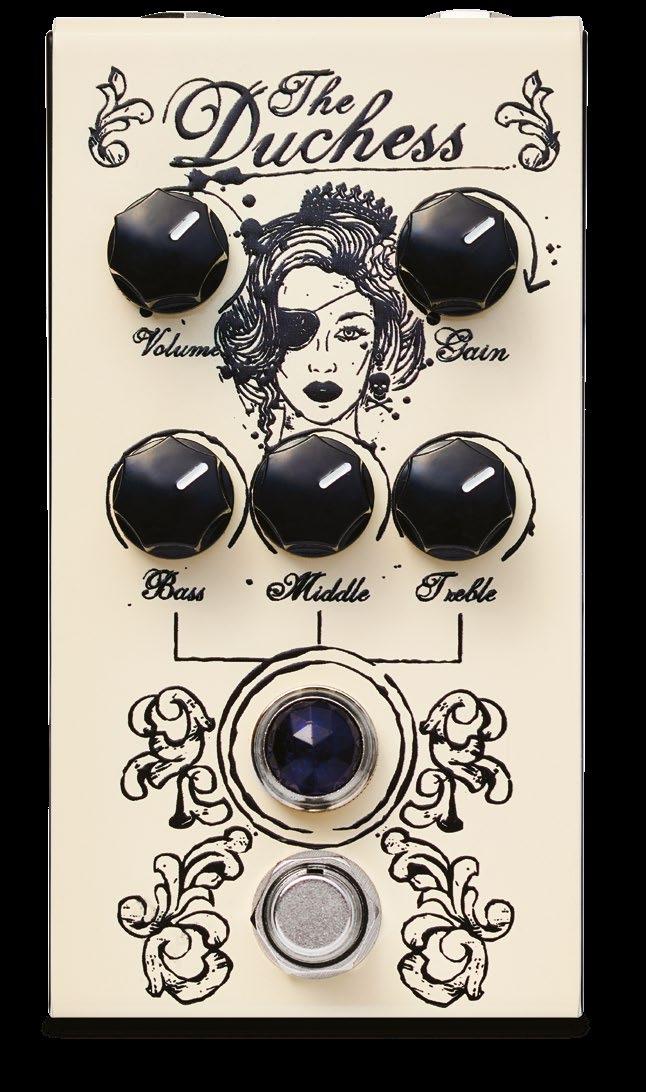
respectively, and the Duchess reflecting Sixties-era American cleans and grit. The Sheriff is the most overdriven of the three with pointed saturation and increased compression as you dial up more gain. But for blossoming dynamics and a strapping gain boost that adds overall body, the Copper makes a strong case as a panacea for any anemic guitar signal. And for an entirely different kind of edgy clean or midgrind drive, the Duchess delivers a pleasingly responsive attack and boosted volume. The V1s can be dialed in for clear shades of brighter or darker tones thanks to their precise EQs, and conspicuously, I found all three pedals respond with an enhanced amp-like character when their gain controls are moderately set back. Admittedly, I had a difficult time settling between the Duchess or the Copper as a “base tone” favorite for their wonderful touch-sensitivity that enriches your overall guitar sound, and not to be overlooked, I did enjoy the Sheriff as a secondary gain stage behind the other two. That said, if you can swing their premium cost, I’d pair any two of these pedals together for stacked gain options and for the title of having the “best guitar sound” in any band.
For EL84 sparkle, the Copper delivers chime and boost, while the V1 Duchess brings sweet California cleans and tube-like grind.
THE BOTTOM LINE
The V1 Copper, V1 Duchess and V1 Sheriff pedals provide distinct and satisfyingly complex amp-in-a-box flavors from Victory’s renowned tube amps of the same name.
MANY GUITARISTS HAVE spent years and not-so-small fortunes seeking the ultimate overdrive pedal. It usually starts off with the acquisition of a few decent inexpensive mass-produced stomp boxes before descending into the madness of custom mods, elusive and expensive vintage units, pricey boutique boxes with months- and years-long waiting lists and a never-ending chase of the newest sensation. The Kernom Ridge Overdrive may fall into that last category, but it offers the serious promise of possibly being the last overdrive pedal a guitarist may ever need thanks to its incredible flexibility and ability to dial in the distinct character of a multitude of the most coveted and beloved overdrive boxes. Much more than an overdrive chameleon, the Kernom Ridge even offers the potential to create your own ultimate overdrive that’s unlike any pedal currently available.
FEATURES The Kernom Ridge Overdrive is about the size of two regular “compact” pedals placed side-by-side. In addition to the true bypass on/off footswitch, a Preset footswitch enables the box to operate like two separate overdrives, switching between a saved preset and the pedal’s “live” control

configuration. Six knobs on the top panel consist of the standard Volume and Drive controls along with more distinctive and flexible Pre Tone, Post Tone and Mid EQ controls and the Mood control that is the heart and soul of the pedal’s tone and texture shaping capabilities. The character of the Pre Tone, Post Tone and Mid settings shift along with the Mood setting offering a stunningly diverse pallet of overdrives.
The Mood control accesses the pedal’s Analog Morphing Core engine, which provides overdrive flavors ranging from high-headroom transparent soft clipping to compressed hard clipping along with variations like asymmetrical (a la the Boss SD-1) and symmetrical clipping (Tube Screamerstyle and more). Other features included mono ¼-inch audio input and output jacks, a ¼-inch jack for an expression pedal that morphs between preset and control knob settings or between any two specified custom settings, MIDI In and Out mini jacks for type A TRS MIDI cables, and a barrel jack for a 9-volt center negative power supply (adapter not included)

PERFORMANCE While it was a lot of fun to adjust the Kernom Ridge’s controls to duplicate the sounds of various overdrive pedals I already own with uncanny accuracy,
I quickly found it more satisfying to come up with tones and textures just using my ears instead of other sonic references. The Pre Tone and Post Tone knobs sweep through a useful range of frequency signatures that seem subtle but capably provide attractive qualities like enhancing presence and cut, adding body, and tightening or loosening attack. The Mid control is somewhat more conventional, and based on where the Mood knob is set it can provide everything from vocal- and wah-like honk and scooped tones that still retain crucial mid-definition to the elusive sweet spot upper mids of a Klon and Tube Screamer.
The Mood control is where the magic happens, and one can get lost for hours exploring the subtle and not-so-subtle shifts in overdrive character it summons. Because the Mid, Pre Tone and Post Tone controls shift as well when changing Mood knob settings, it can be a challenge to dial in previous favorite settings, which makes the pedal’s ability to save a preset onboard and save presets via MIDI a critical feature. I particularly liked how the Kernom Ridge encouraged me to focus on listening carefully when dialing in tones. After getting used to controls, it was easy to go from vintage Marshall crunch to dynamic, punchy “clean” boost and pretty much everywhere in between.
STREET PRICE: £299
MANUFACTURER: Kernom, Kernom.com
The unique Mood knob controls the pedal’s Analog Morphing Core engine to provide an incredible variety of classic overdrive tones and textures.
The character of the Mid, Pre Tone and Post Tone controls changes depending on where the Mood knob is set.

The Kernom Ridge’s ability to nail the tones and textures of dozens — perhaps even hundreds — of overdrive pedals is impressive, but its ability to dial in precise overdrive tones that are perfect for you possibly make it the last overdrive you’ll ever need.
FOR ASPIRING DIRT purveyors who relish in sonic mayhem, EarthQuaker Devices has been on a collaborative roll, releasing limited-edition stompboxes that straddle the line between distortion and fuzz while sprinkling in a healthy dose of aural chaos for good measure. From their joint effort with Death By Audio to unleash the Time Shadows pedal, to partnering with Boris guitarist Wata for the Hizumitas, EQD is at a creative peak in the dark arts of crushing saturated ecstasy. Their latest offering is the third iteration (V3) of their collaboration with drone metal doomsayers Sunn O))) for the EarthQuaker Devices Sunn O))) Life Pedal V3 — a triple threat of a stompbox that combines massive distortion, octave fuzz, clean boost and much more. The previous limited-run versions have all sold out, but the good news is the Life Pedal has cultivated such demand and online mythos that it will now live on as a permanent production model.
EQD has made it common knowledge that the Sunn O))) Life Pedal is inspired by the Shin-Ei FY2 Companion and FY6 Super Fuzz boxes fed into a vintage white-logo Rat distortion-style circuit, but with the added versatility of including a three-way gain clipping switch (OpAmp, Asymmetric and Symmetric). The two-stage pedal is housed in a substantial black metal textured enclosure and features an “Amplitude” portion of the pedal (designated by a Petrine Cross graphic) that incorporates distortion with a blendable octave up with two corresponding independent footswitches, and a “Magnitude” section (identified by a Christian Cross graphic) containing an all-discrete MOSFET “clean” booster with its own separate footswitch. Controls for Amplitude (output volume), Filter and Distortion will seem familiar to Rat enthusiasts, while the Octave (octave up) and Magnitude (output boost volume) are self-evident. The Life Pedal features input/ output jacks, EXP jack (for expression pedal control of the octave blend) and a standard 9VDC center negative power input. The pedal also features EQD’s Flexi-Switch technology for relay-based, true bypass switching to simultaneously use momentary and latching-style switching. Humbuckers or single coils be damned, because it doesn’t matter what you use — the Life Pedal is a thunderously loud octave fuzz pedal tailormade for avant-garde noise architects. It certainly tips its hat to the famed big-boxed Pro Co pedal, but its sludgy distortion is far tighter and more defined, even when vaulting the gain toward shaggy fuzz textures. The key is the Filter control’s range can coax foreboding darkness for doom metal or rolled back for gloriously sharp harmonic overtones that sound like the Brite channel of a cranked Sunn Model T amplifier. Introducing the Octave adds a resounding clang — if you dig that much furriness — but if you want to hear it spit out the upper octave you’ll need to play single notes above the 9th fret. Its Magnitude clean boost is tremendous for its transparency, and activating all three footswitches will nudge your amp into a “Three Mile Island” meltdown and lingering sustain. I’m sure this won’t be the last collaboration in the works coming from EarthQuaker Devices, but if this is any indication of the results, I genuinely can’t wait till the next one. —
 Paul Riario
Paul Riario
STREET PRICE: $299
MANUFACTURER: EarthQuaker Devices, earthquakerdevices.com
LAST MONTH, WE began exploring a great lead-playing technique known as the oblique bend, which pairs a bend with an unbent note on a different string, with the two notes played either together or in succession. Oftentimes, the technique is used on two adjacent unwound strings, namely the high E and B, or the B and G, typically to perform what’s called a unison bend, for which the lower note is bent up to match the pitch of the higher note. But an oblique bend may also be performed with different pitches and on non-adjacent strings, which can yield endlessly interesting results.
Previously, we looked at phrases that began with oblique bends then resolved to conventional single-note lines. I’ll now present some examples of ascending and descending licks that begin with single notes then culminate with an oblique bend.
FIGURE 1 is an ascending line that’s based on the A minor pentatonic scale (A, C, D, E, G) and played primarily in a rhythm of 16th notes. It kicks off with a series of hammer-ons across pairs of strings, starting with the A and D then moving up to the D and G then the G and B, ending with an oblique bend; this phrase is played twice. In FIGURE 2, the lick simply moves straight up the A minor pentatonic scale.
An effective way to make this type of phrase more rhythmically and melodically interesting is to incorporate 16th-note triplets into it, performed with hammer-ons and pull-offs. In FIGURE 3, a quick C-D-C hammer/pull on the A string is followed by a G-A-G hammer/pull on the D string and then another similarly executed C-D-C hammer/pull on the G string, this time an octave higher. The lick then concludes with the oblique bend and vibrato. FIGURE 4 illustrates a simpler reading of the same idea.
Now let’s examine two descending phrases that end with an oblique bend. In FIGURE 5, I begin with a slightly bent high C note (8th fret) then descend across the top three strings through the notes of the A blues scale (A, C, D, Eb, E, G). Notice the use of pull-offs throughout the lick, which give the line a smooth legato sound.
FIGURE 6 descends through A minor pentatonic in 3rds and 4ths before culminating with the same oblique bend. Notice that, at the end of bar 2, I change the bent note on the G string to C#, bent up a half step to D. This variation opens the door to investigating other ways in which to use different
For video of this lesson, go to guitarworld.com/april2023
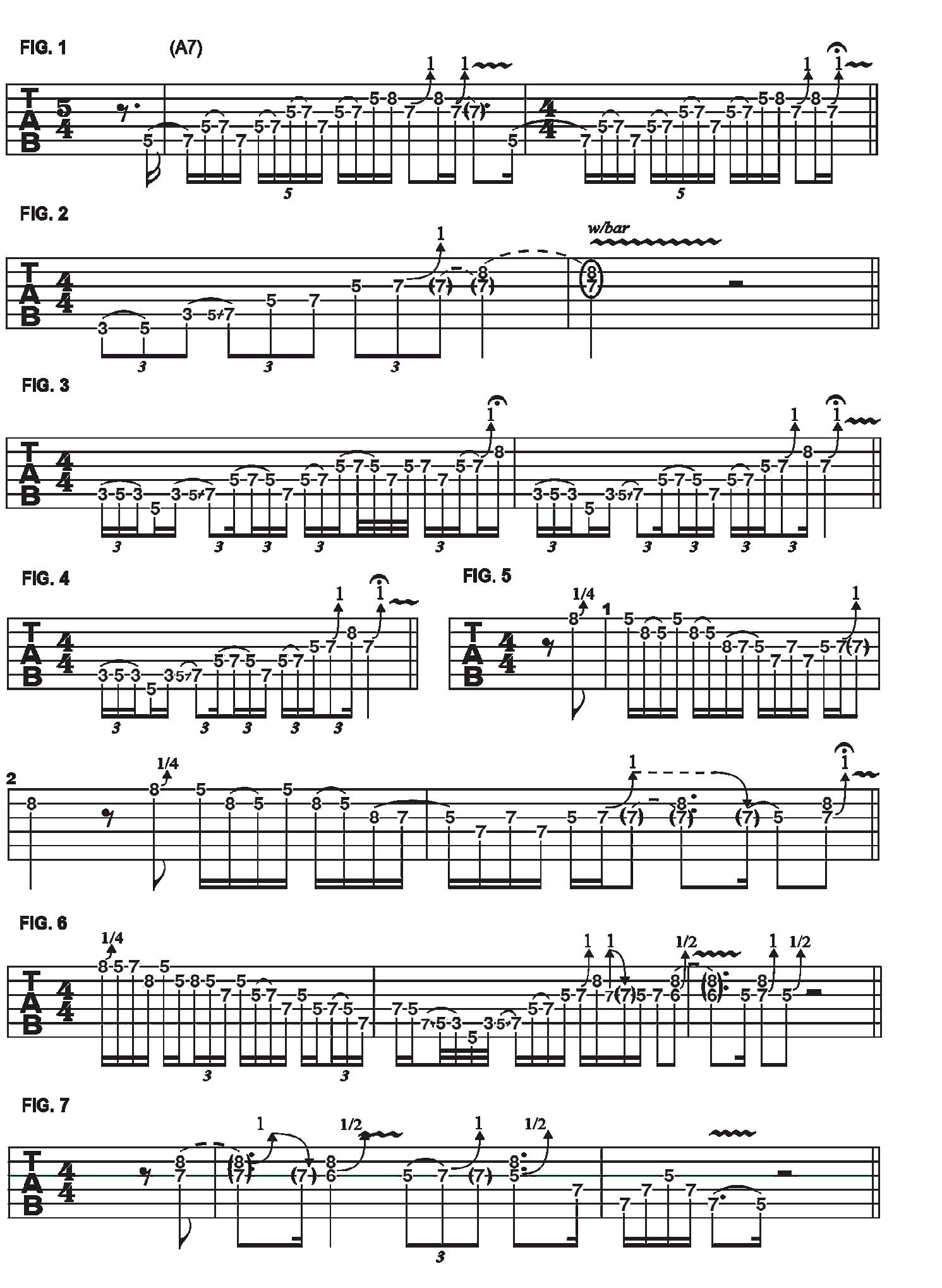
G-string bends while maintaining the same high G note on the B string. In FIGURE 7, a D-to-E bend is followed by a C#-to-D, then a half-step bend from C to C#. Jimi Hendrix often utilized this technique — pairing different bent notes on the G string with a stationary note on the B string — to great effect.
GW associate editor Andy Aledort is recognized worldwide for his vast contributions to guitar instruction. His new album, Light of Love, is available now.

OVER THE NEXT few lessons, I thought it would be cool and insightful to talk about the distinctive attributes of various classic guitars and the simple beauty of plugging each straight into a great tube amplifier, to learn what it can do for what it is. Using the same amp settings with different guitars allows you to clearly hear each instrument's signature characteristics. For this demonstration, I’ll play each guitar through a moderately cranked Fender Deluxe Reverb amp, run through a THD Hotplate power attenuator to bring the volume down to a reasonable “apartment-level” roar.
Let’s start off with a 1954 Gibson goldtop Les Paul, fitted with single-coil P90 pickups. To me, P90s produce a very distinct tone, one that I equate with early Freddie King as the “blues machine” sound. Muddy Waters played a goldtop with P90s in his early days, as did Mike Bloomfield before he graduated to a sunburst Les Paul Standard with PAF humbucker pickups, which is a distinctly different sound.
A 1954 goldtop has a mahogany back, carved maple top and small frets. With both pickups dimed — volume and tone controls set on 10 — the guitar has a very full sound with strong low end combined with all the snap you need on top. FIGURE 1 is played in a medium-slow 12 8 blues feel not unlike Freddie King’s “I Love the Woman.” The example is played in the key of D, with the majority of the phrases based on the D minor pentatonic scale (D, F, G, A, C) in 10th position, with a touch of the D blues scale (D, F, G, Ab, A, C) added here and there. In bar 4, notice the use of the reverse rake at the end of beat 1, as I drag the pick in a single upstroke across the G, D and A strings.
A great trick is to roll-off the neck pickup volume slightly, so that you get more highend “bite” from the bridge pickup. FIGURE 2 illustrates another slow blues phrase played in 12 8 , but now we’re in the key of B. This example starts up in 10th position then quickly moves up to 12th position before dropping back down to 7th position in bar 2. The lines here are based on the B blues scale (B, D, E, F, F#, A), and I’m going for a smooth sound through these quick phrases, using
lots of hammer-ons, pull-offs and slides.
Now, if you really want to make enemies, go full bridge pickup with all the treble possible, as I do for the licks offered in FIGURE 3. This example is also in the key of B, and I quickly shift from 10th to 14th and 17th
For video of this lesson, go to guitarworld.com/april2023

positions before gradually working my way down to 7th position.
So check out a Les Paul goldtop with P90s! This guitar makes sounds like no other and can be the source of endless creativity and blues-rock joy.
Joe Bonamassa is one of the world’s most popular blues-rock guitarists — not to mention a top producer and de facto ambassador of the blues.
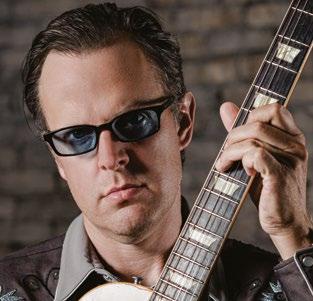
IN THIS MONTH’S column, I’d like to take you through my song “One Last Time,” which I recorded for my most recent album, Electric Truth. And, by the way, thank you very much for voting this album Number Six in GuitarWorld.com’s Top 20 Albums of 2022! What a pleasant surprise! Melodically speaking, the song is deceptively simple, but to me it's all about the articulation and the dynamics of how the melody is played.

FIGURE 1 illustrates the first theme, which is nine bars long. It’s really like a more typical eight-bar form, but I added an extra two beats after bar 4, resulting in an additional bar of 2 4
The song is in the key of Bb minor, which may not be a common key for many guitar players; we’re more accustomed to keys like E, G and A, which is where the dots are! After I recorded the song, I realized that I was drawn to the key of Bb minor because I had been listening to a lot of Chopin, and his first “Nocturne” from “Nocturnes, Op. 9” is in Bb minor. If you love great melody and chord movement, listen to Chopin!
As shown in the pickup bar of FIGURE 1, “One Last time” begins with a phrase that outlines the notes of a Bb minor triad — Bb, Db and F — by utilizing the chromatic approach tone technique of starting one halfstep below each chord tone, followed by the chord tone, played in a descending manner and setting up the start of the melody.

Bar 1 is played over the i (one minor) chord, Bbm, and the melody here is based on the Bb minor pentatonic scale (Bb, Db, Eb, F, Ab). In bar 2, the progression moves to the VI (six major) chord, Gb, followed by the III (three major), Db, which is the relative major chord of Bbm. In this way, there’s a subtle allusion to a modulation from the key of Bb minor to its relative major key, Db. And the notes of Bb minor pentatonic are the same as those of Db major pentatonic (Db, Eb, F, Ab, Bb), so they sit perfectly over both chords.
The next chord, B (technically Cb), is considered the bII (flat-two major) and adds a nice harmonic twist to the progression, followed by the already established Gb. From here, the progression wraps up with a ii - V (two - five) change in Bb minor — Cm7b5F7. Over this last bar of FIGURE 1, the lines
are based appropriately on the Bb harmonic minor scale (Bb, C, Db, Eb, F, Gb, A).
FIGURE 2 illustrates the descending notes of the Bbm triad, and FIGURE 3 includes the aforementioned half-step-below approach tones, or lower neighbors. While writing the song, I contemplated playing the approach tones on the next lower string, as
For video of this lesson, go to guitarworld.com/april2023
shown in FIGURE 4, so that the notes could ring together — offering another way that one could execute this line on the guitar.
FIGURES 5 and 6 show the chord progression in its simplest form. When playing the chords “straight” like this, one can easily imagine how a melody could float over the changes.
LAST MONTH, WE began our look into my song “Pusher,” a track that originally appeared on 2014’s Over Your Head and is also included on my latest release, Live at the Spud. To review, “Pusher” is a funky, syncopated 12-bar blues tune in the key of G, played with a swing-16ths feel and as deep a pocket as we can possibly lay down.
A groove like this is so much fun to solo over because of the syncopated rhythms that are built into it. When I’m listening to the groove of the rhythm section — “ba DUM ba DAH, ba DUM ba DAH” — I’m hearing all of these “holes,” or spaces, in it, with a mindset of how a horn section might drop lines into those spaces, or how a funk rhythm guitar player might add some additional syncopated strums or licks to steer the song in other directions. That type of rhythmic “vibe” is what inspires the type of lines that I’ll play when soloing over the tune's form.
FIGURE 1 illustrates an improvised solo played over this type of progression: I begin with the use of a pickup bar, starting my improvised line two beats before the downbeat of “one” occurs over the I (one) chord, G7, in bar 1. With lines based around the notes of the G Mixolydian mode (G, A, B, C, D, E, F), I’ll add chromatic passing tones in order to both keep the improvised line swinging and in the groove, as well as to set up exactly where on a downbeat or an upbeat I’d like to land on a targeted chord tone.
For example, in the pickup bar, I incorporate chromaticism via a Bb-to-B hammeron followed by a walk-up to F, the b7 (flatted 7th) that falls squarely on the downbeat of “one” in bar 1. I then use chromaticism again, approaching the E note on beat 2 with D and D#. Similar chromatic phrases are used in bar 2 as I set up the change to the IV (four) chord, C7 in bar 3.
In bar 4, on beat 2, I use finger slides and pull-offs between the notes C, Db and Bb, and bar 5 begins with a chromatically ascending dyad — Bb and Db moving up to B and D. In bars 8 and 9, over the C7 resolution back to G7, I include a little nod to the great B.B. King with a line that starts in the “B.B. box” and ends with a “stab” on the high G root note at the 15th fret.
As you play through the remainder of this example, check out the effectiveness of all the little chromatic hammer-ons, pulloffs and slides and how they serve to keep the line flowing as we move through the chord changes.
And, as illustrated in FIGURE 2, I’m moving in and out rhythmically between
For video of this lesson, go to guitarworld.com/april2023
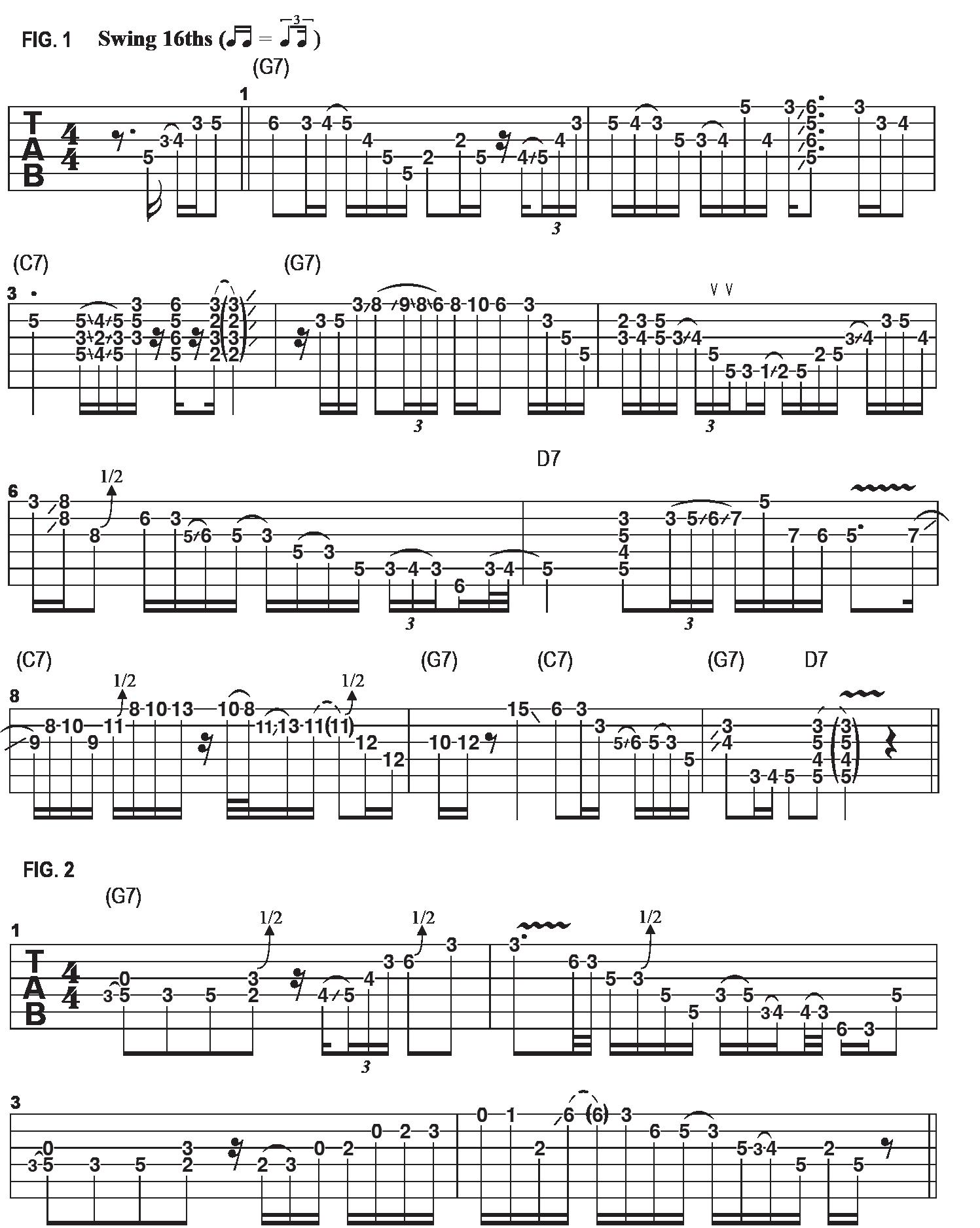
the song’s primary theme and improvised single-note phrases. In my mind, I see every one of those “turns of phrase” as a hook that I’m going to hang something on. When you play with this mindset, the music attains a “conversational” quality, between the theme material and the ebb and flow — the narrative — of your improvisation.
Josh Smith is a highly respected blues-country-jazz master and all-around tone wizard (not to mention an effective instructor). His new album, 2022’s Bird of Passage, is out now. For more info, check out joshsmithguitar.com.
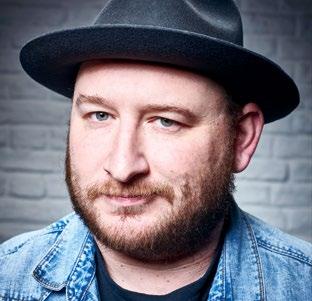
As heard on THE STRANGE CASE OF… Words and Music by DAVE BASSETT and LZZY HALE • Transcribed by JEFF PERRIN



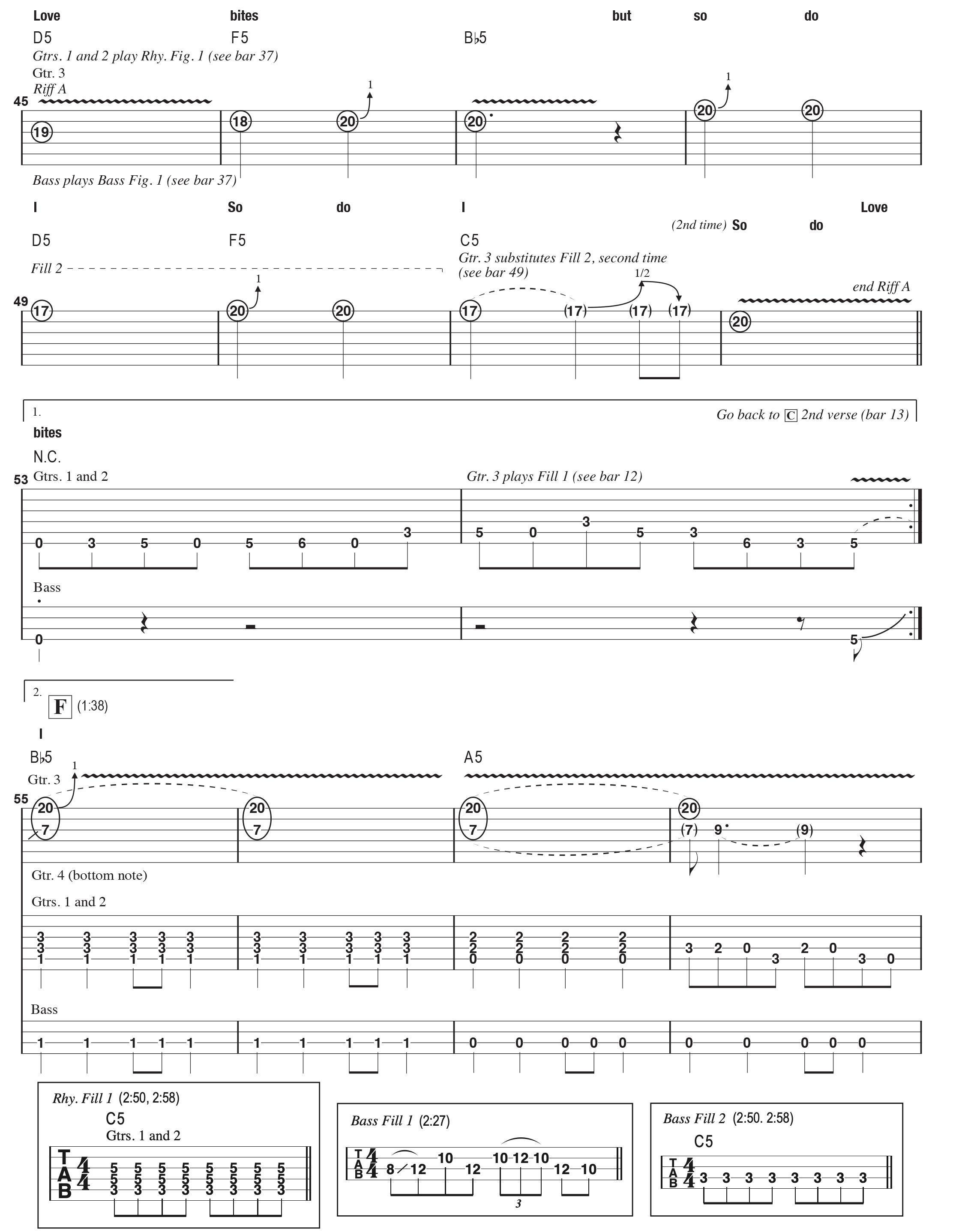
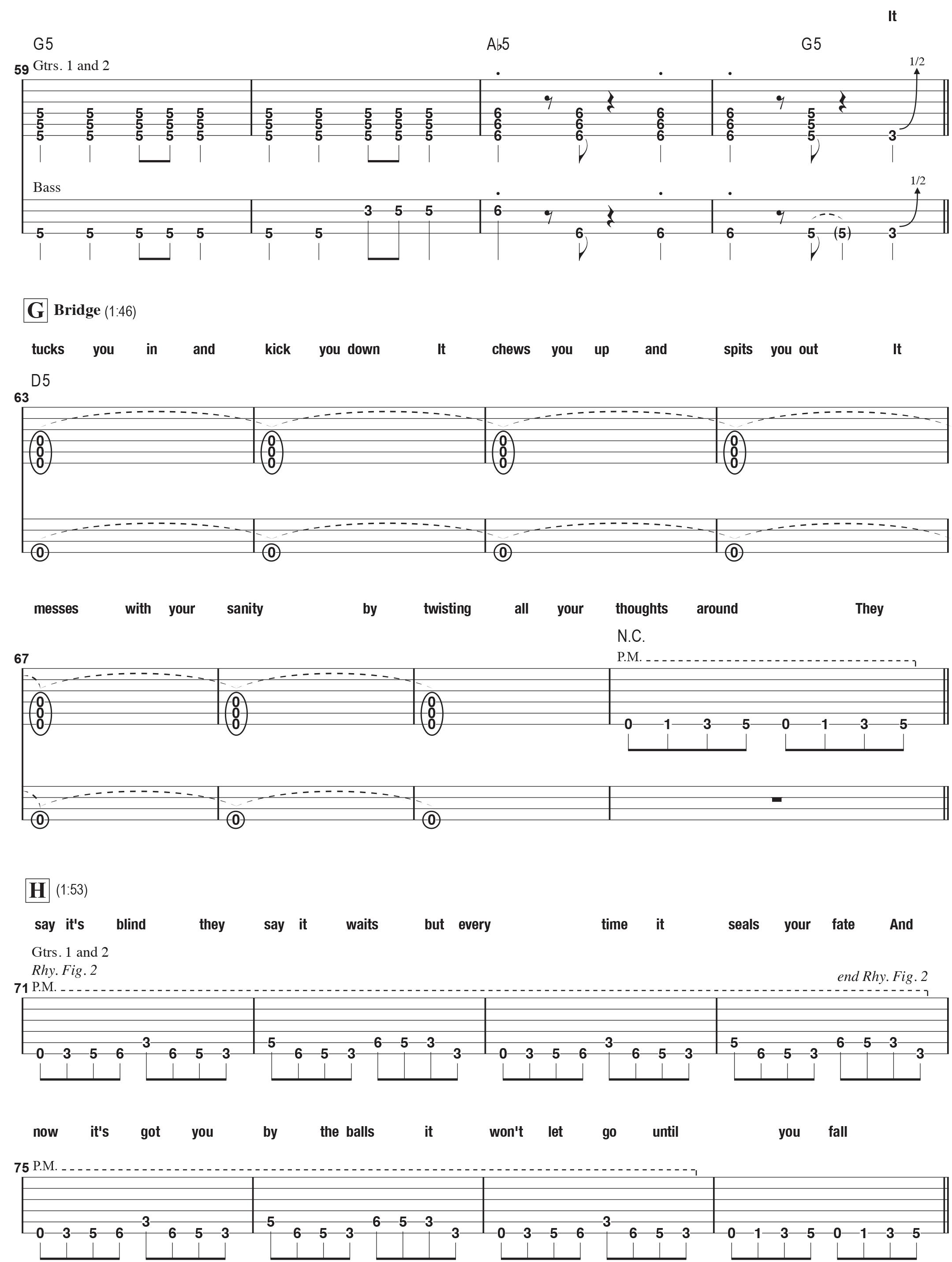
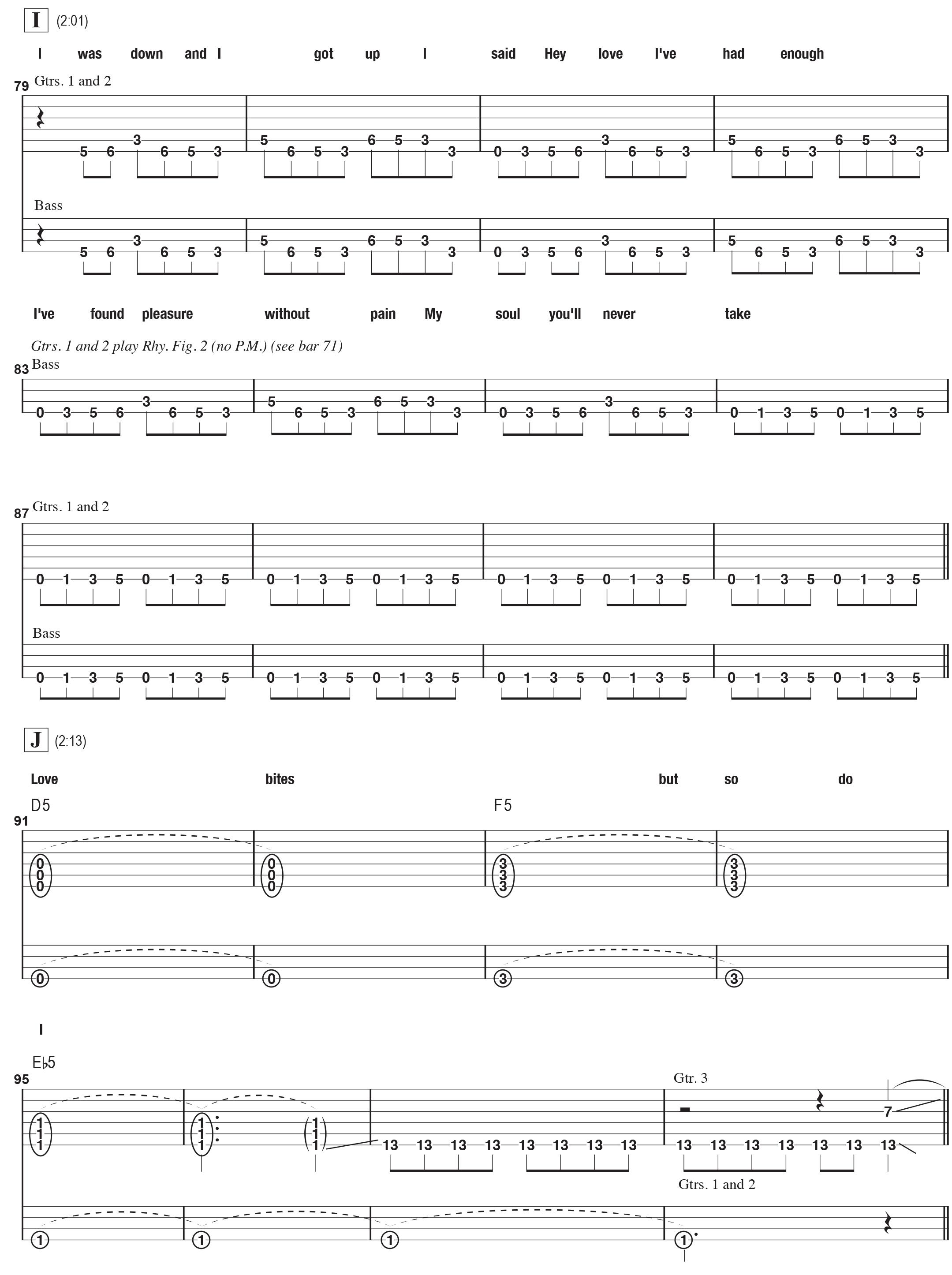

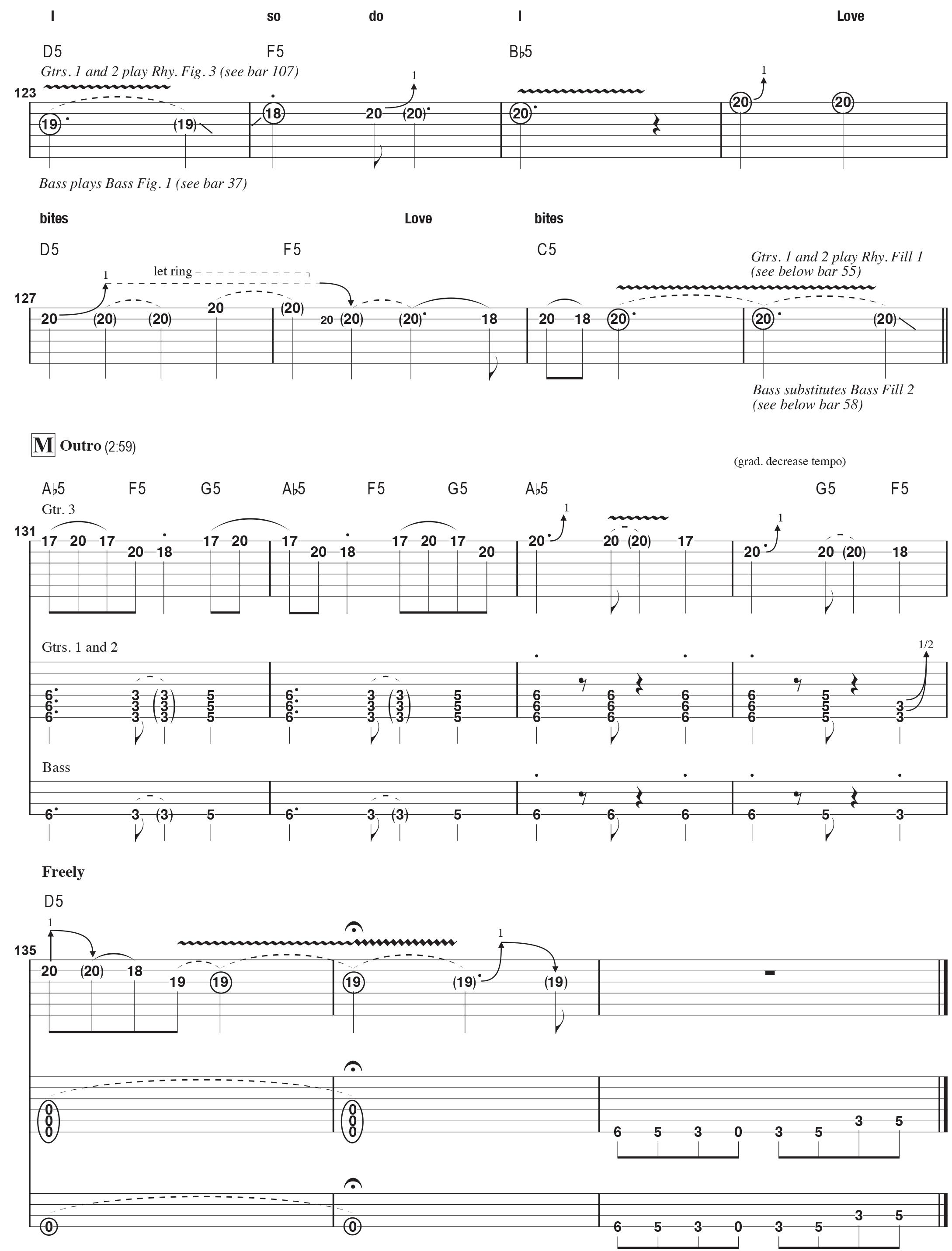
As heard on PHOBIA
Music by BENJAMIN BURNLEY and MARK J. KLEPASK • Transcribed by JEFF PERRIN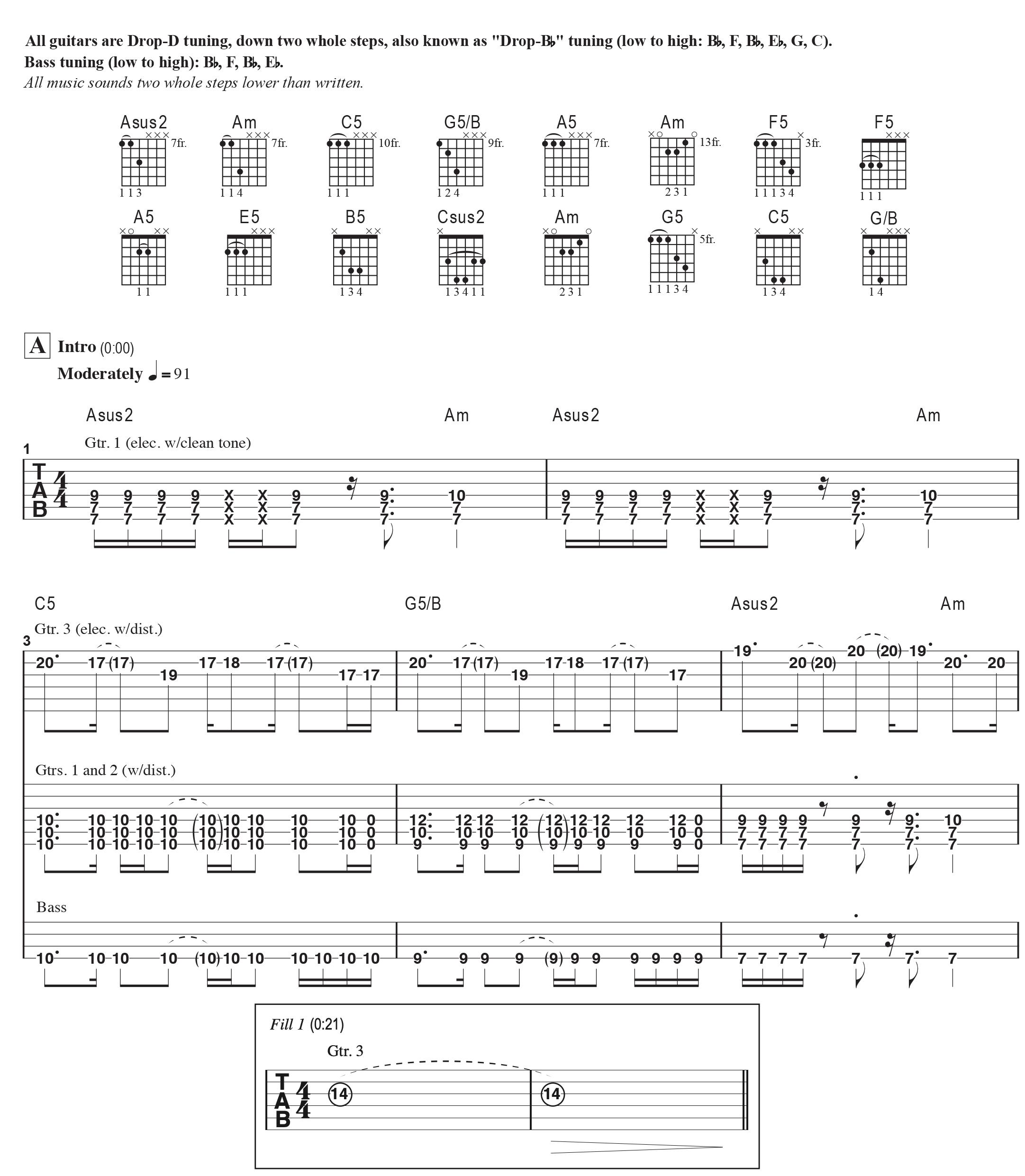

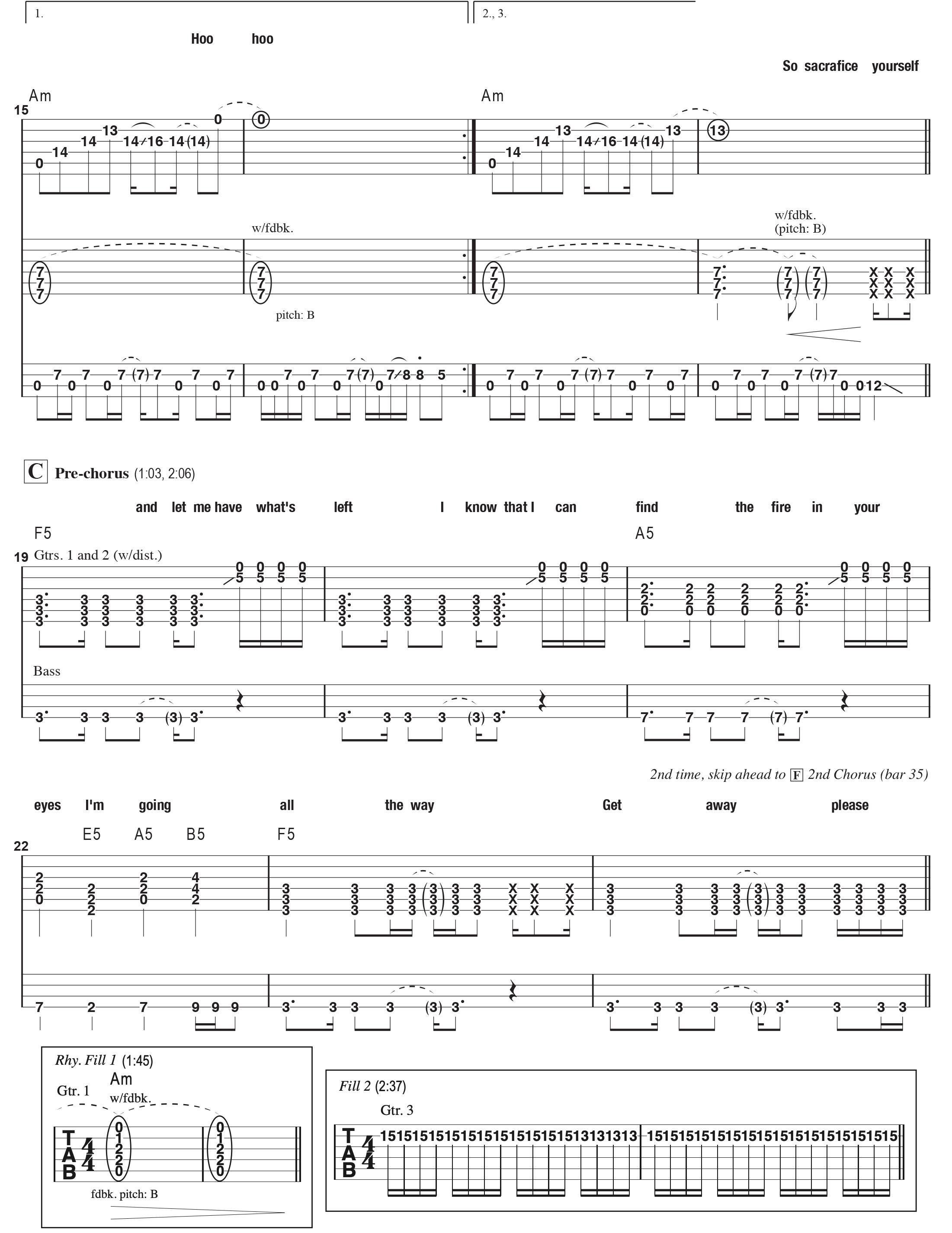


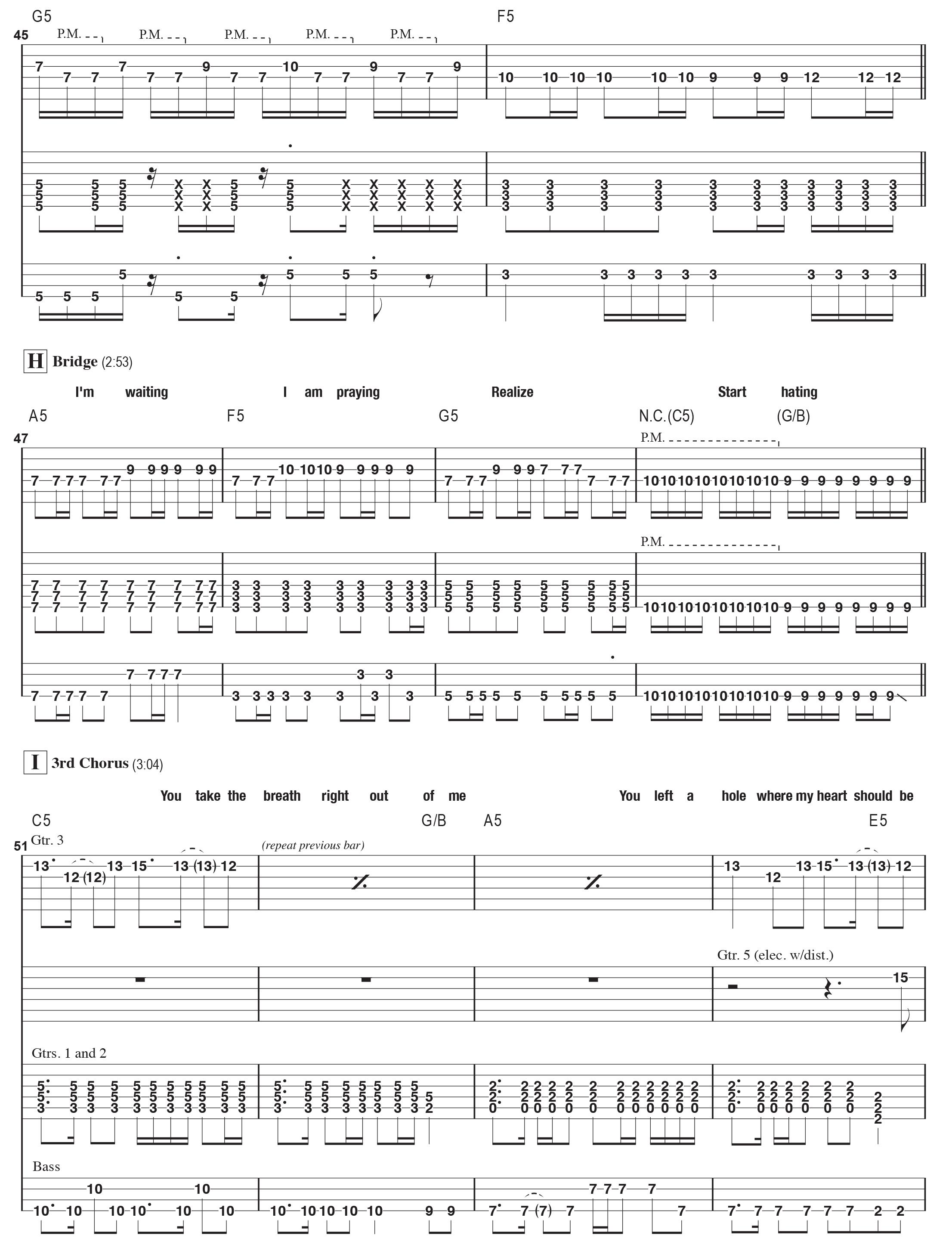
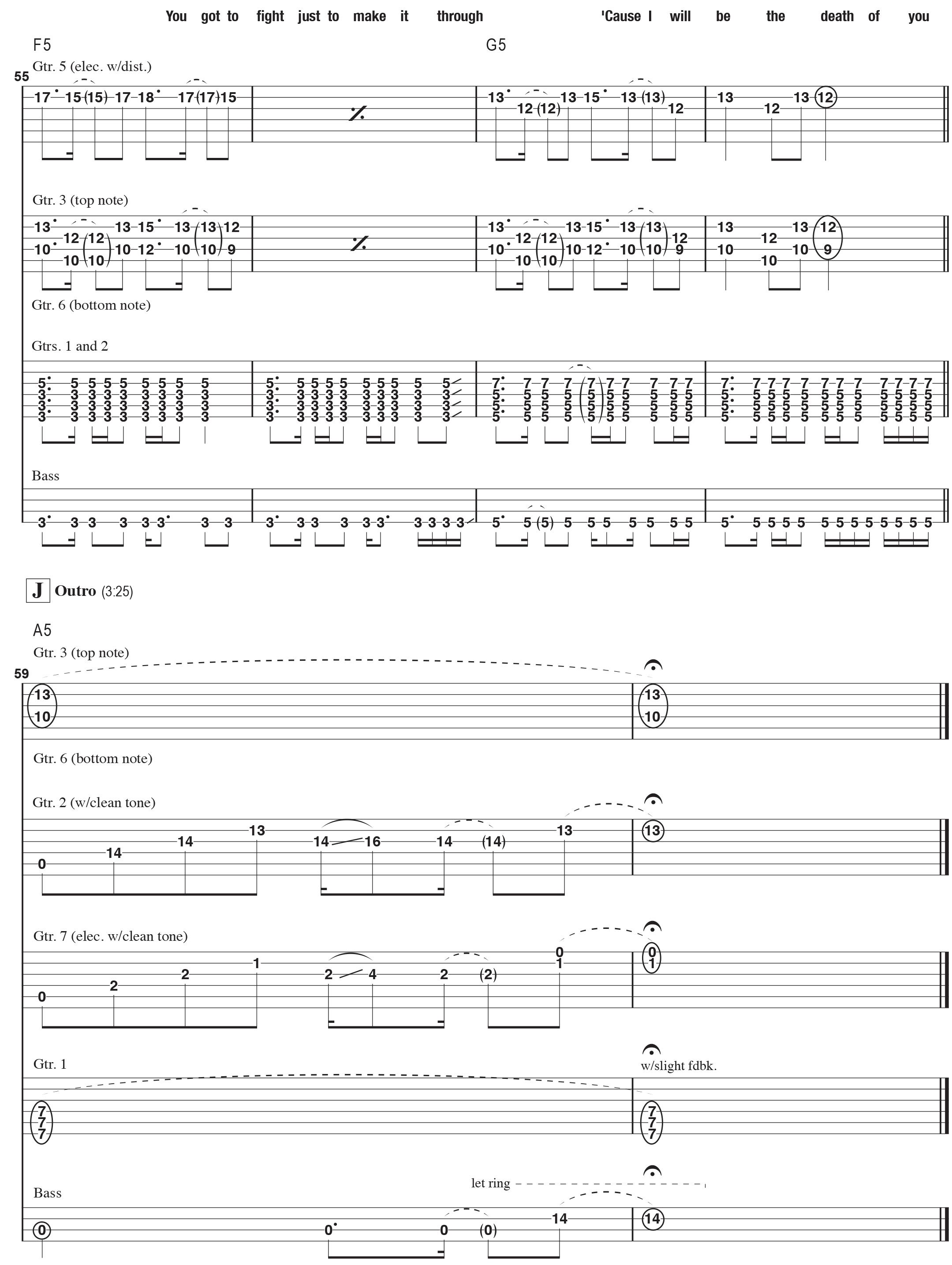
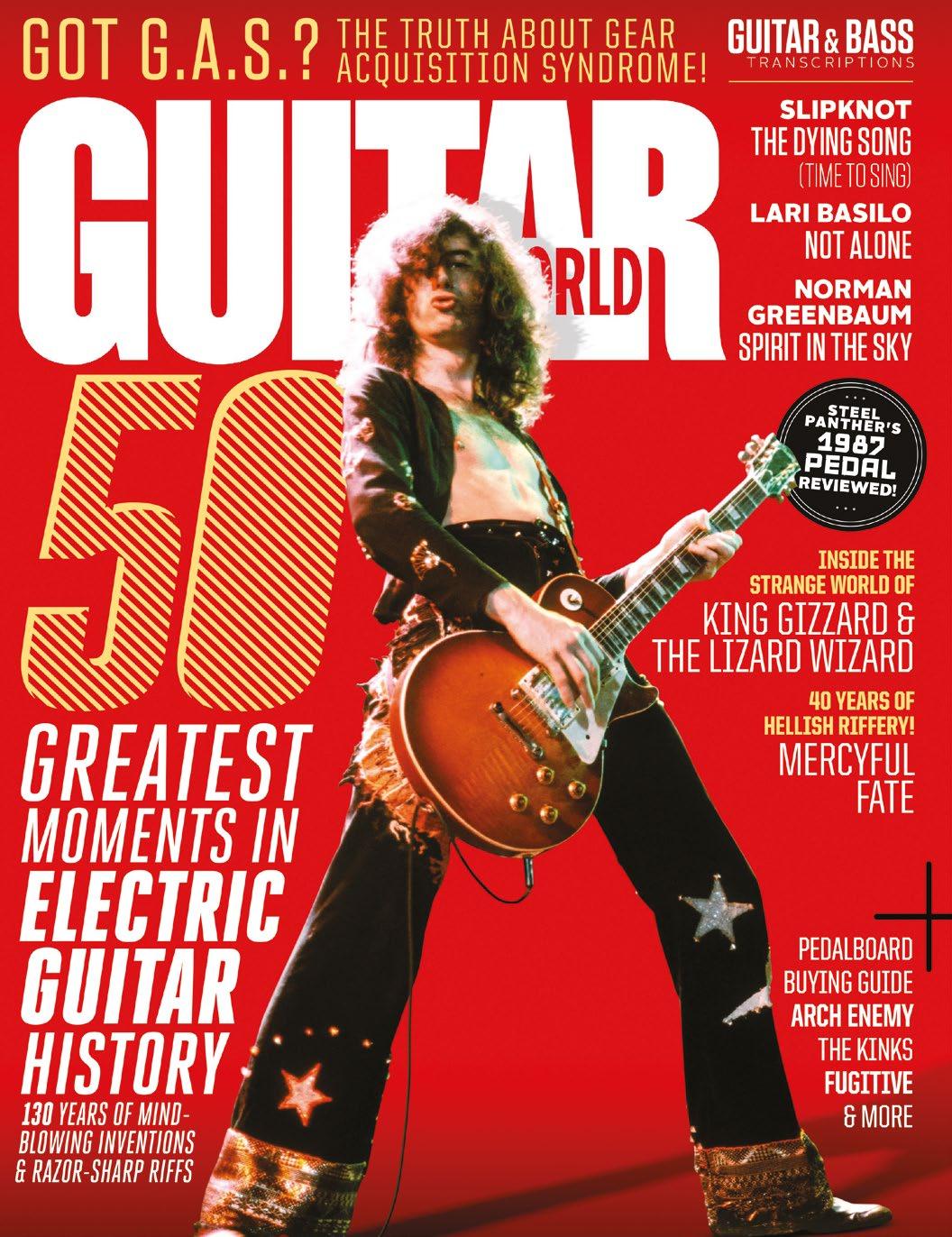



As heard on JANIS JOPLIN’S GREATEST HITS
Words and Music by BERT BERNS and JERRY RAGOVOY • Transcribed by JEFF PERRIN




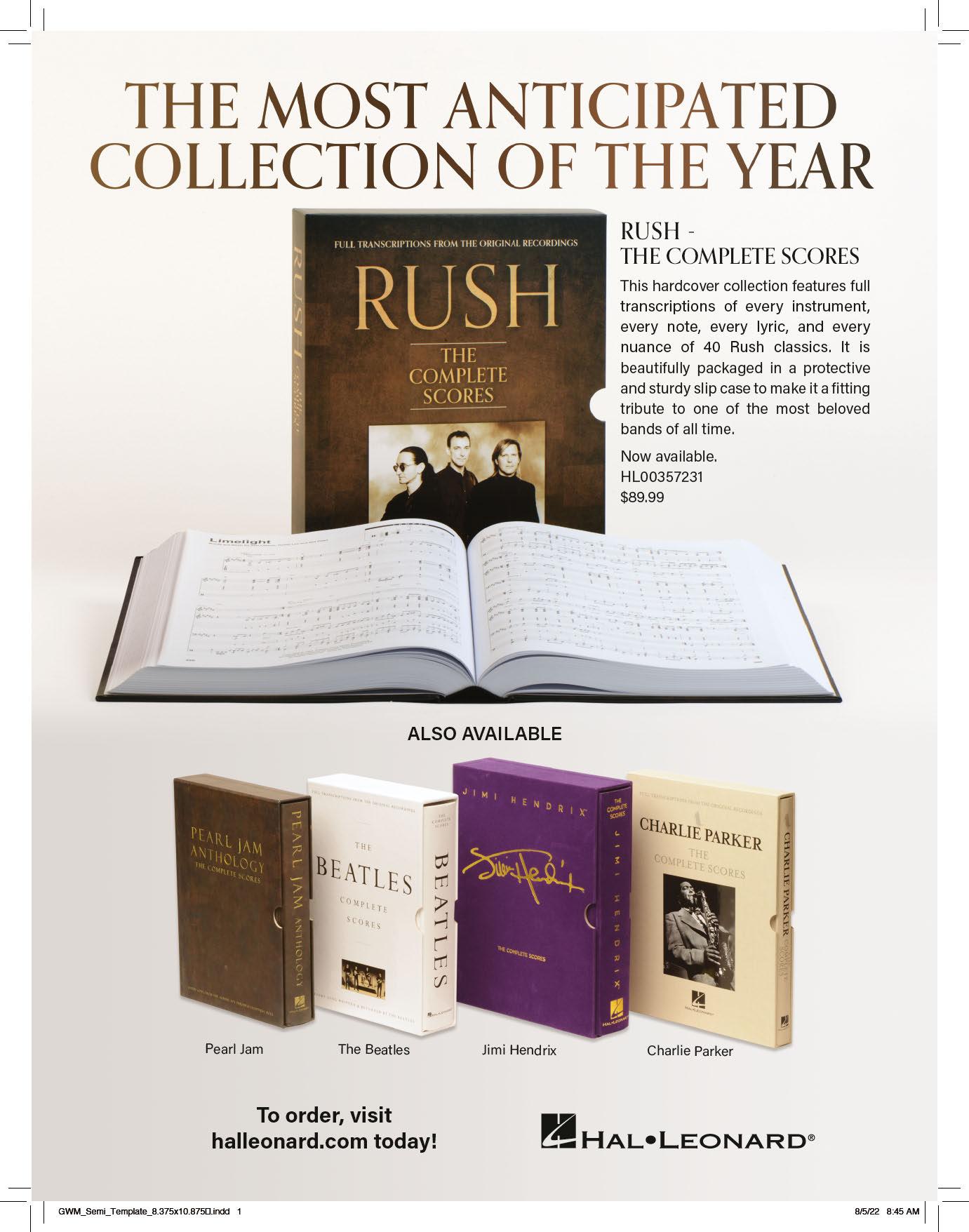



 BY CHRIS GILL
BY CHRIS GILL
INTRODUCED 48 YEARS ago, the Roland JC-120 is by far the most successful and longest-lived solid-state guitar amplifier, which is no mean feat considering the often unjust bias many musicians have had against solid-state amplifiers. The JC-120 remains popular because it occupies a highly useful niche that few, if any, other amplifiers have occupied. Its combination of stellar clean tone with powerful volume output and generous headroom, phenomenal built-in stereo chorus/vibrato effects, highly reliable construction, low-cost maintenance and affordable price have made it a very appealing tool for working musicians throughout the last five decades.

The JC-120’s dual power amp design that provides 120 watts of output and a pair of high-fidelity 12-inch speakers deliver clean tone that hits all the marks: tight, powerful bass, prominent, well-defined mids and crisp, chime-like treble, along with the ability to remain distortion-free even with all of the controls maxed. The amp sounds great on its own, but it’s also an ideal “blank canvas” for players who use a lot of different pedals. In fact, Boss engineers use a JC-120 as a primary platform for calibrating the tone of Boss pedals. The JC-120’s wide frequency range also allows it to function like a mini self-contained sound system that works exceptionally well with guitar synthesizers and modern modeling processors like the Fractal Audio AxeFX or Kemper Profiler.
Perhaps the most appealing feature for many players is the JC-120’s signature stereo chorus effect. The JC-120’s chorus effect was truly revolutionary when Roland introduced the amp in 1975. The world’s first chorus pedal — the Boss CE-1 Chorus Ensemble — is essentially the JC-120’s chorus/vibrato section housed in a pedal format. Although the JC-120’s chorus/vibrato circuit has been modified over the years due to discontinued components, it still remains one of the best chorus effects out there. Part of this is due to the three-dimensional sensation created by splitting the dry signal to one of the JC-120’s 12-inch speakers while the wet signal goes to the other speaker.
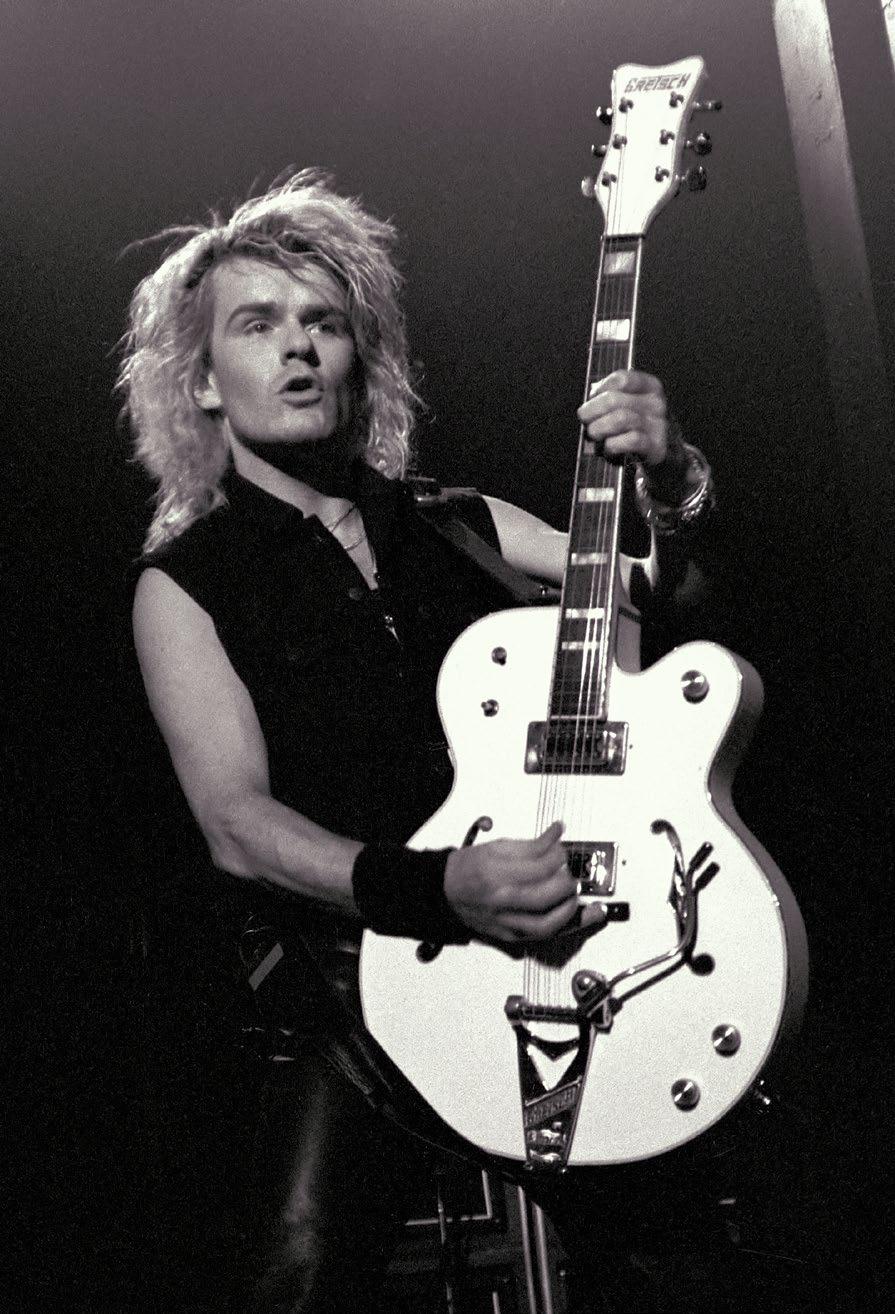
Channel 2, Low input, Brilliance: On, Volume: 8, Treble: 3, Middle: 7, Bass: 6, Distortion: Off, Reverb: 0, Speed: 4, Depth: 5, Chorus setting
Channel 1, High input, Brilliance: Off, Volume: 9, Treble: 5, Middle: 8, Bass: 3
The JC-120 has helped numerous players create memorable signature tones over the years. Adrian Belew used a JC-120 to craft distinctive distortion tones using a variety of funky fuzz pedals, and to generate outrageous feedback effects while manually tweaking its chorus and vibrato effects. The characteristic chime of Billy Duffy’s Gretsch White Falcon on the Cult’s “She Sells Sanctuary” comes courtesy of the JC-120’s chorus along with a slew of other modulation and delay effects, and Alex Lifeson recorded the JC-120’s chorus effects
on Rush albums from A Farewell to Kings and Hemispheres through latter-day efforts like Snakes & Arrows. Andy Summers used a JC-120 onstage with the Police to amplify his guitar synths, and a JC-120 provided the clean yin to the yang of the walls of Marshalls and Mesa/Boogies for Metallica’s high-gain metal chunk and crunch.
The JC-120 was even the first choice amp of blues legend Albert King from the late Seventies onwards for its incredible punch and power.
Last year, Roland celebrated the company’s 50th anniversary by offering the JC-120 Jazz Chorus Roland 50th Anniversary Limited Edition model. Roland is producing only 350 of these very special tribute amplifiers, which feature a cherry wood veneer enclosure, distinctive dark gray grill cloth, commemorative badge and handengraved serial number. It’s a fitting tribute both to the longevity of the Roland company and its most enduring product.

